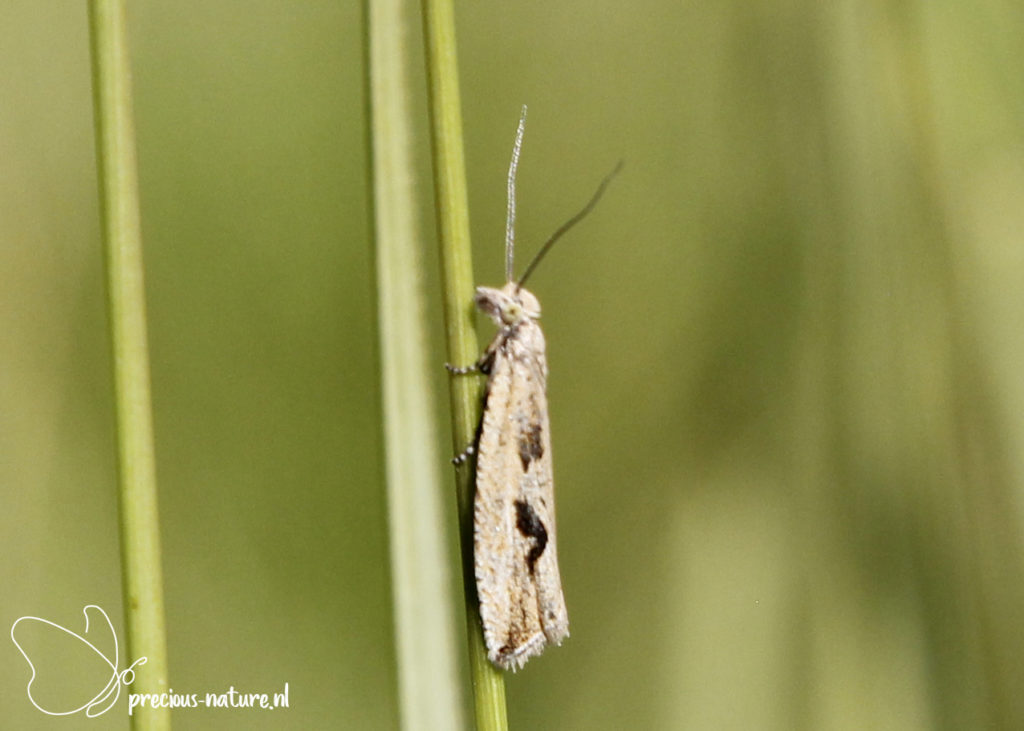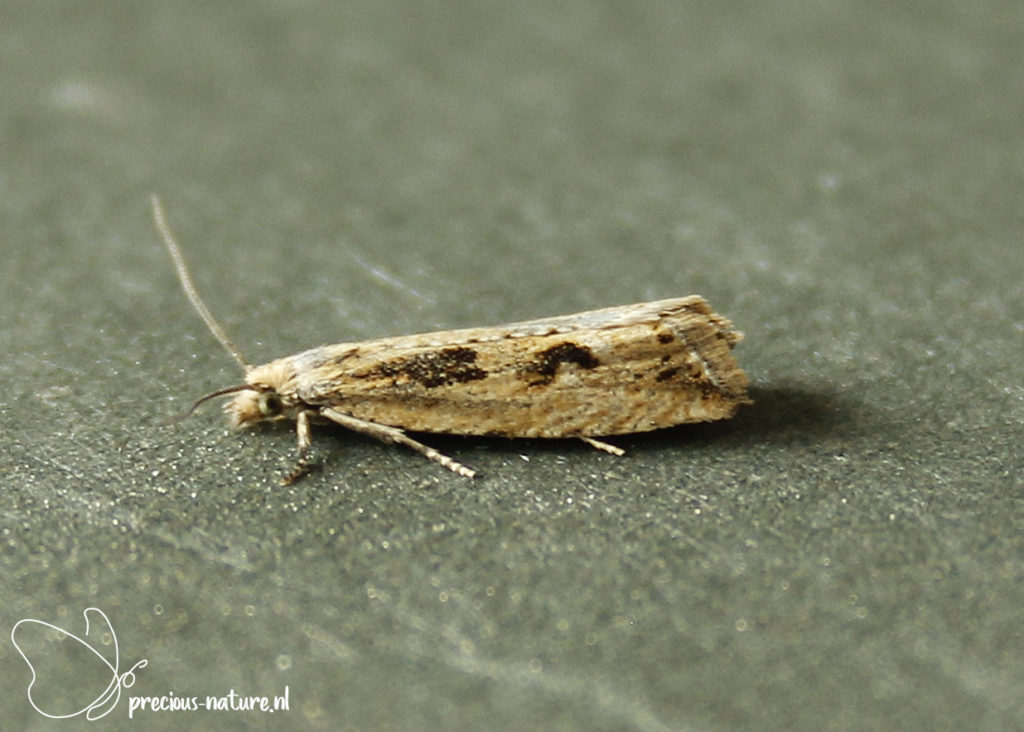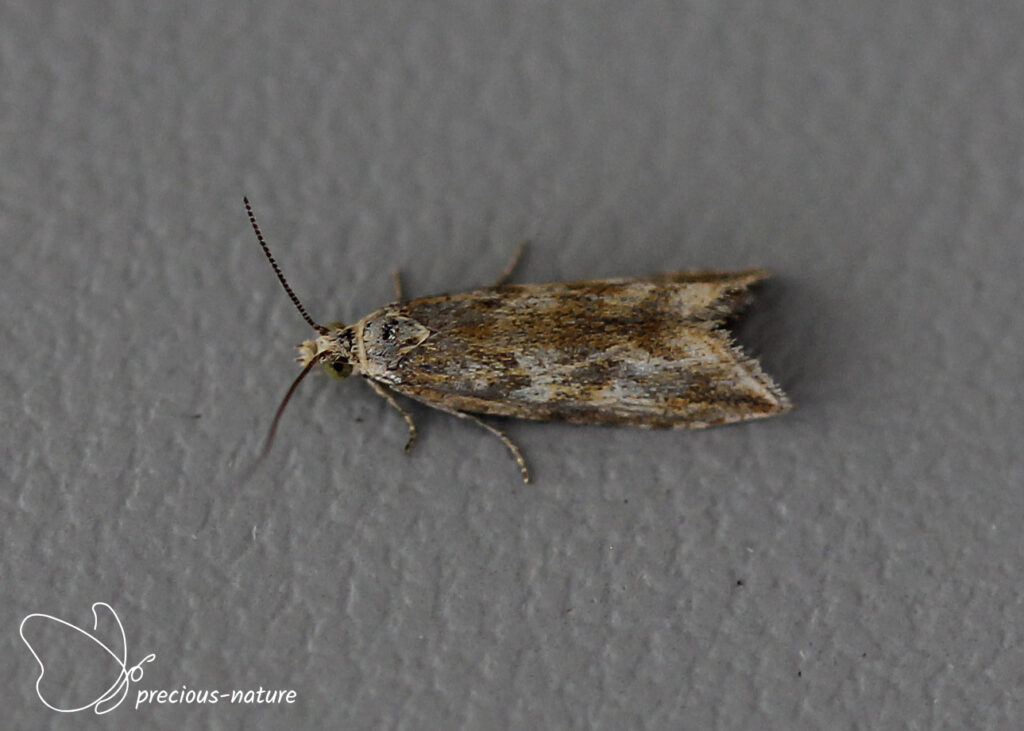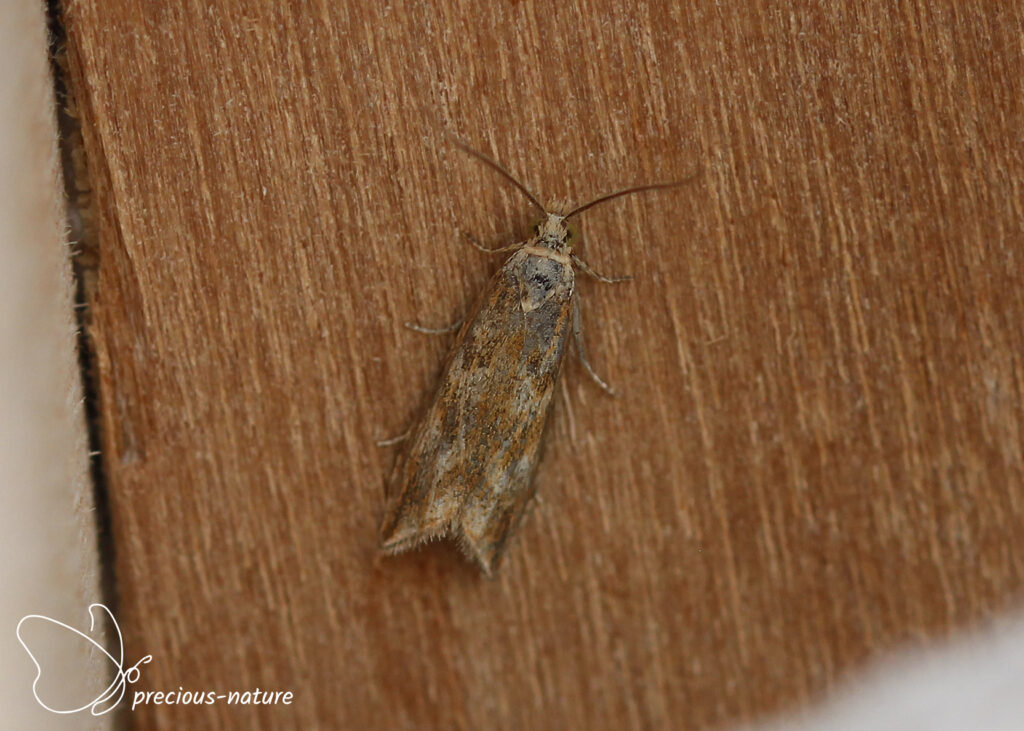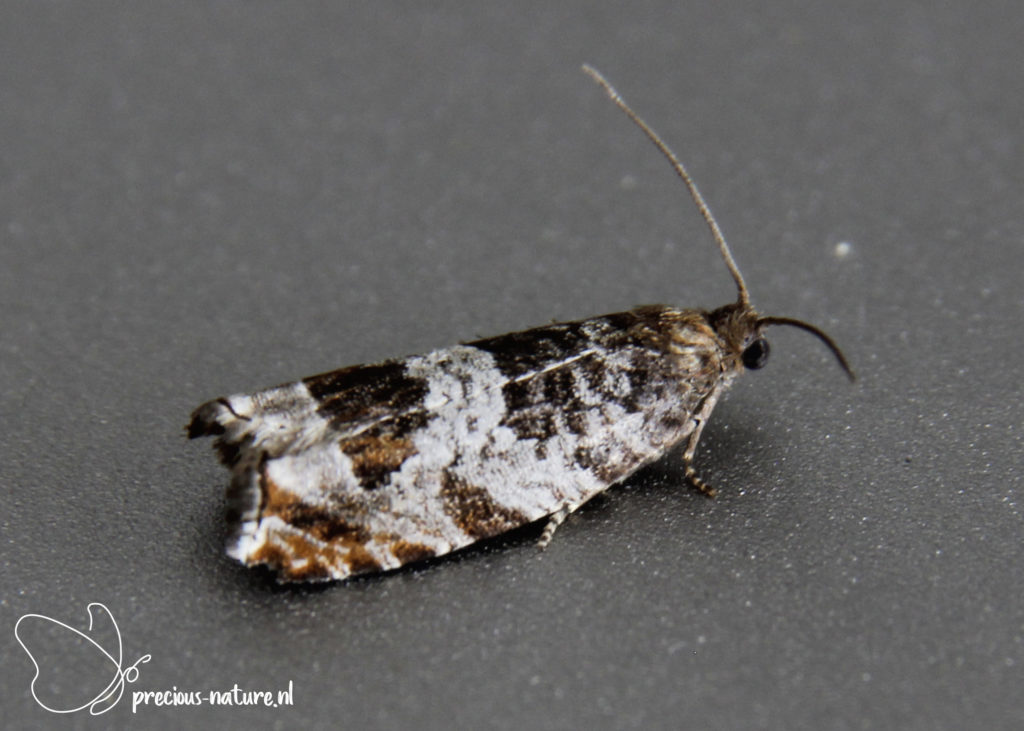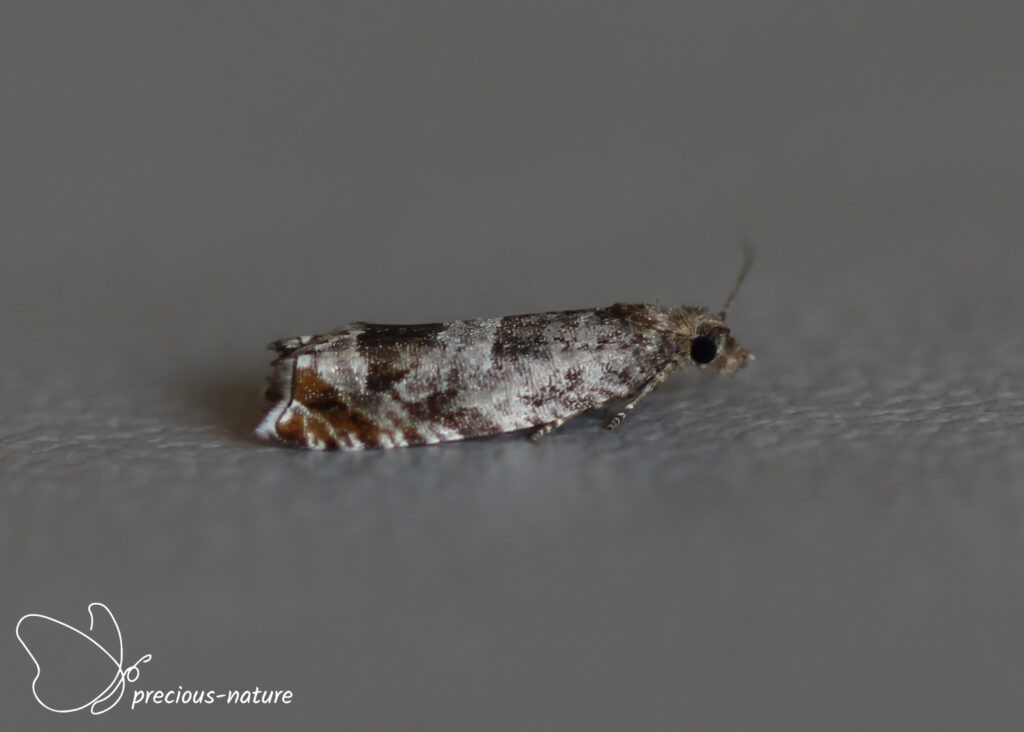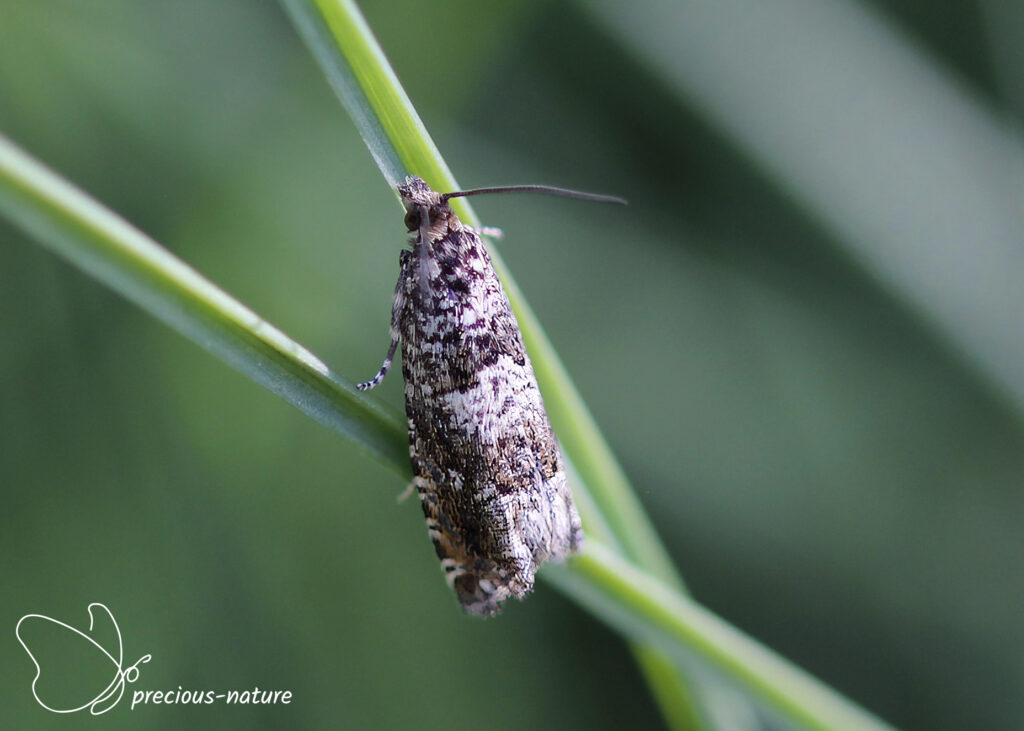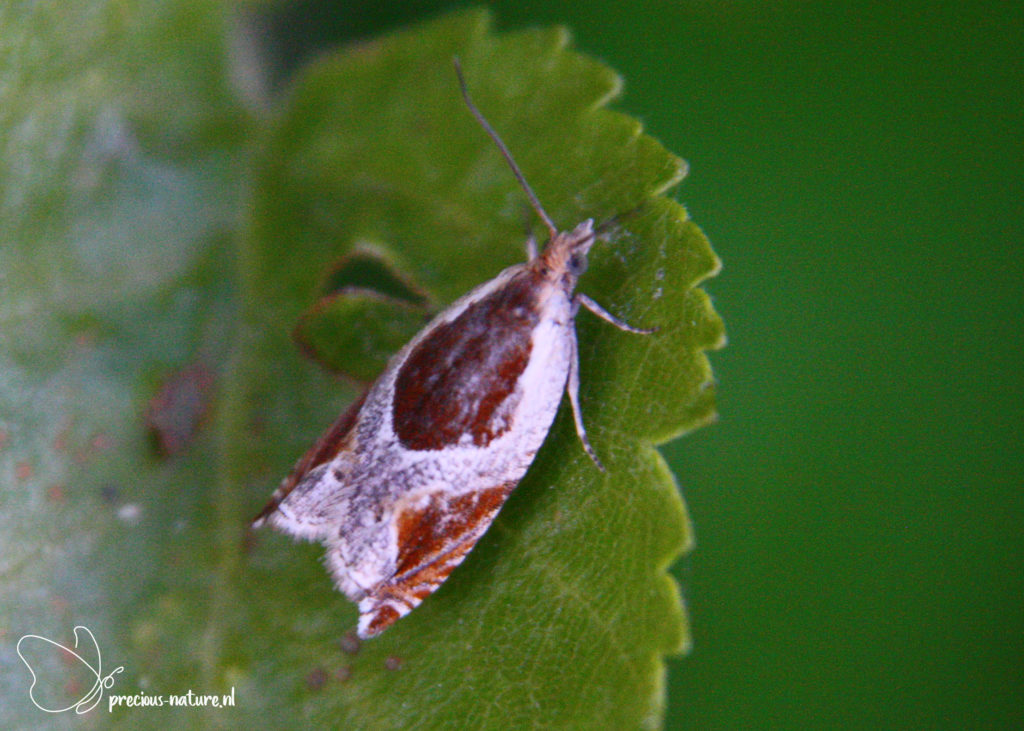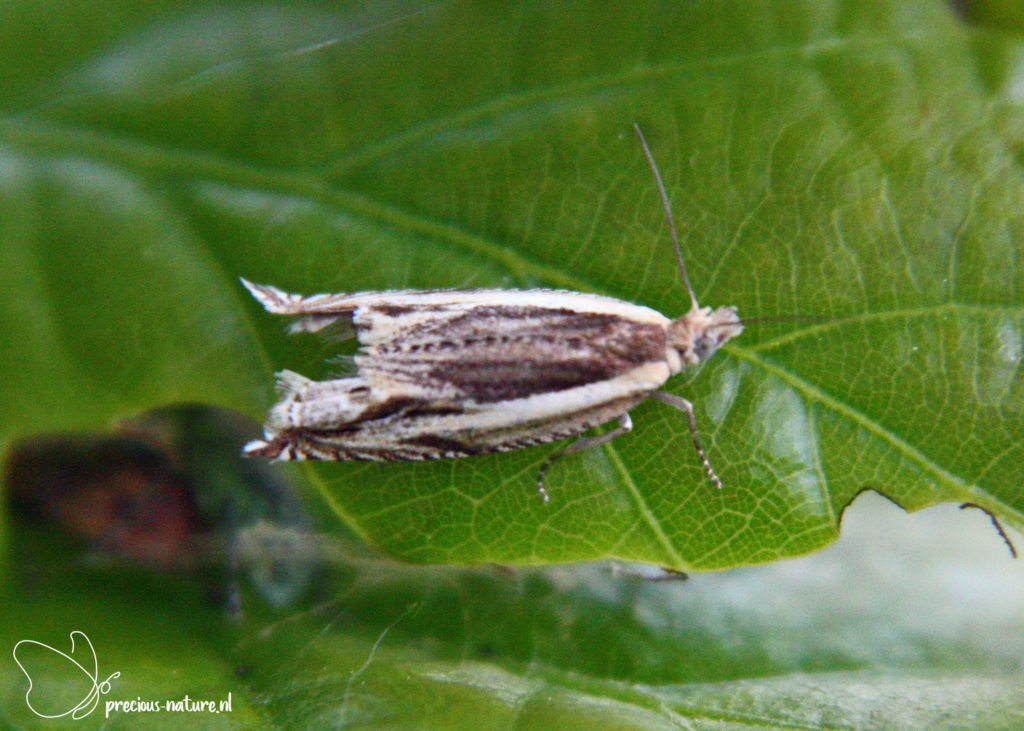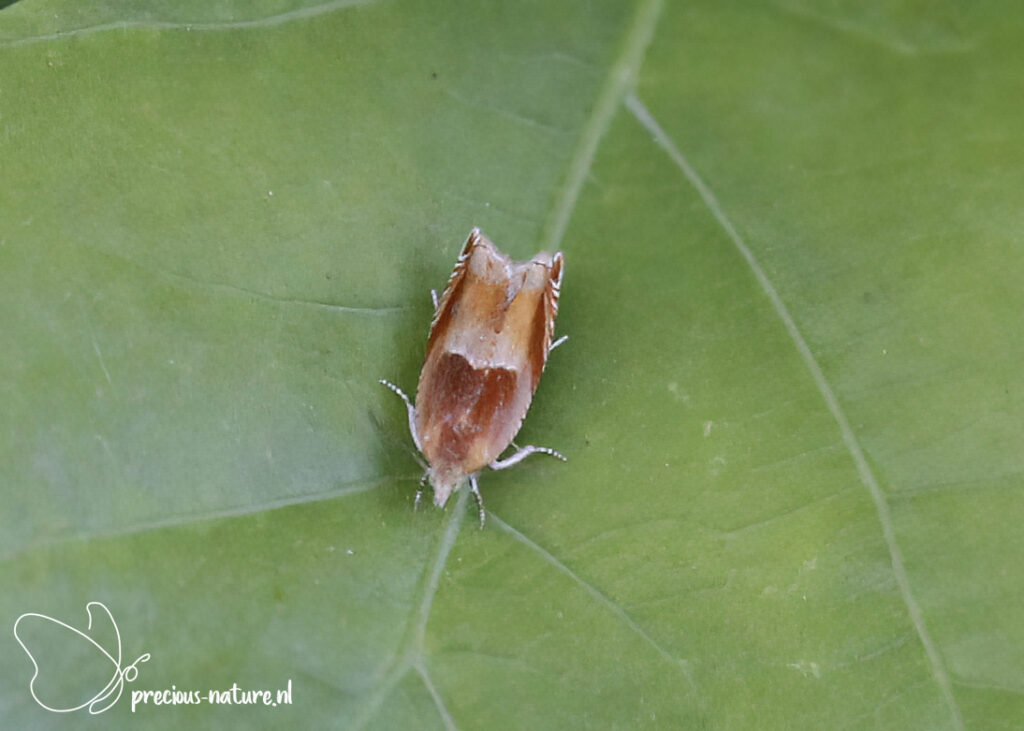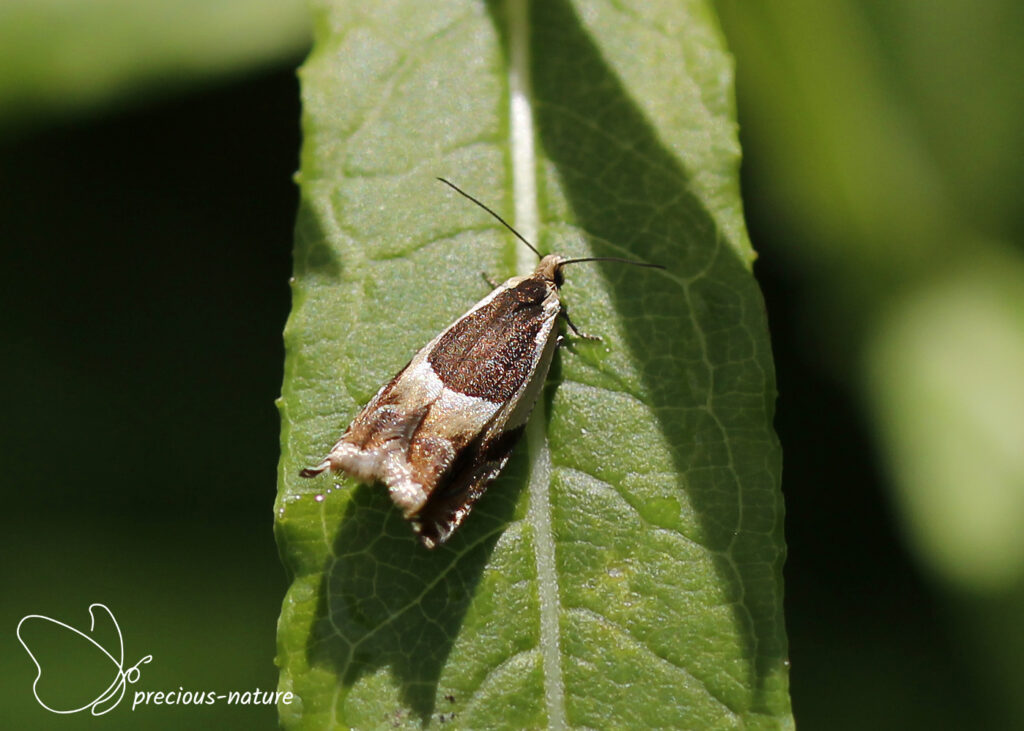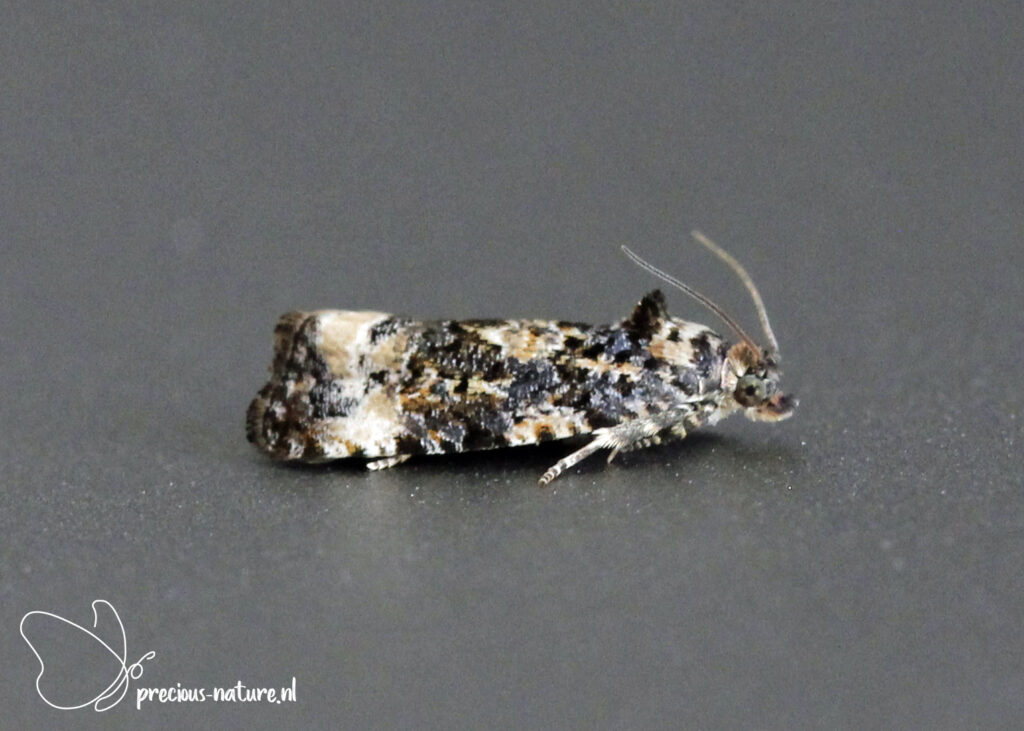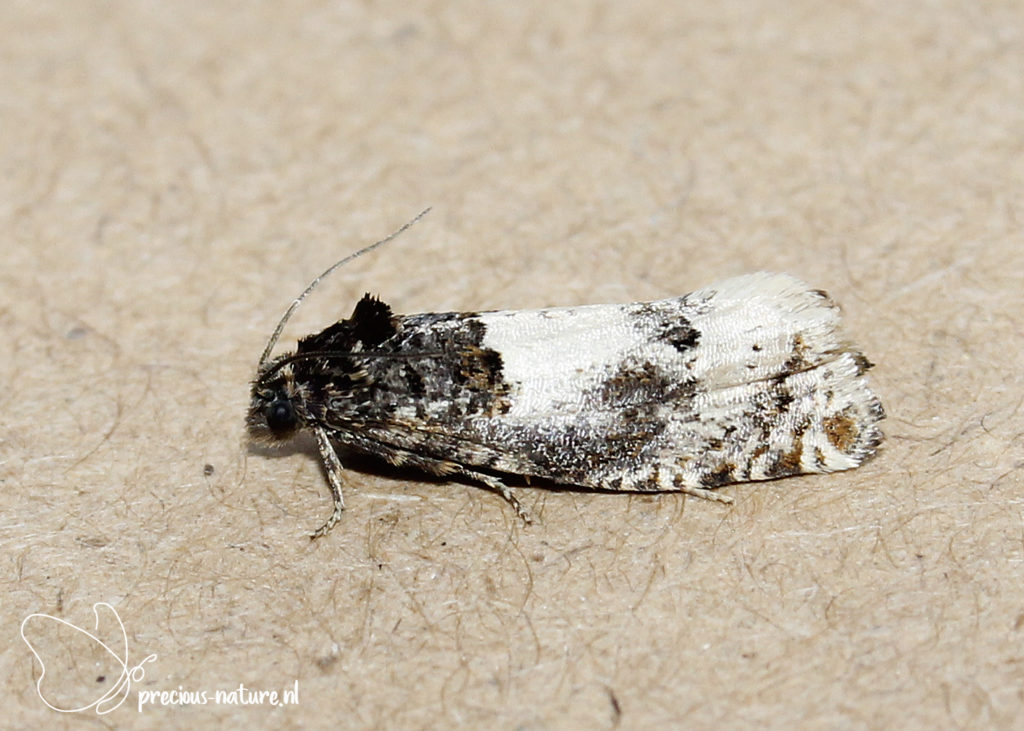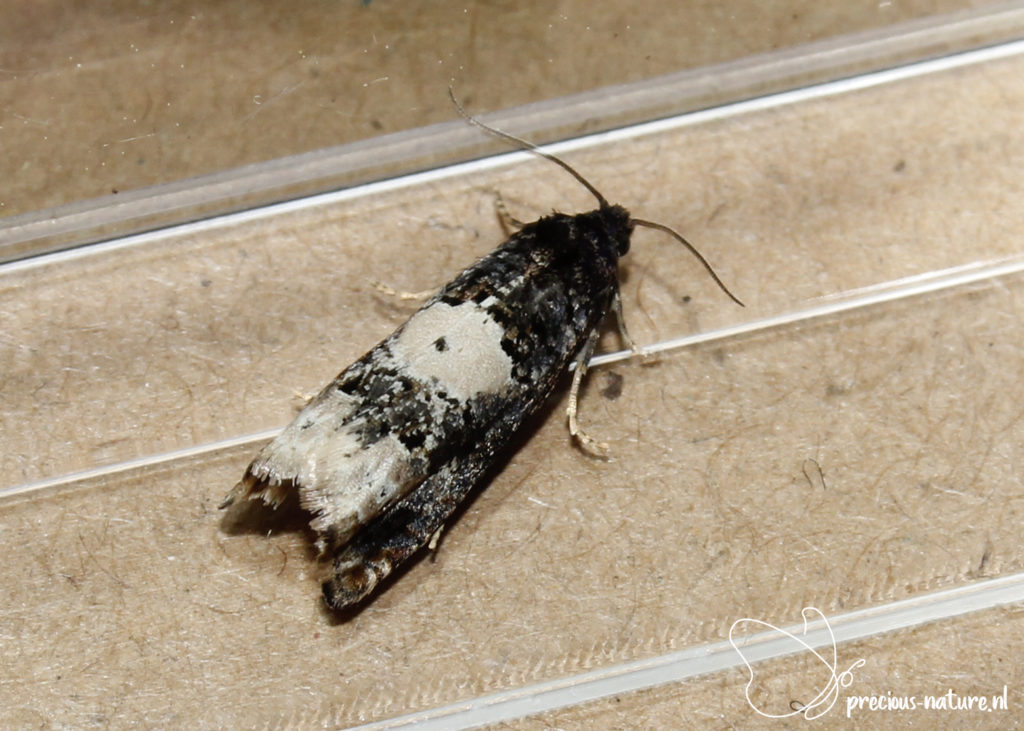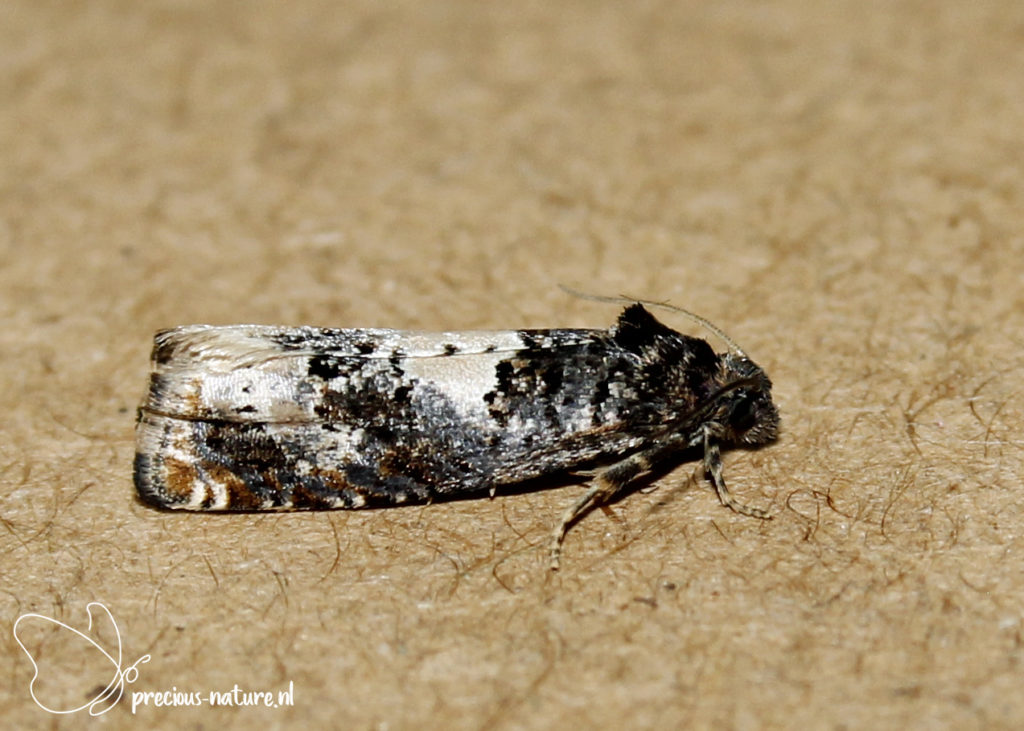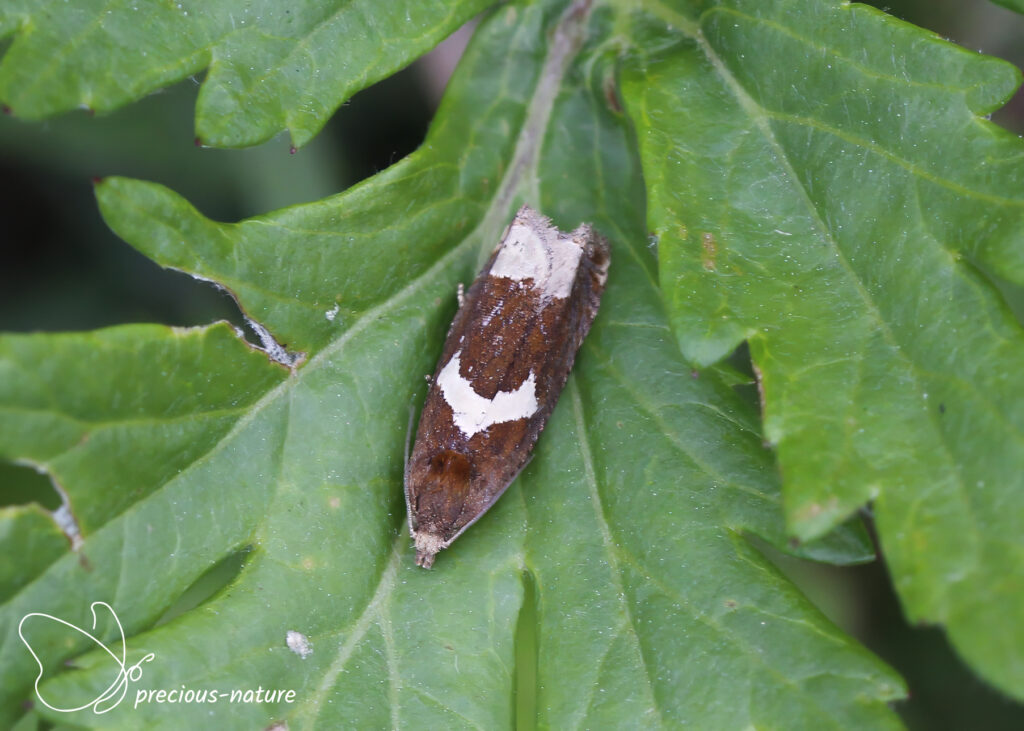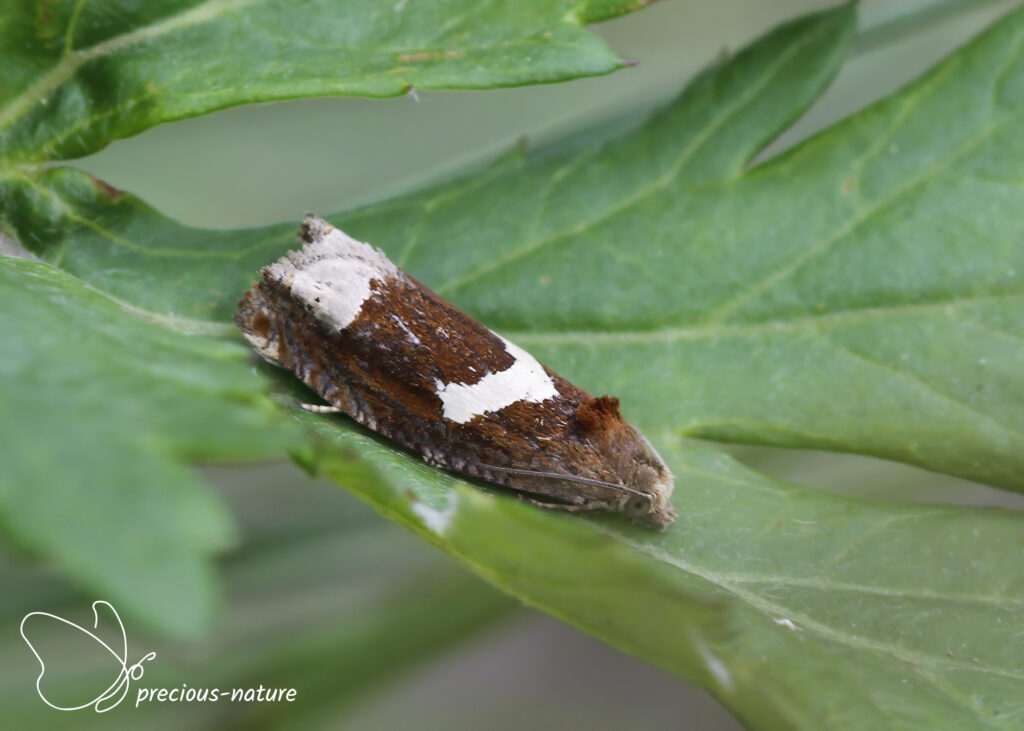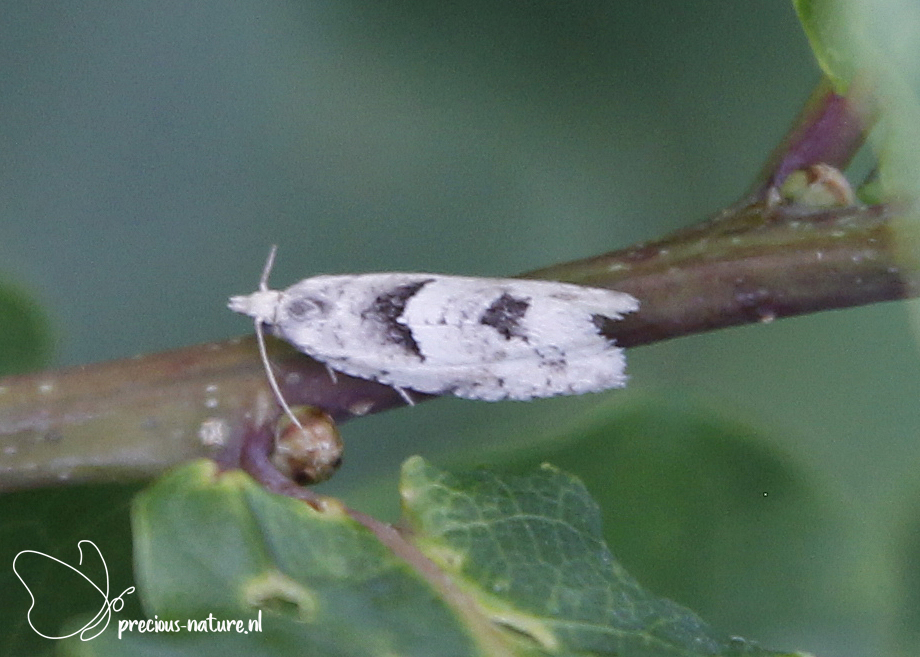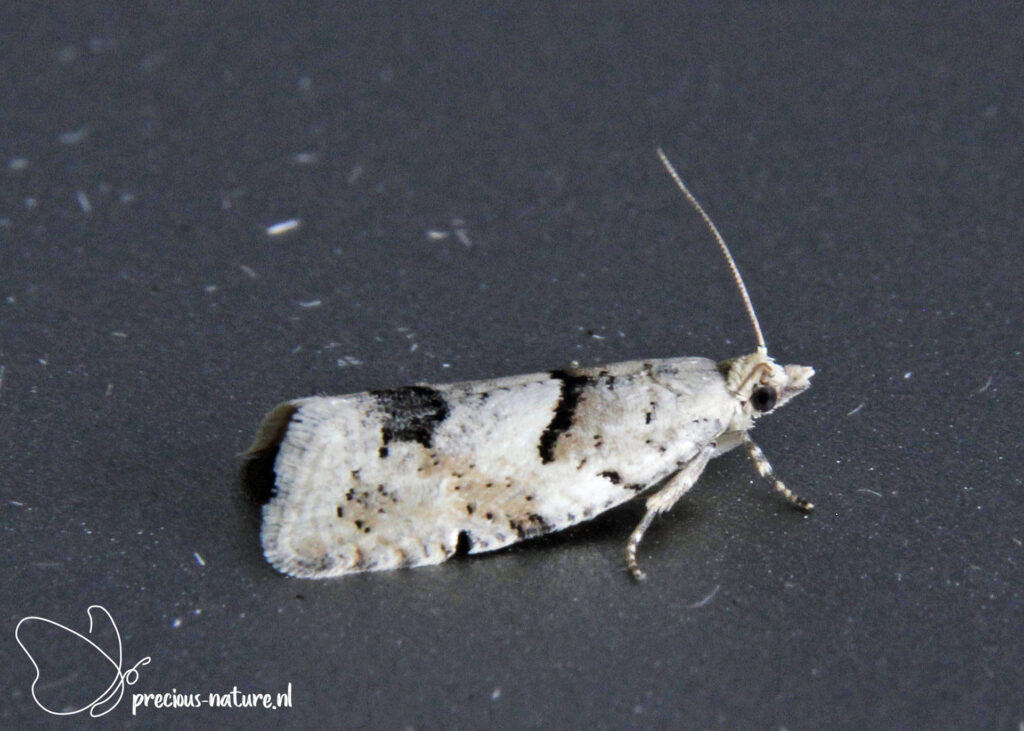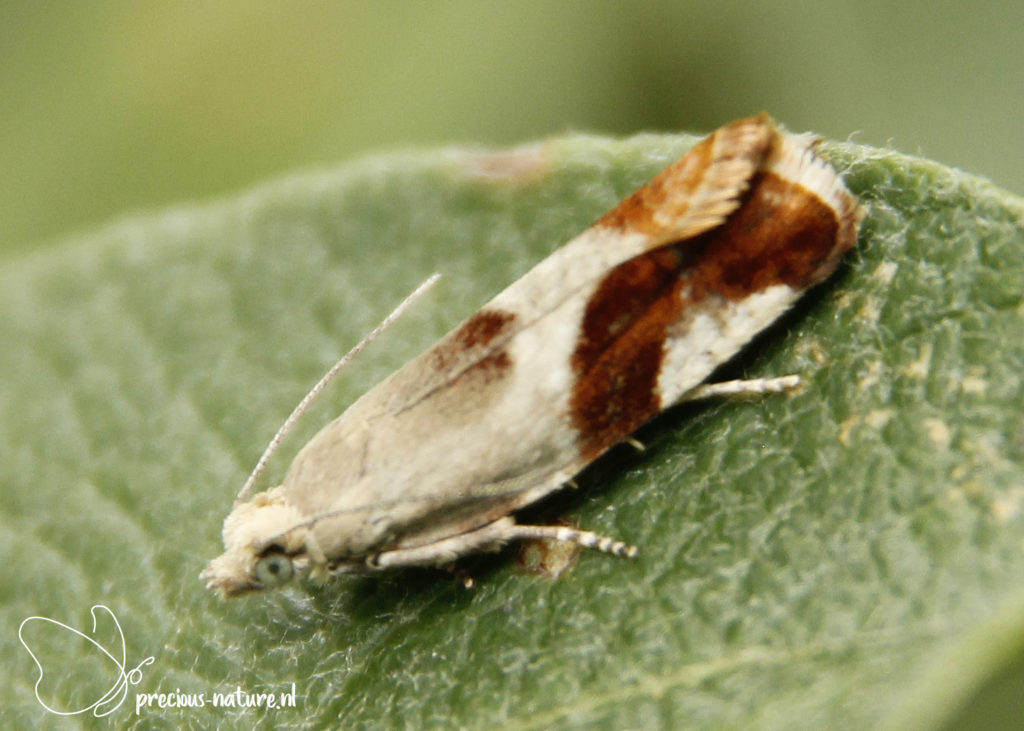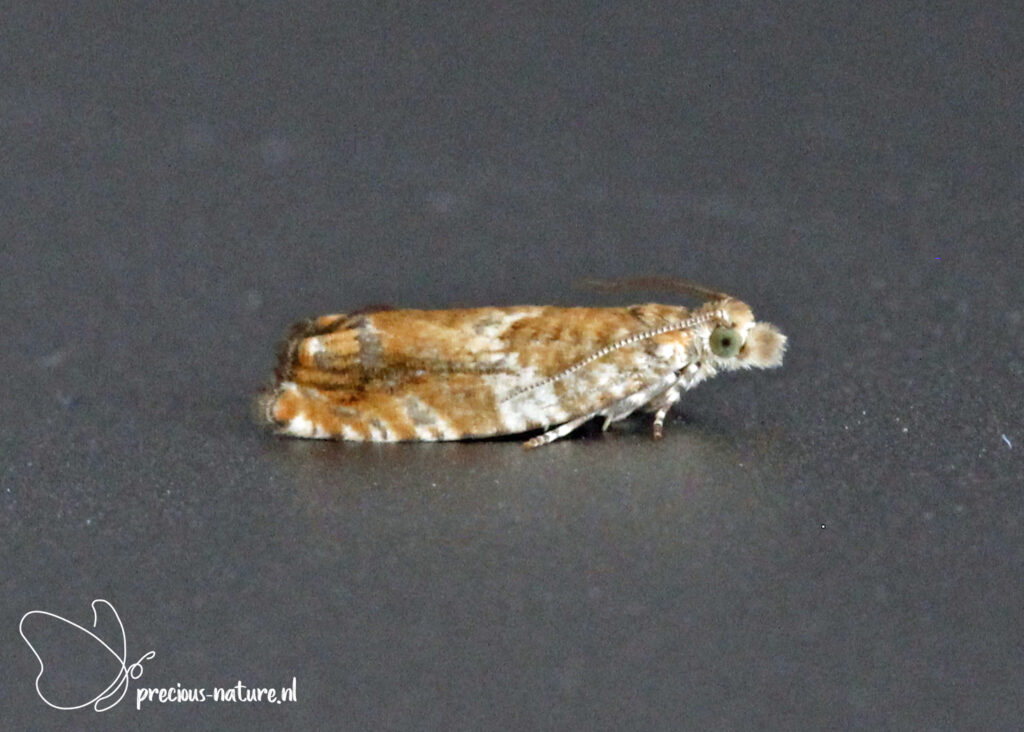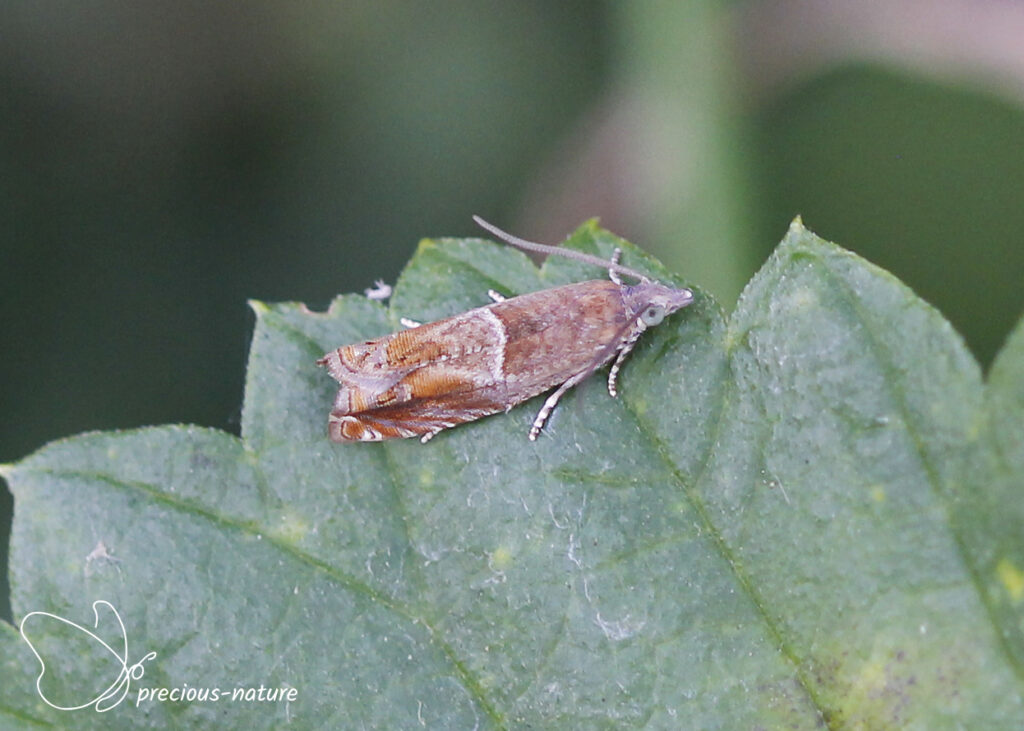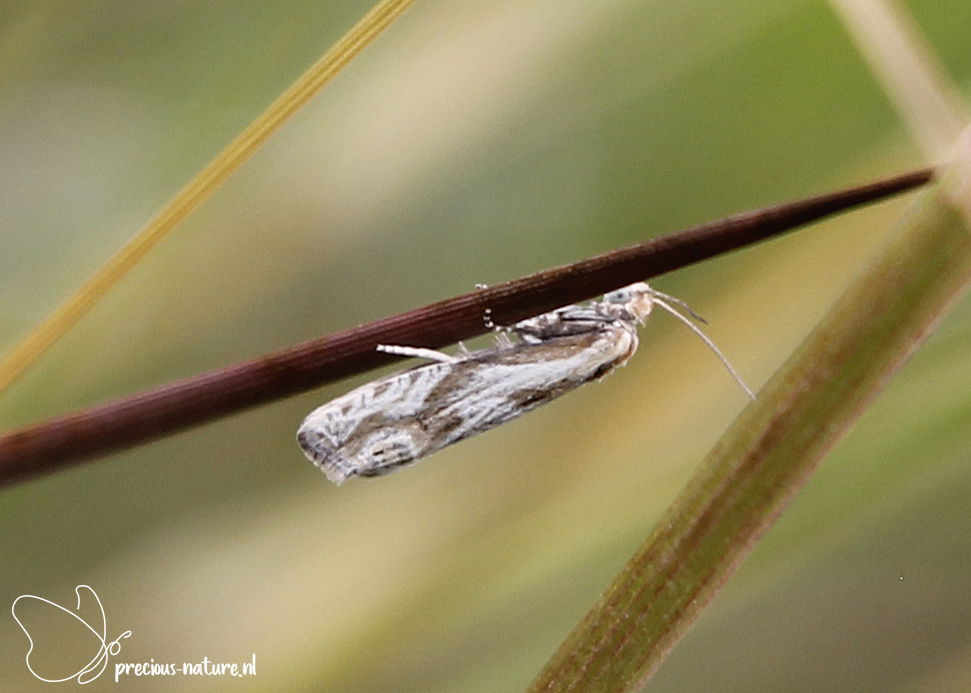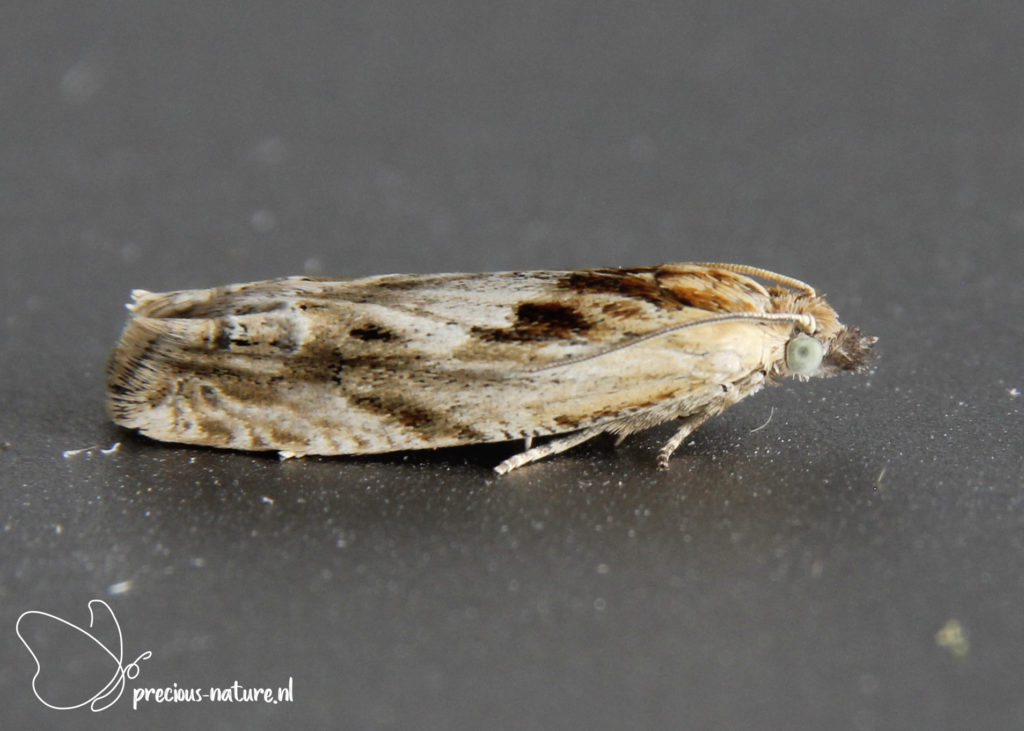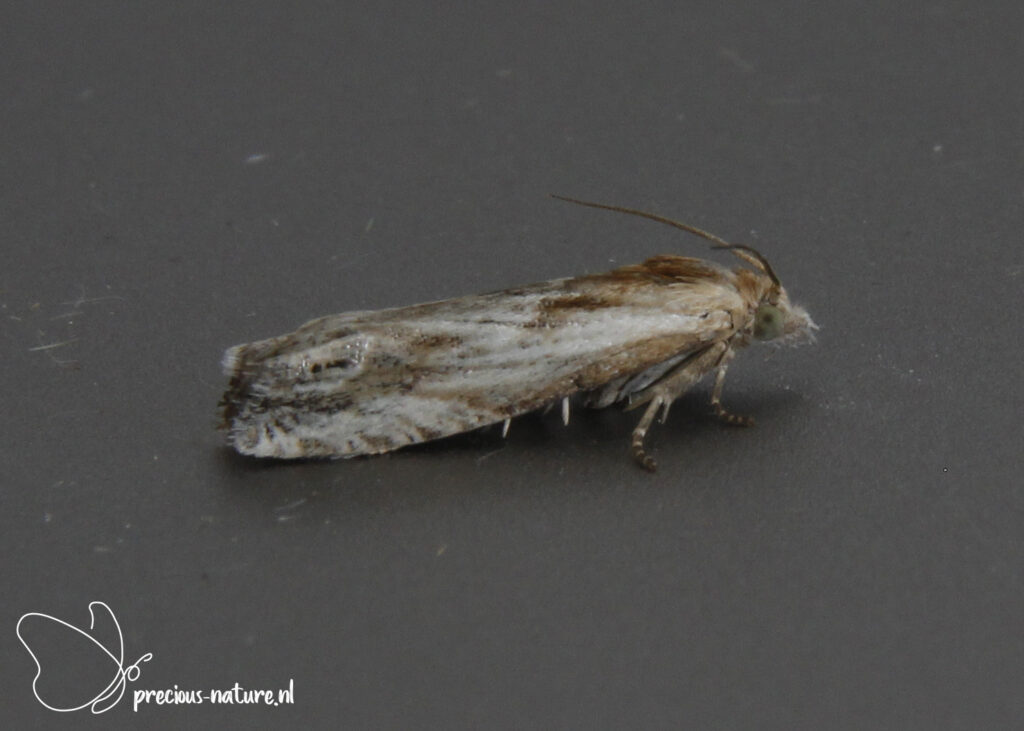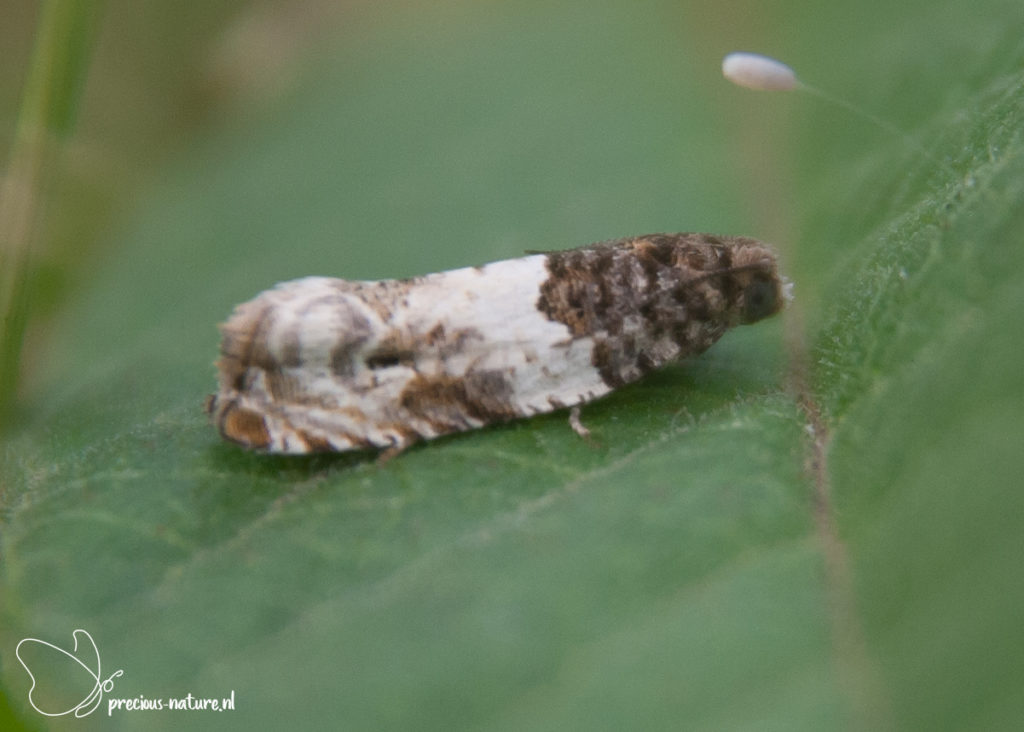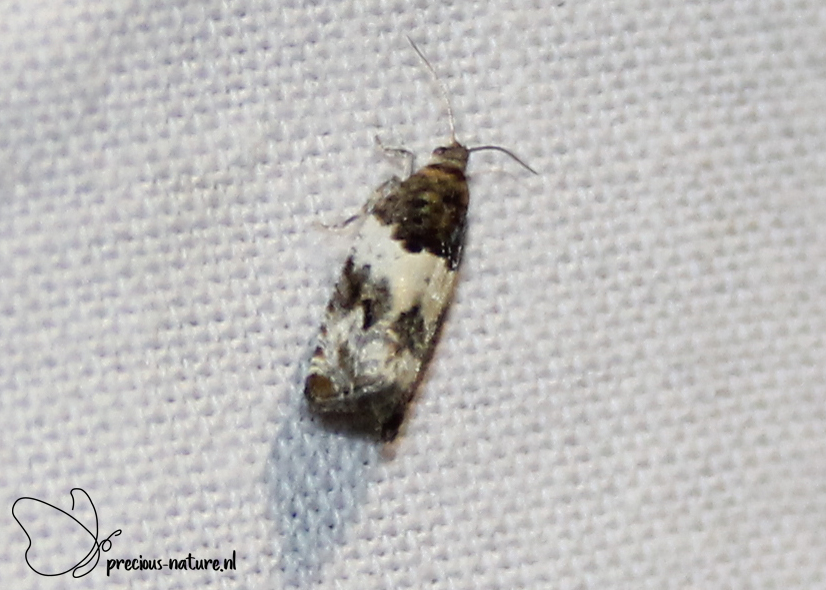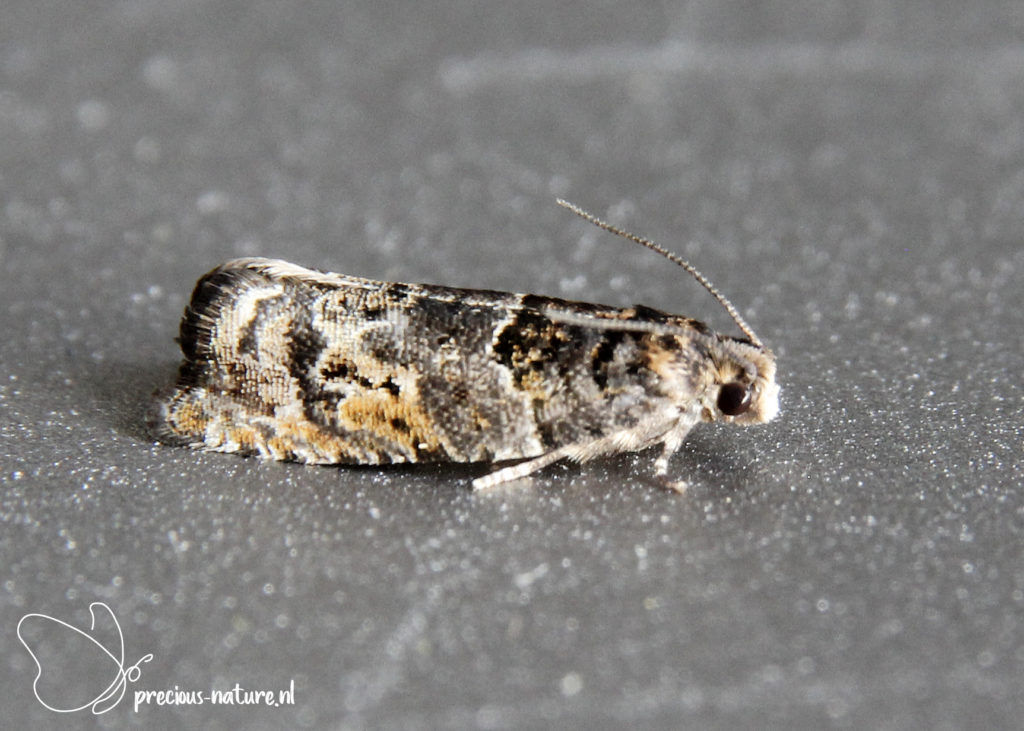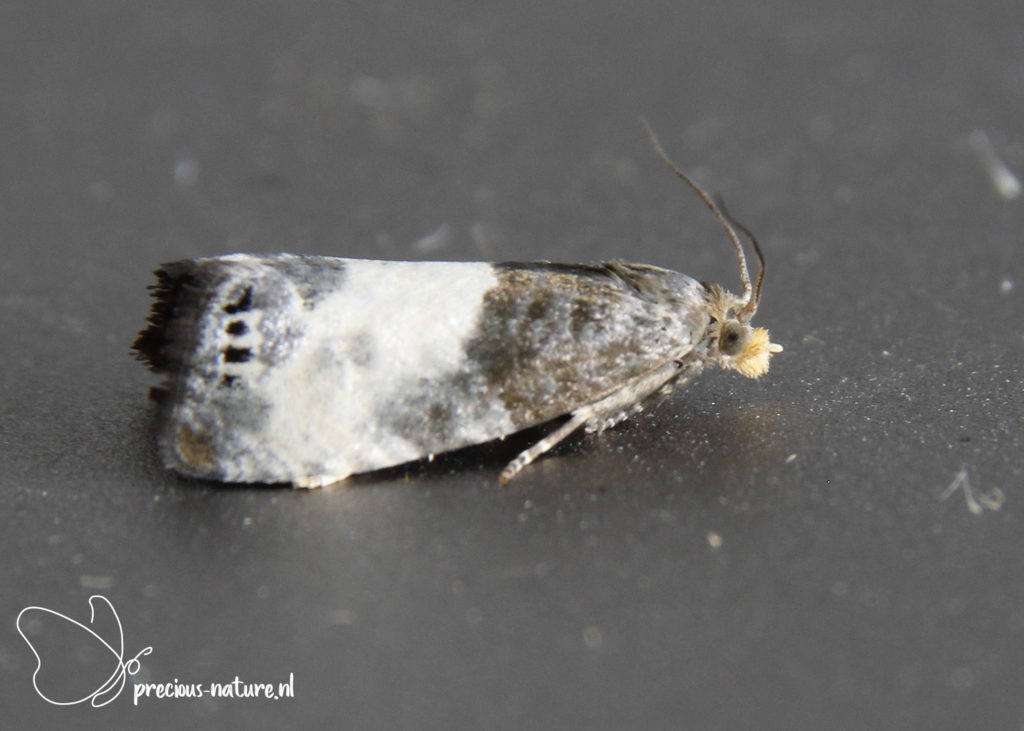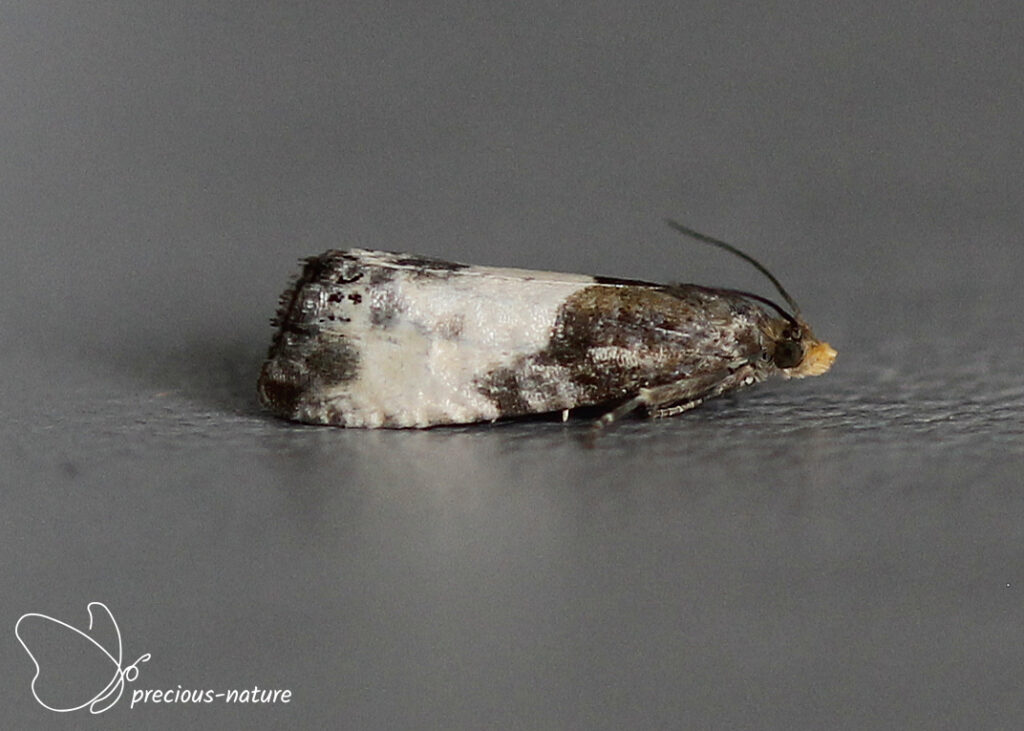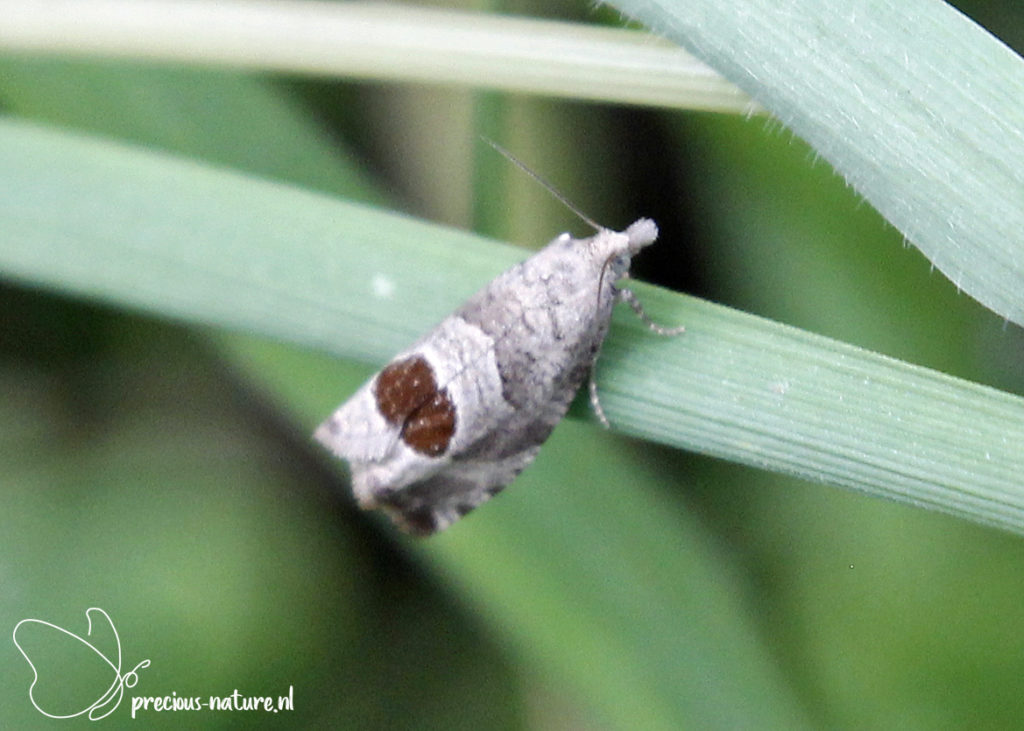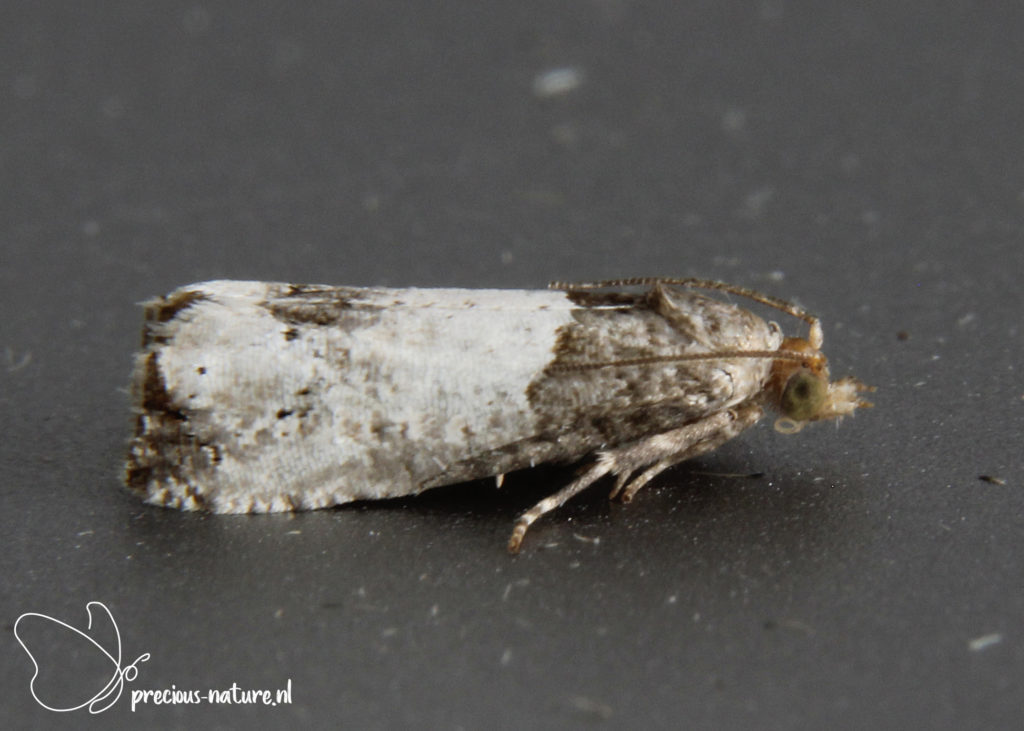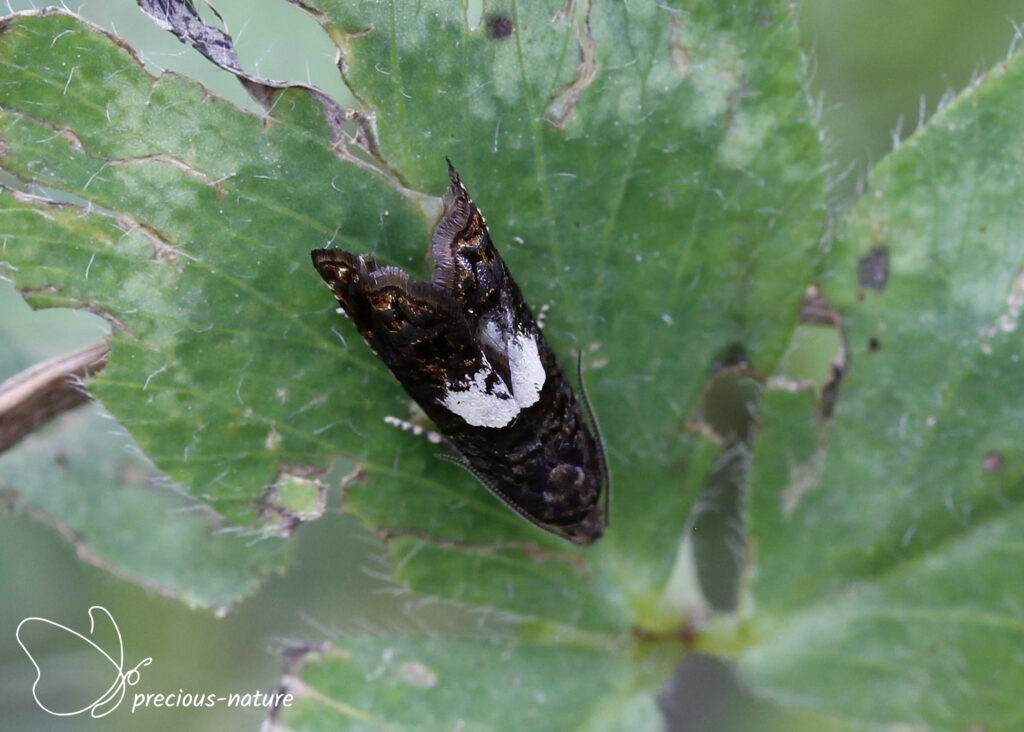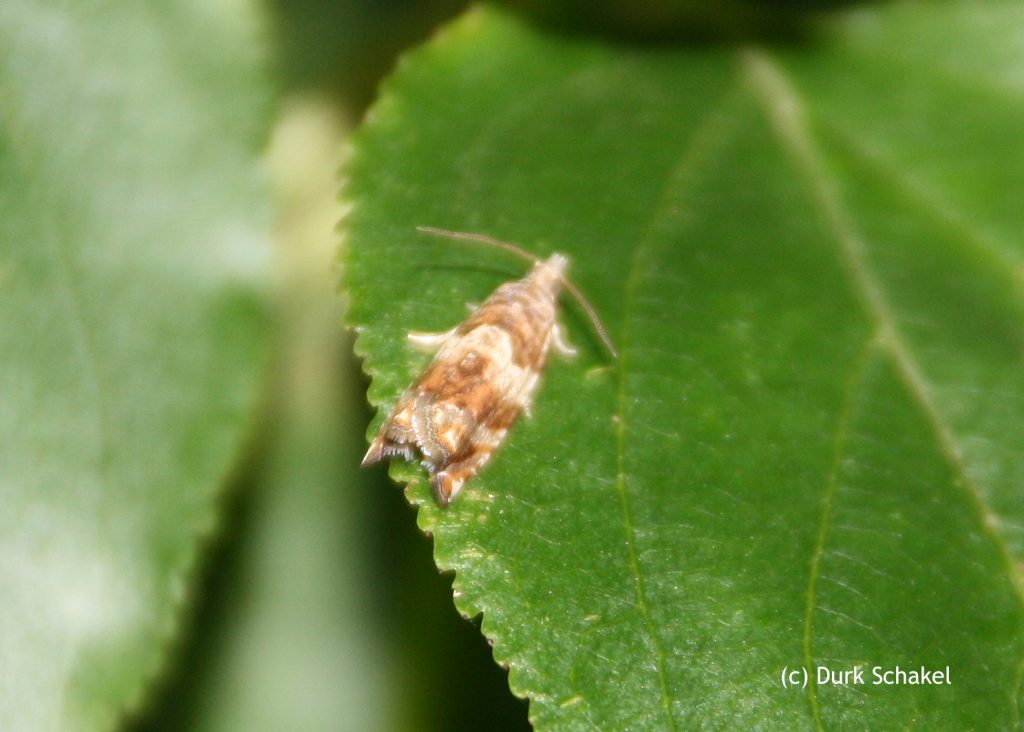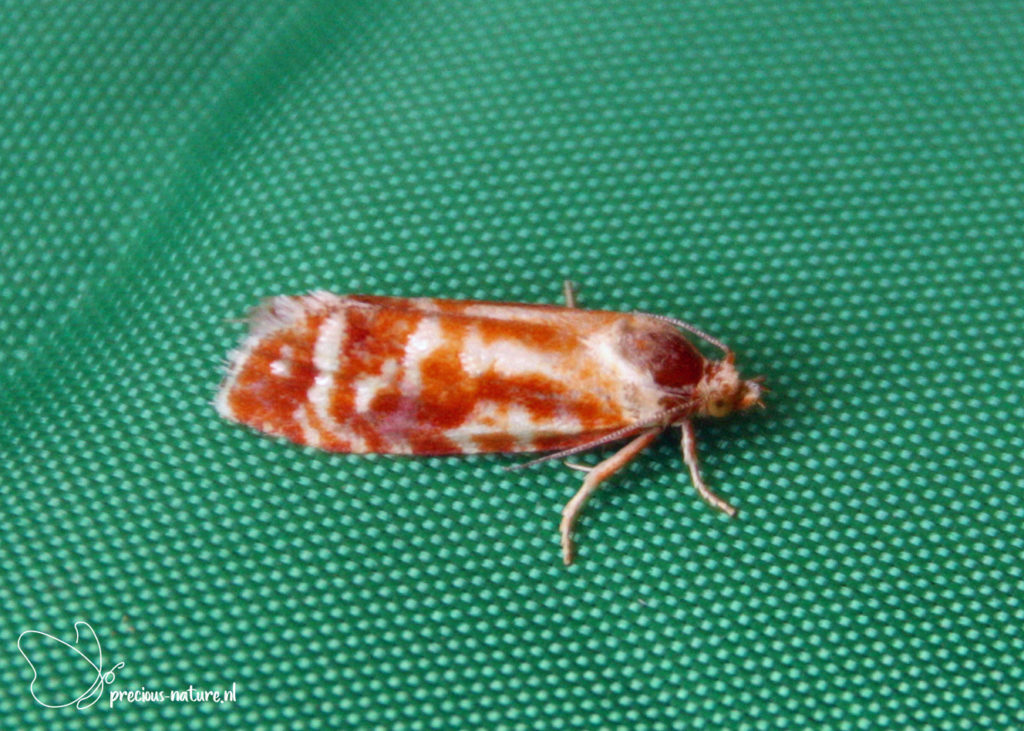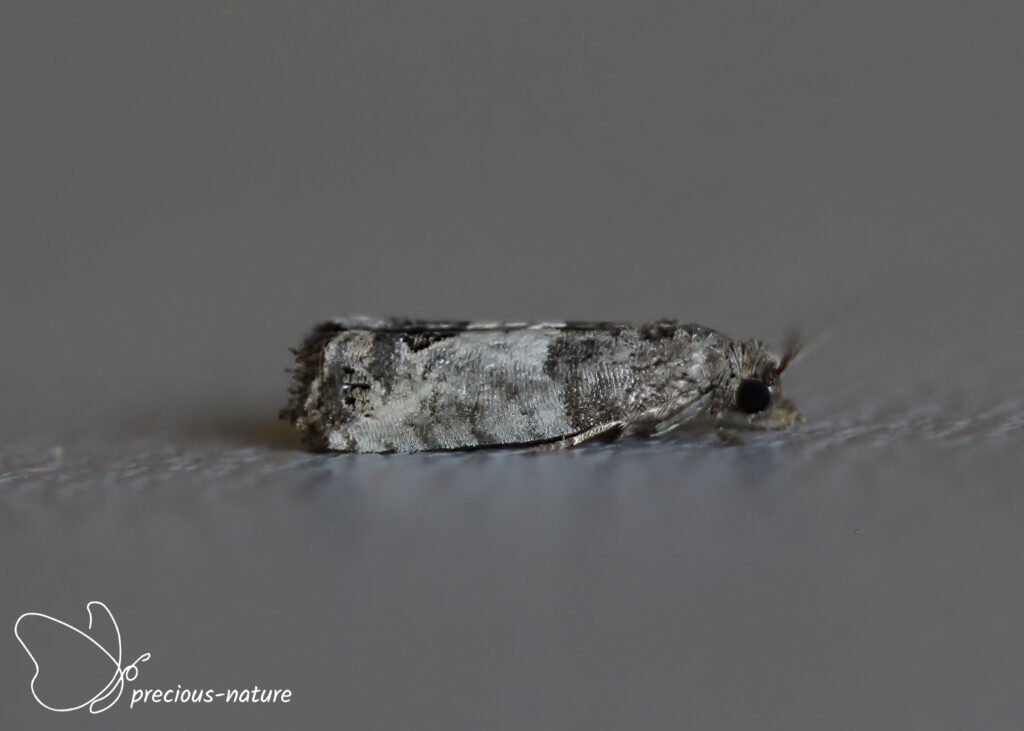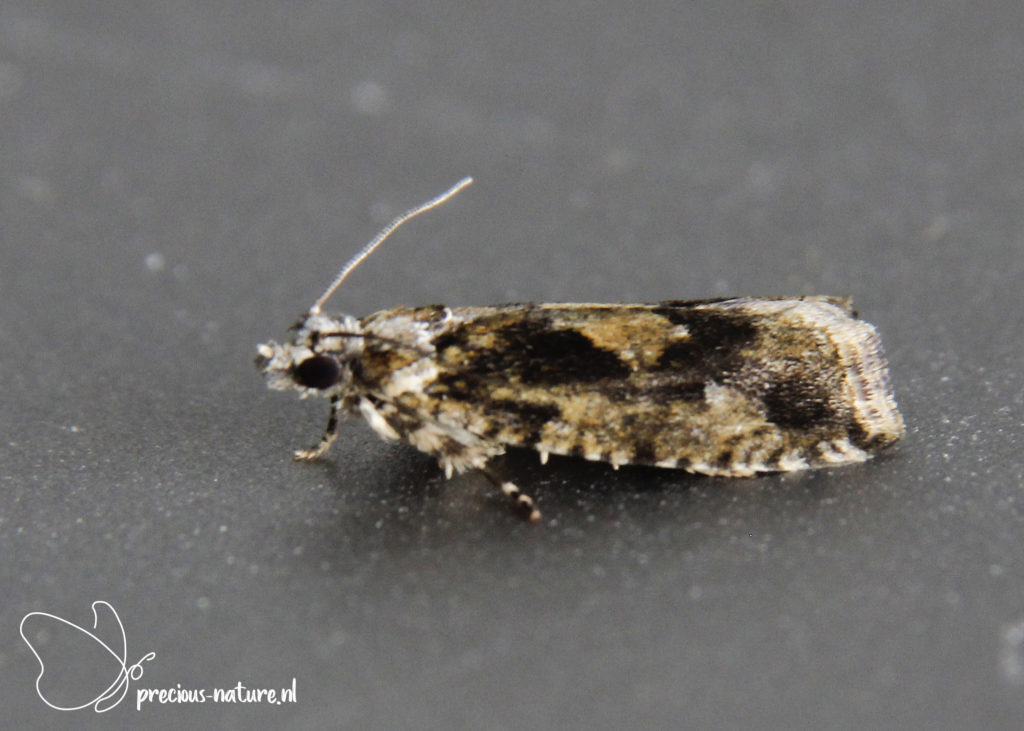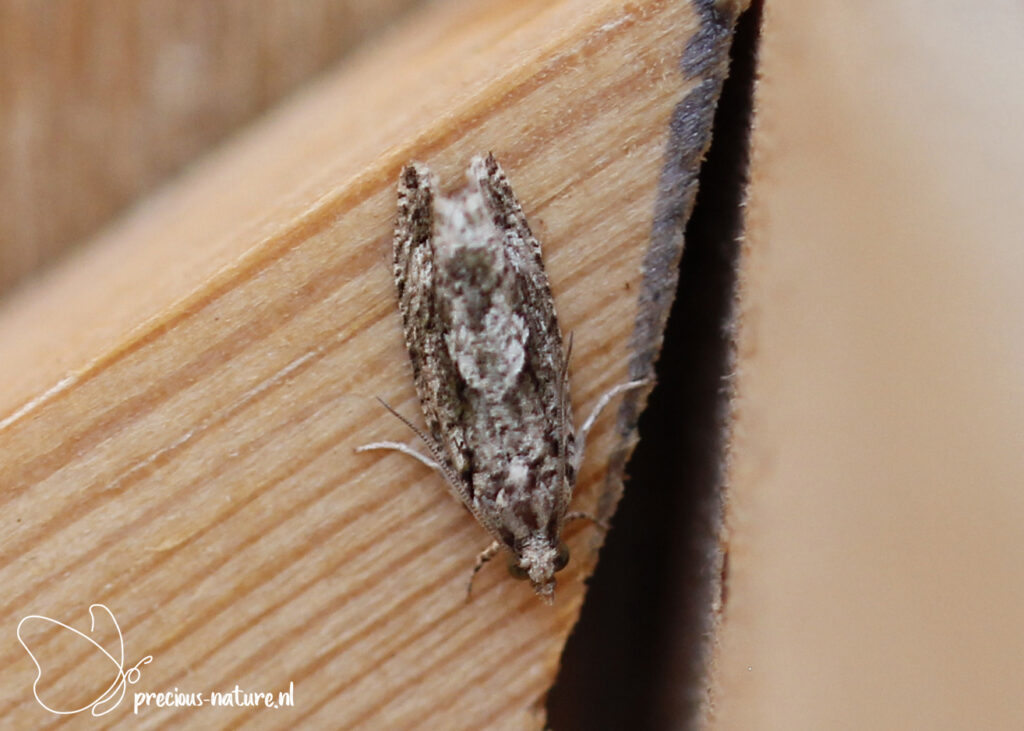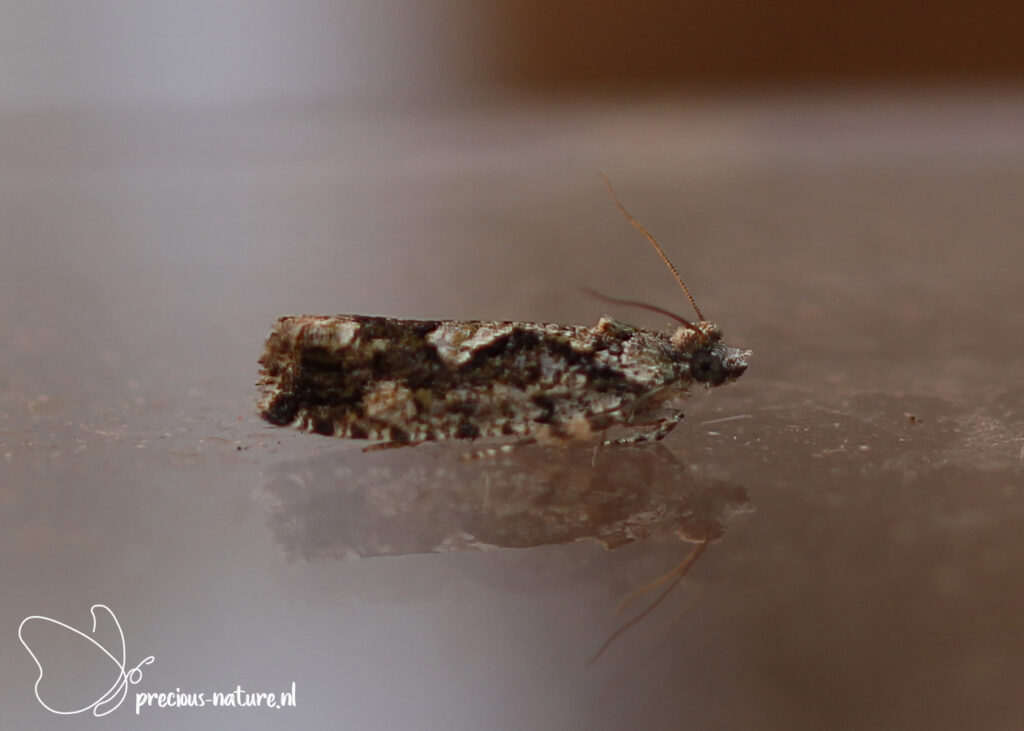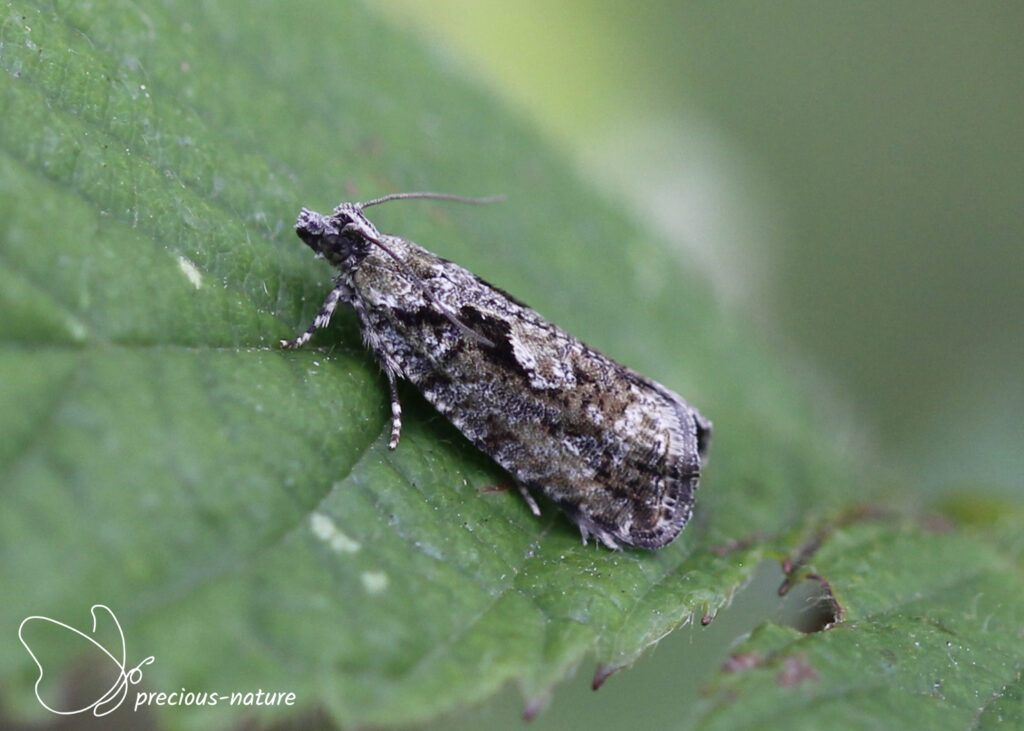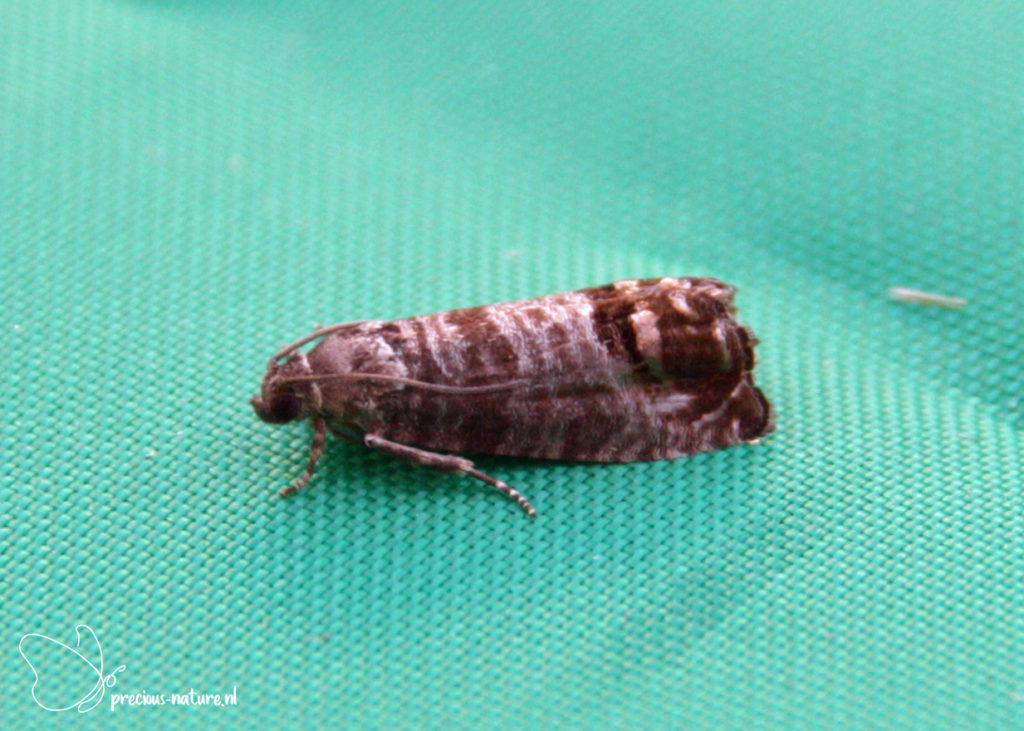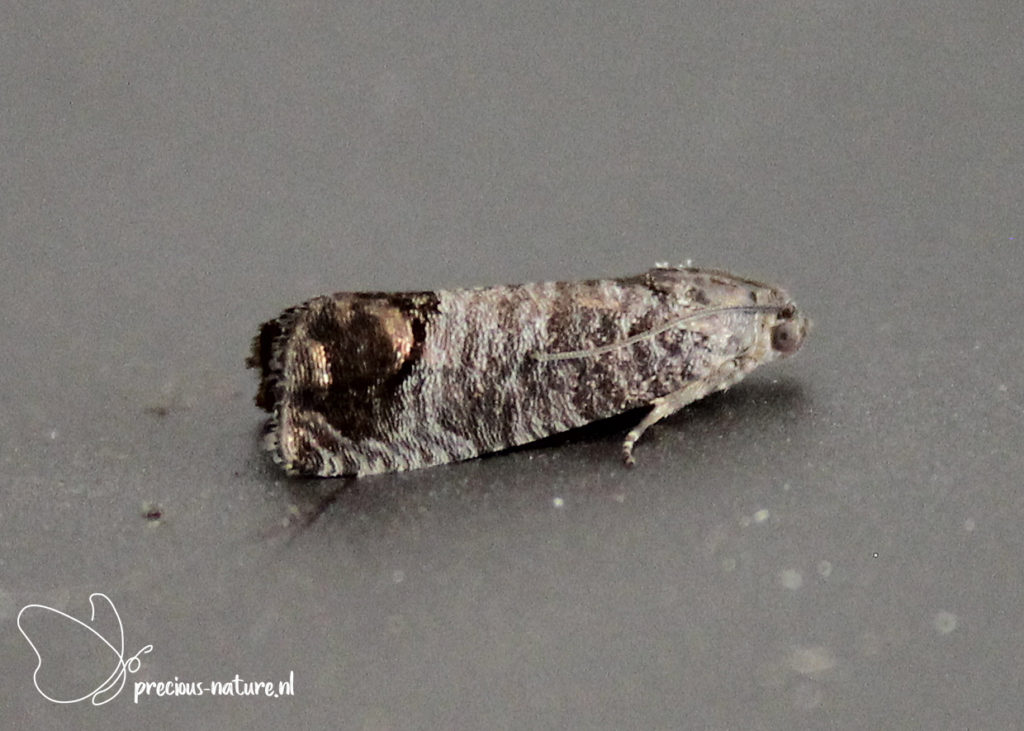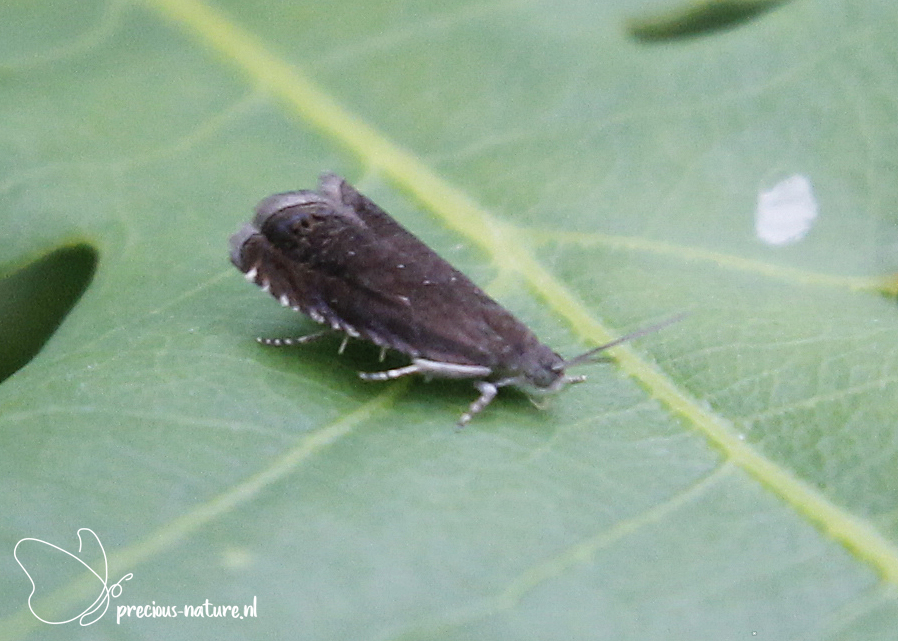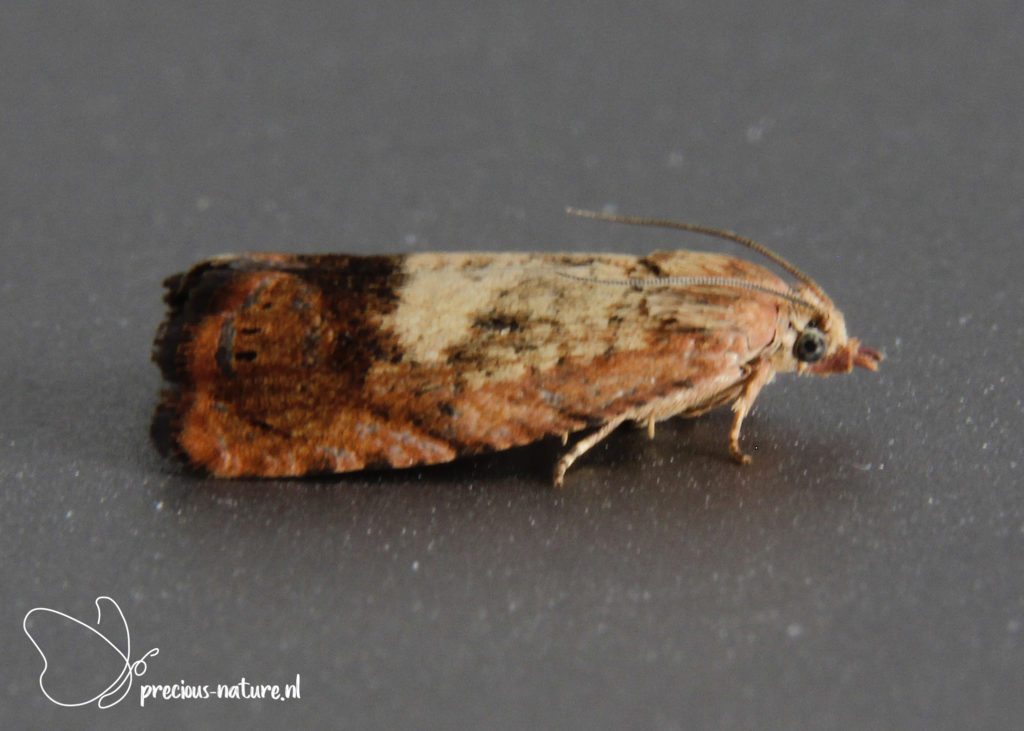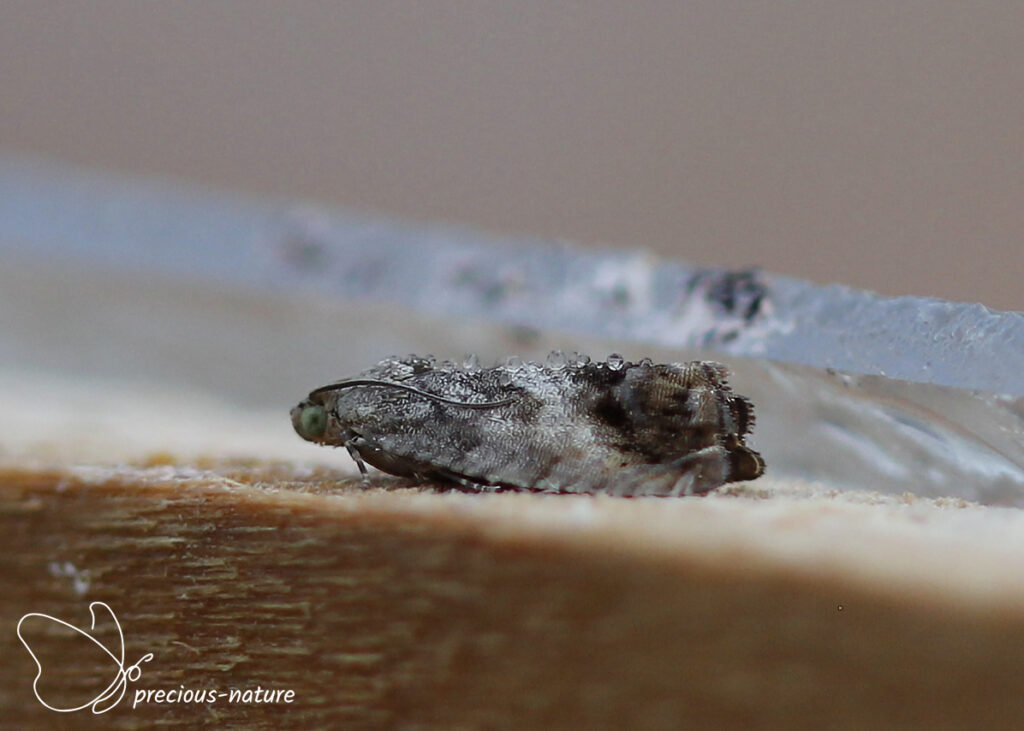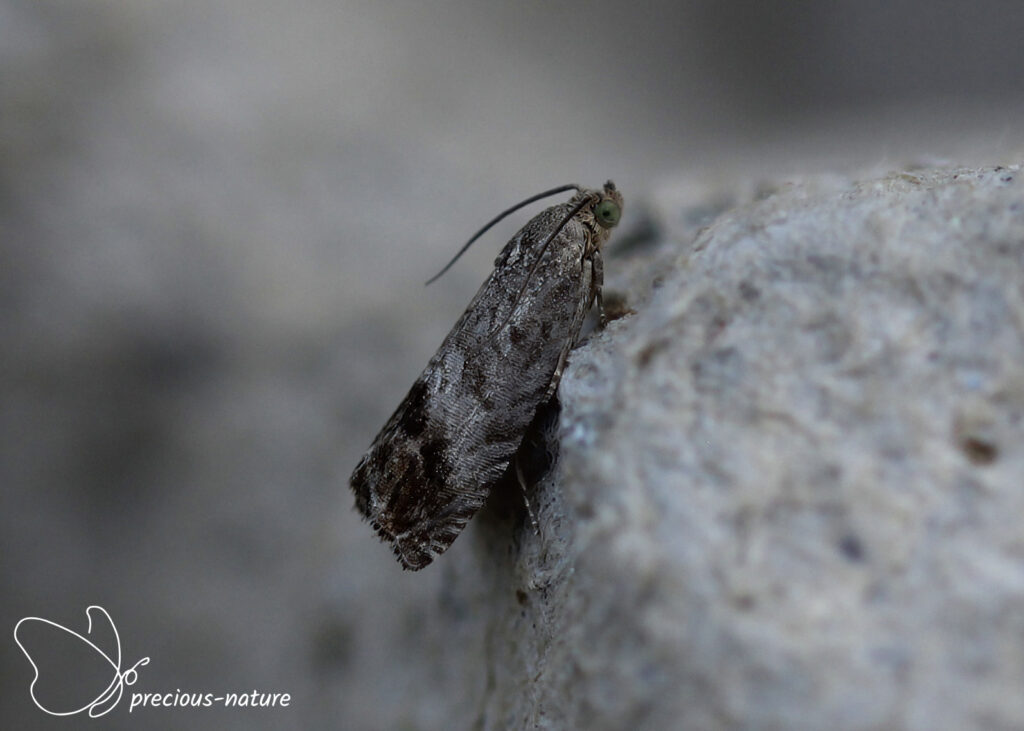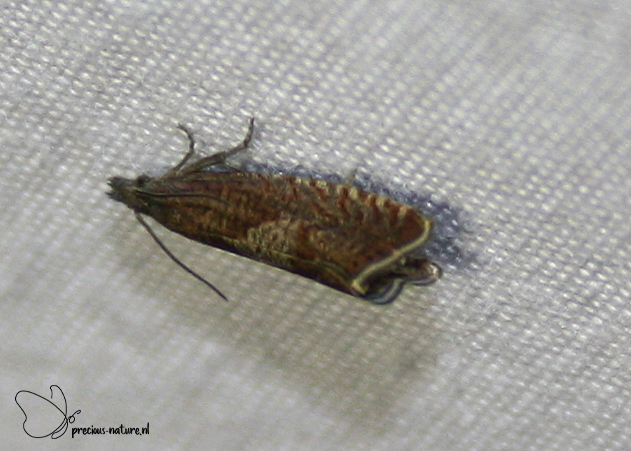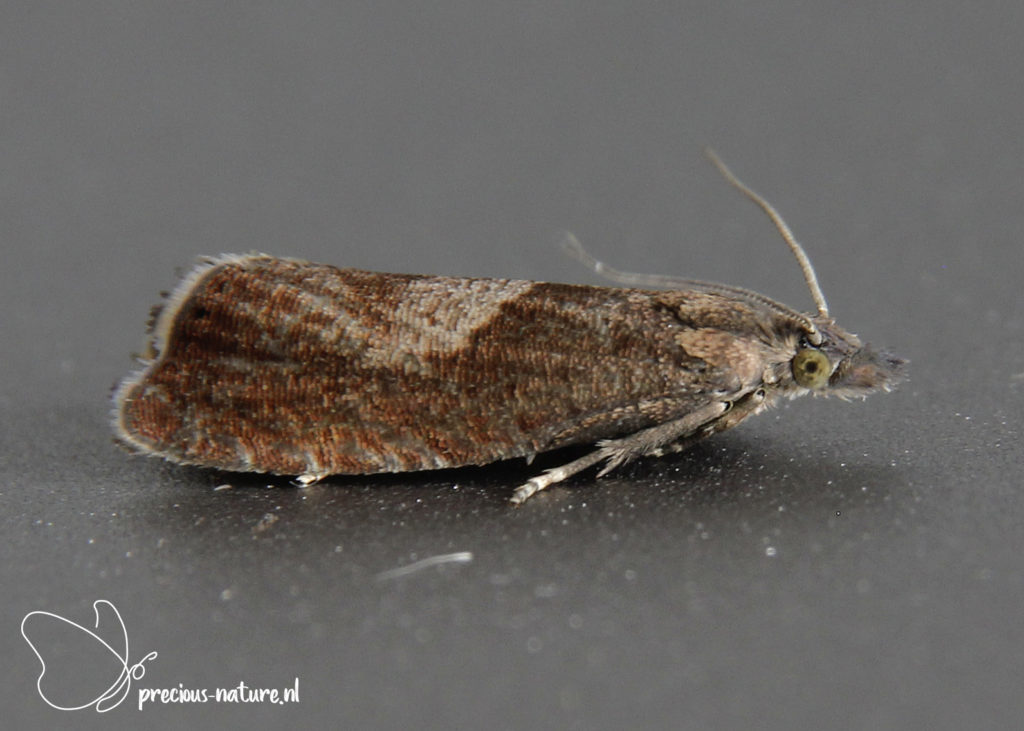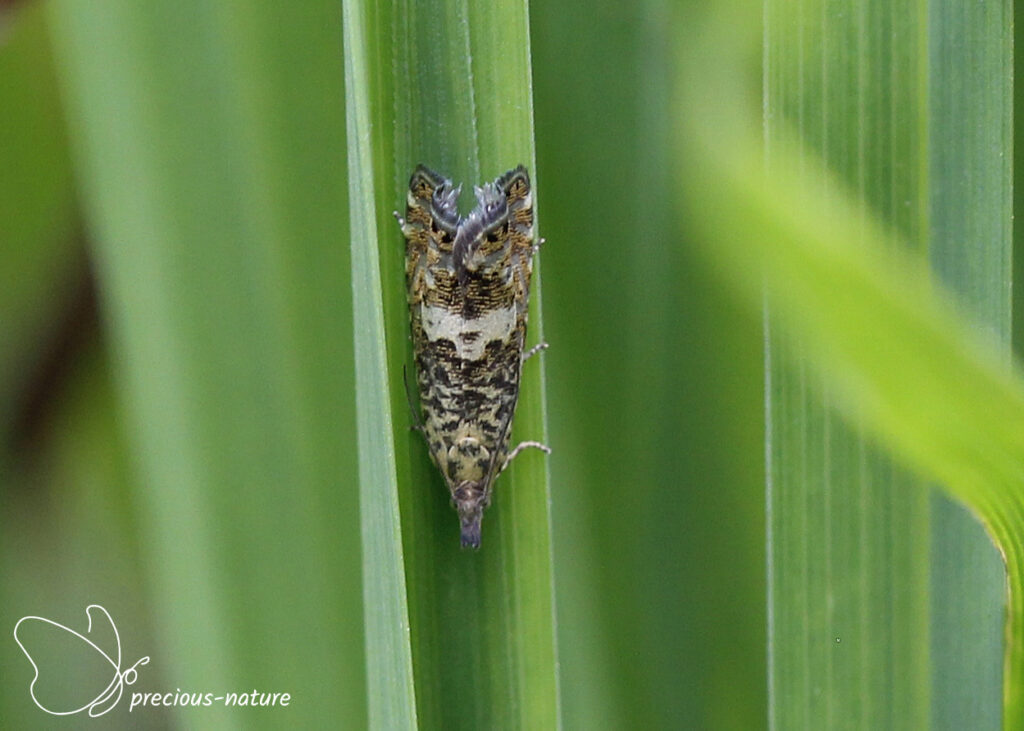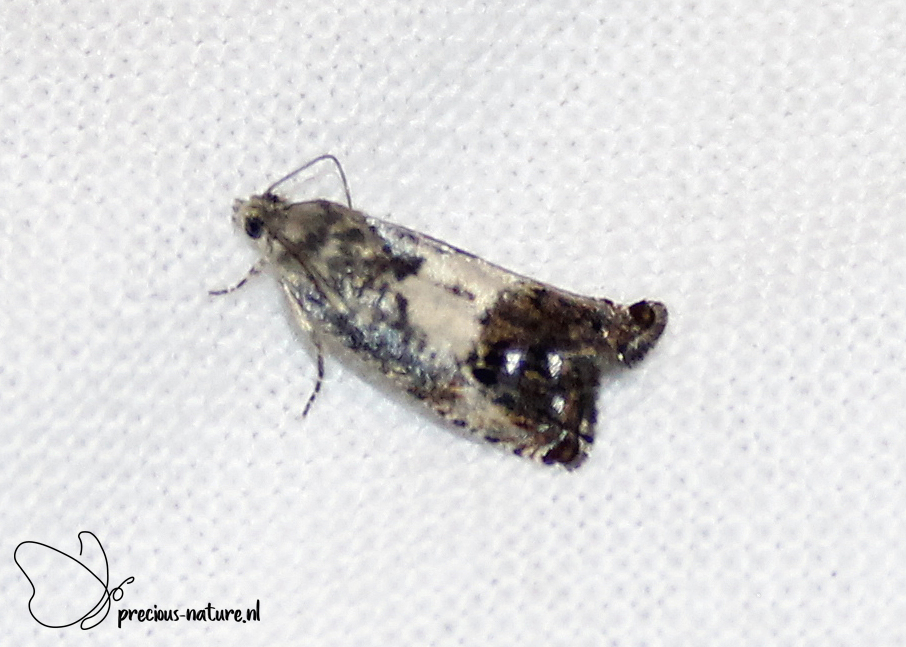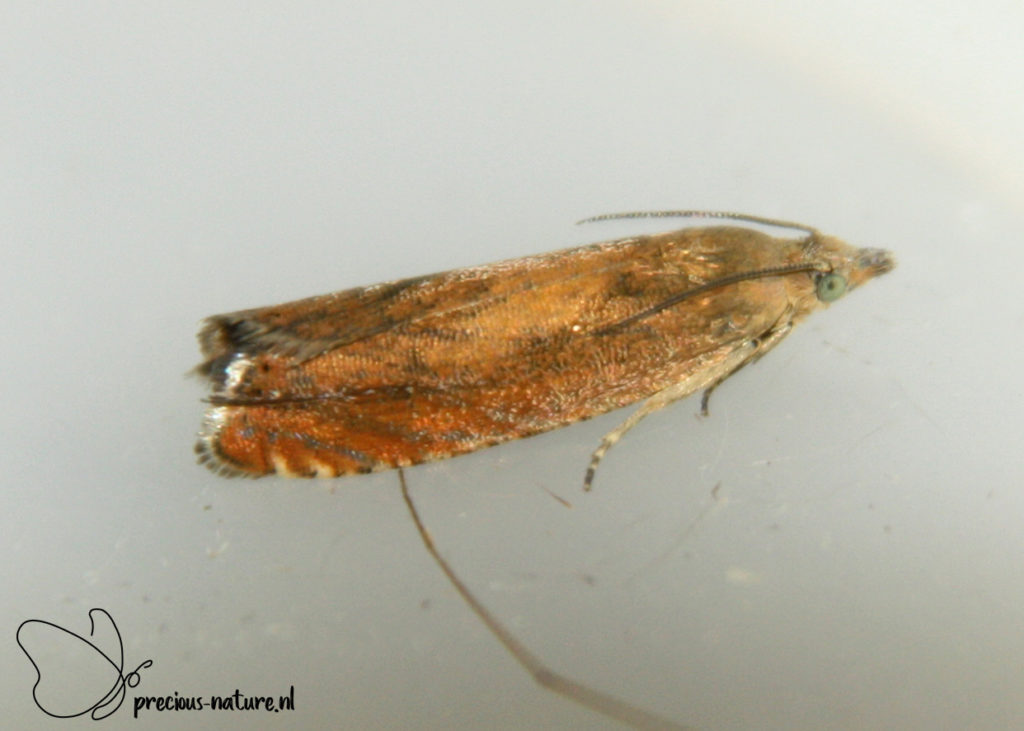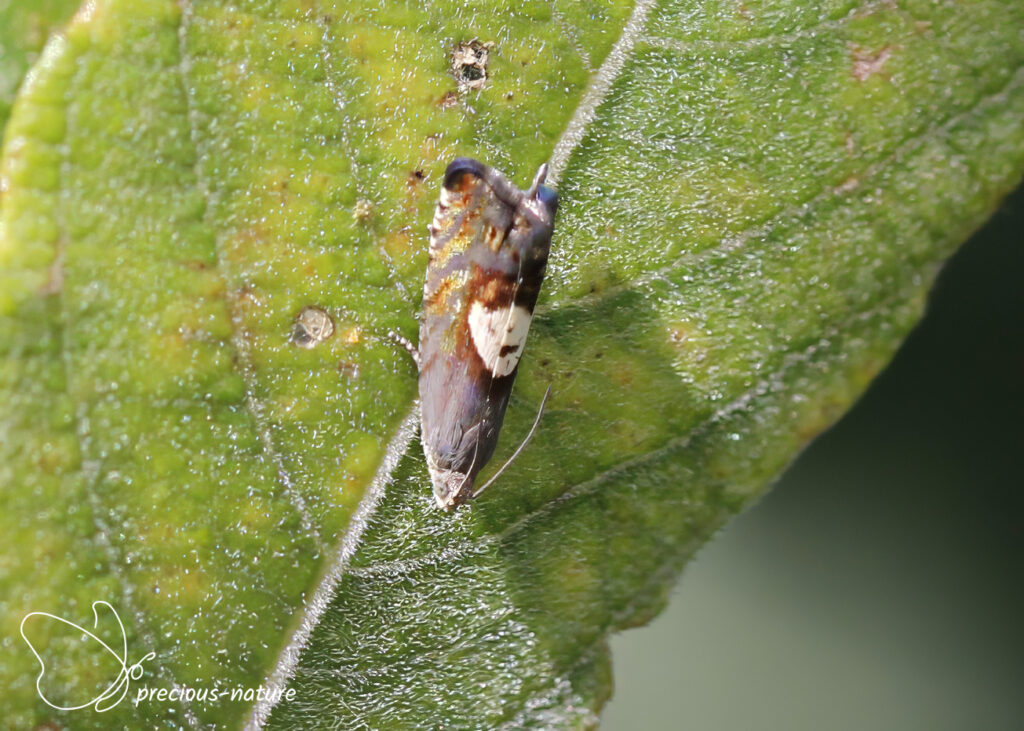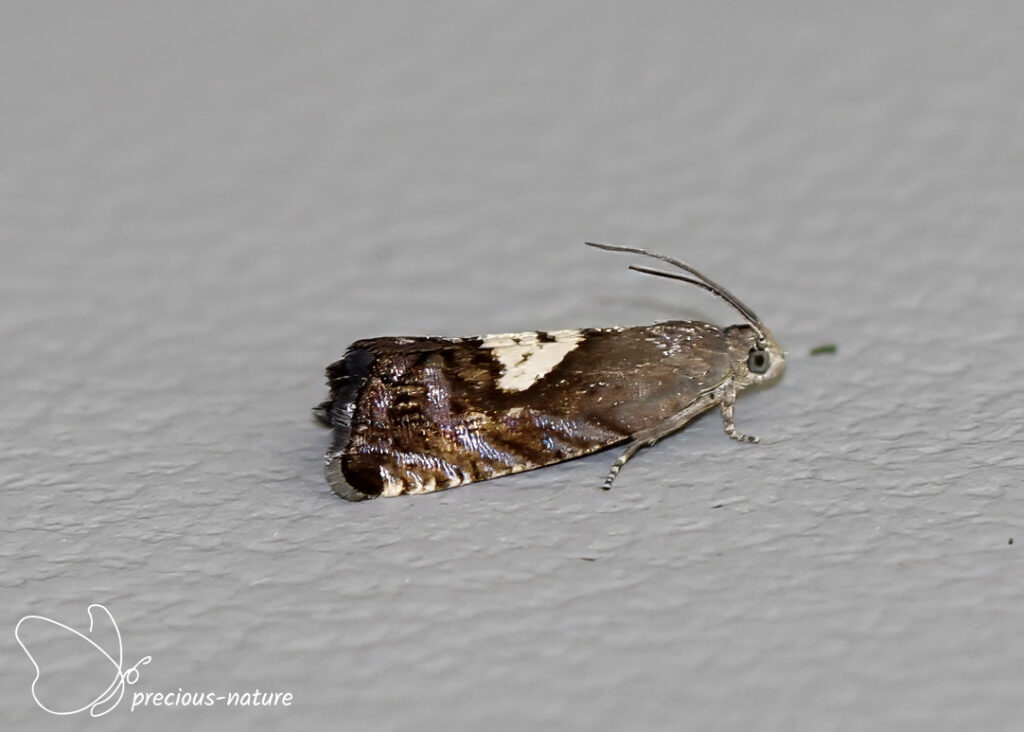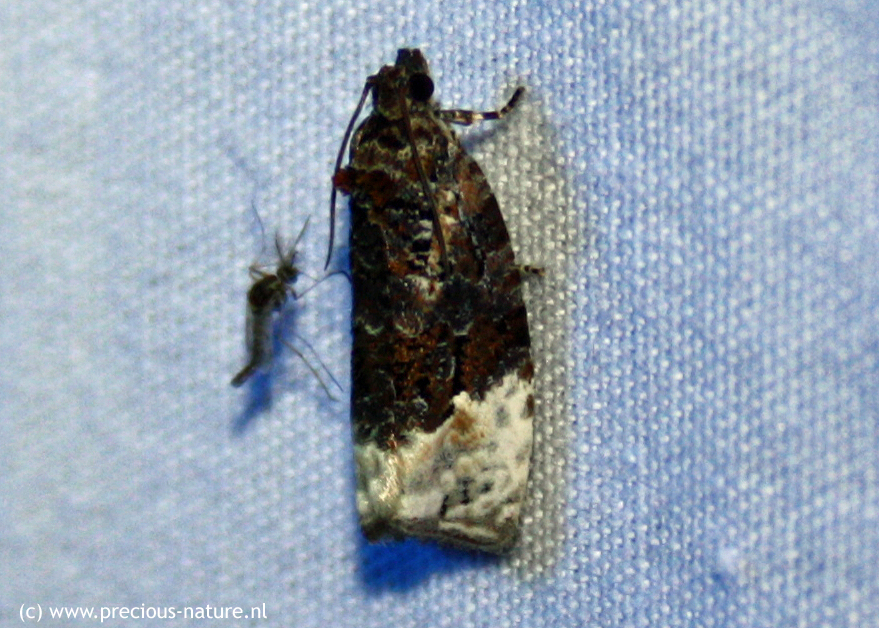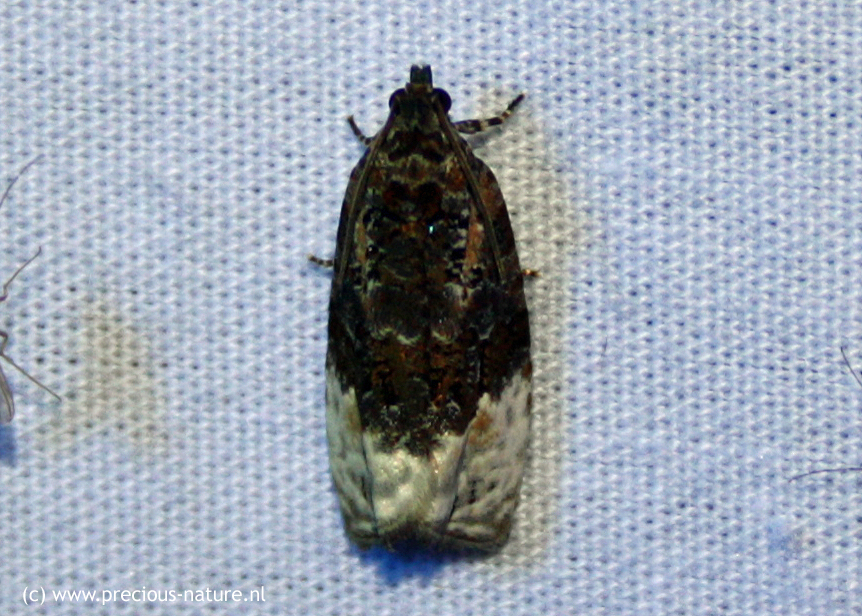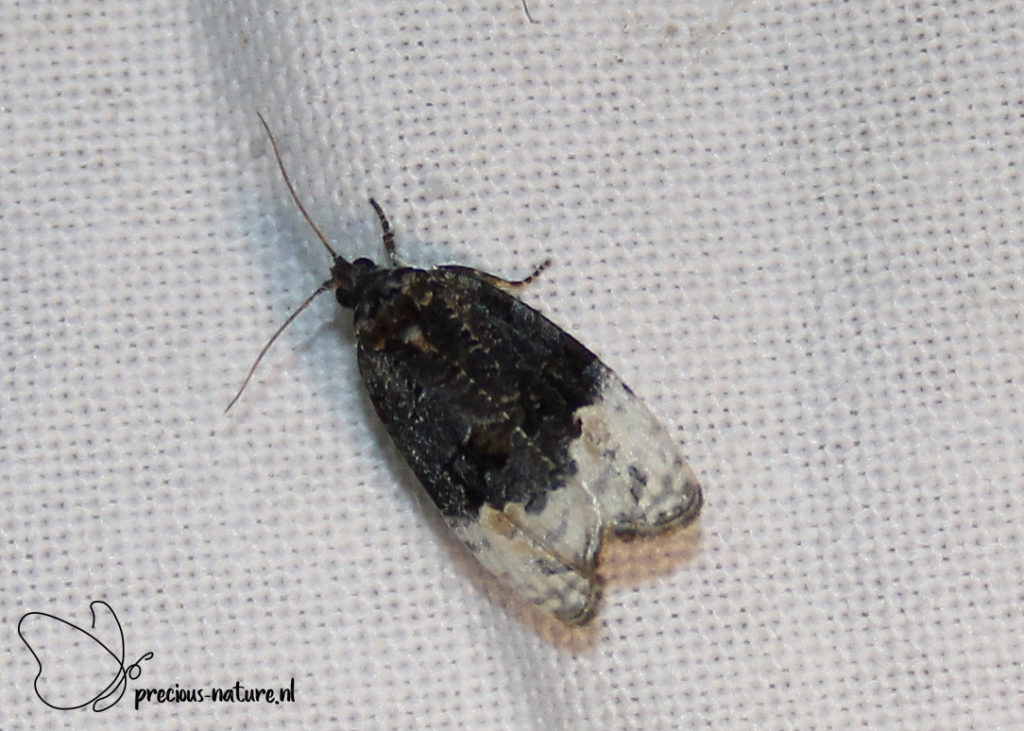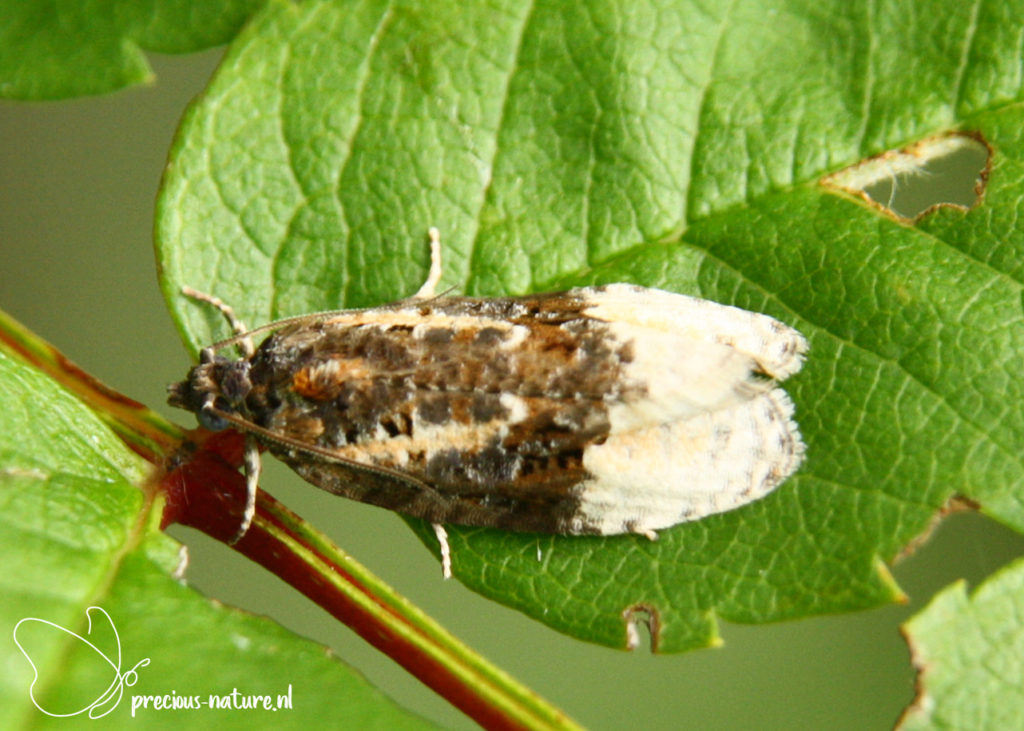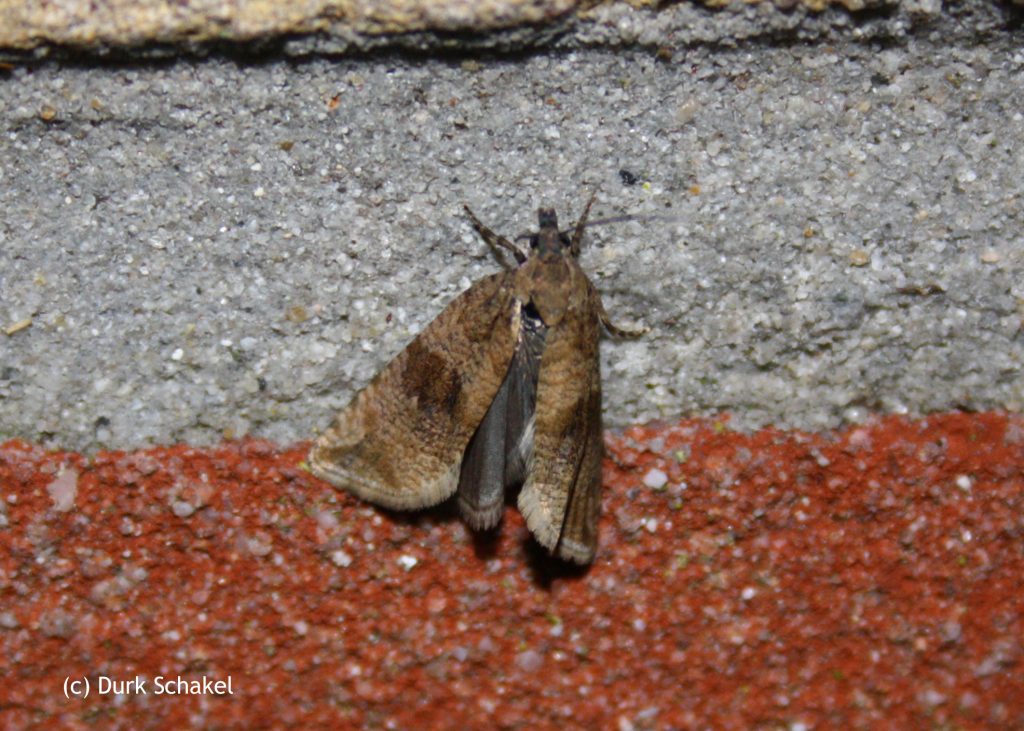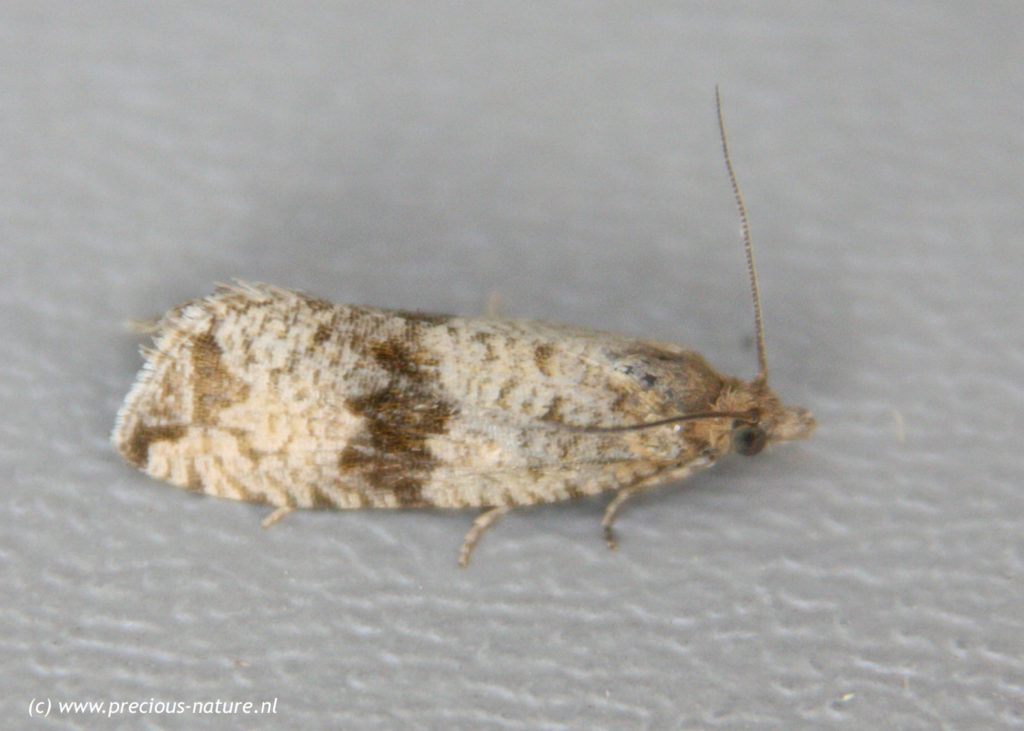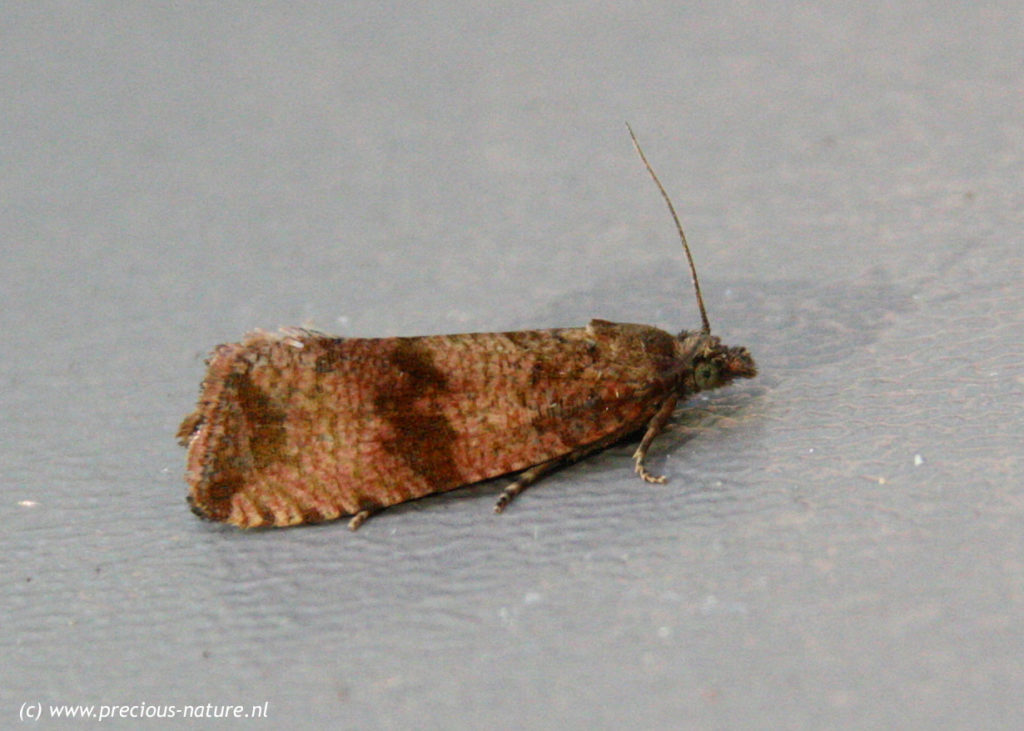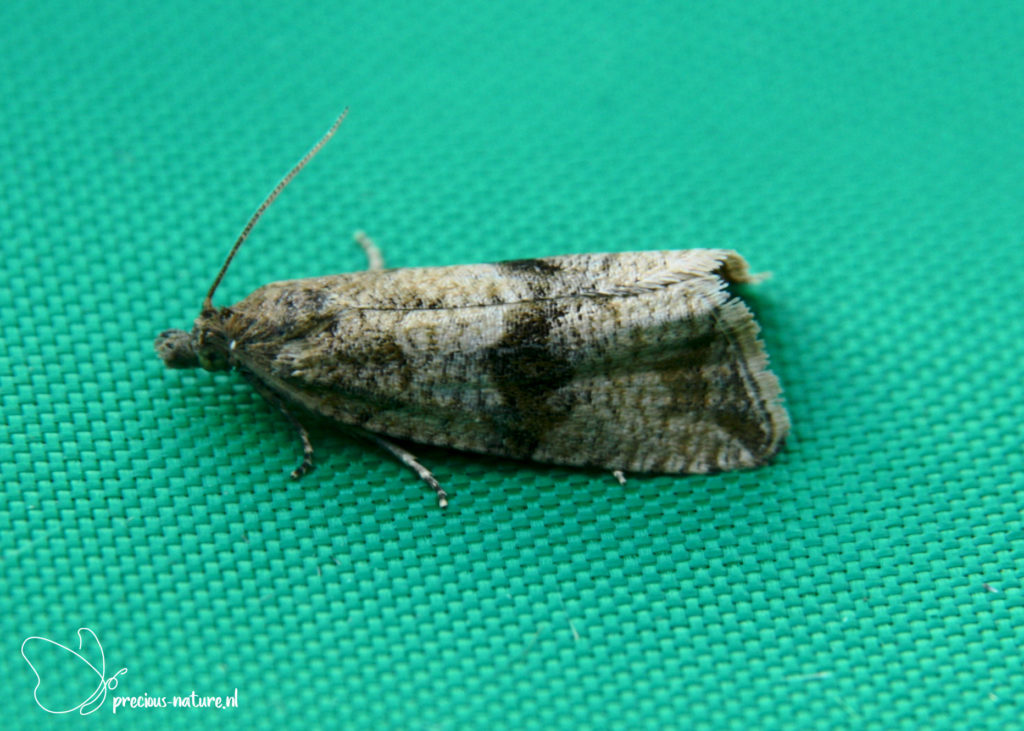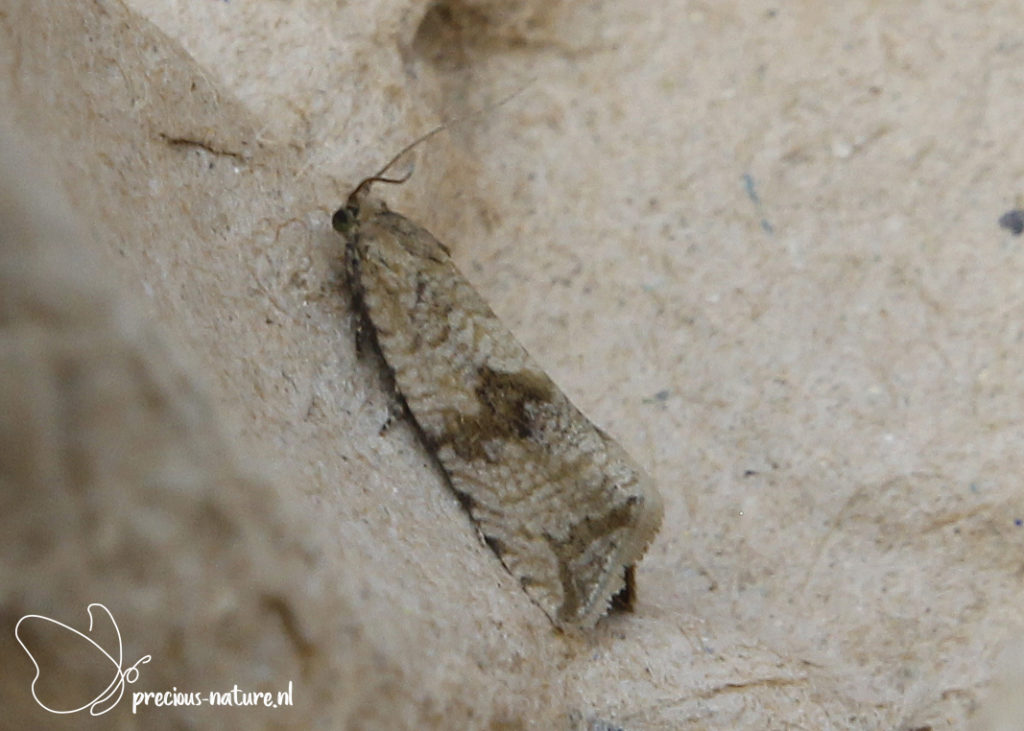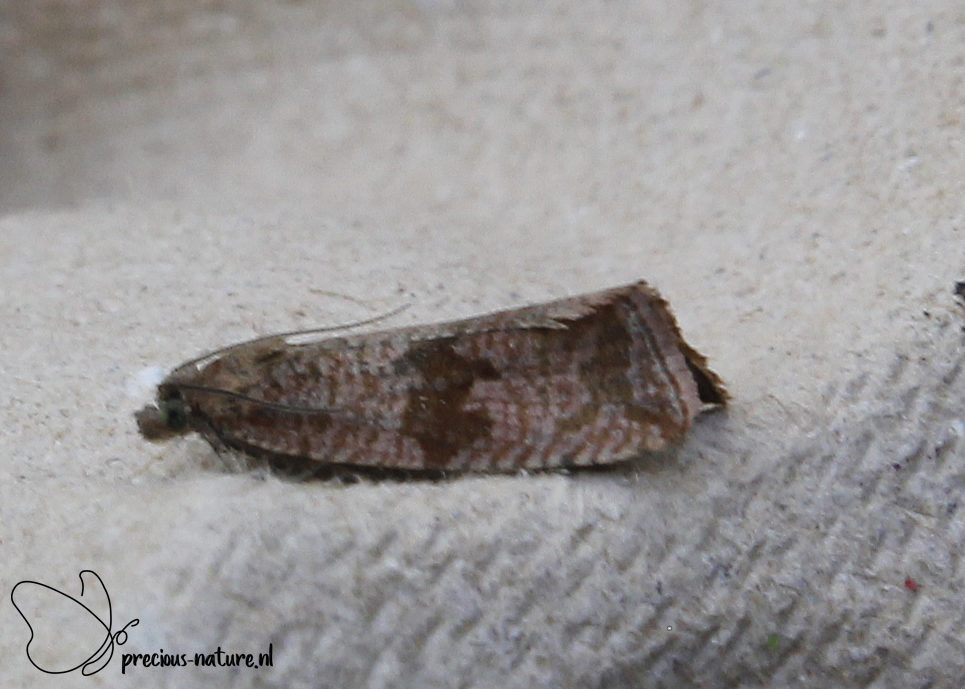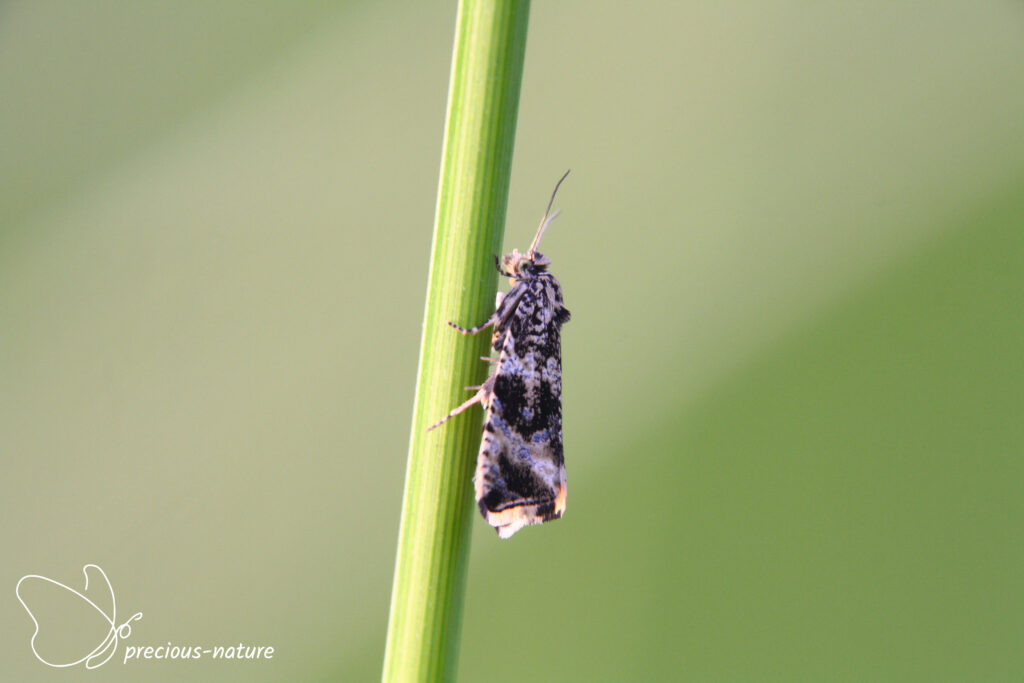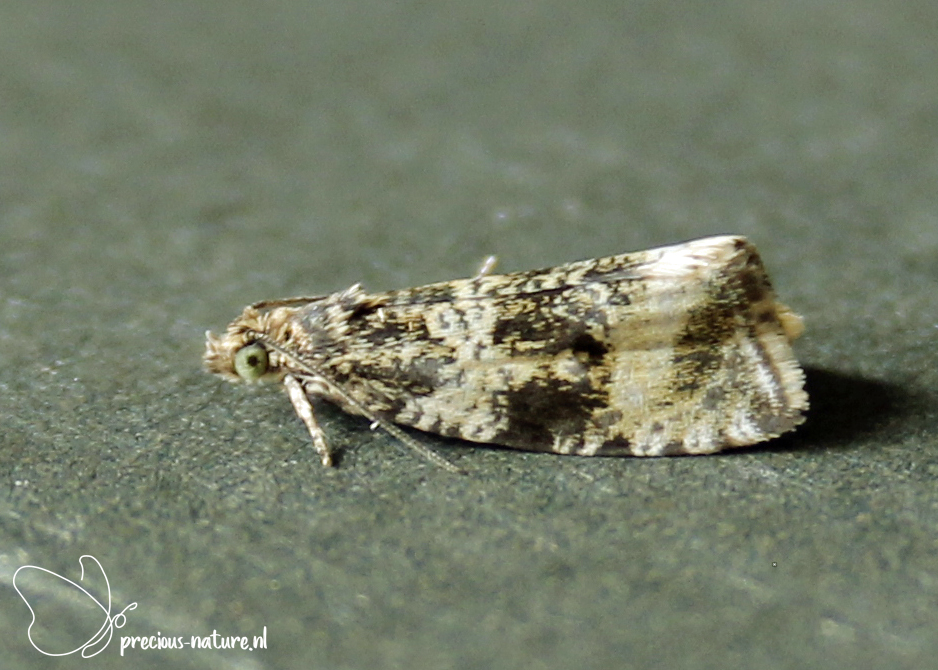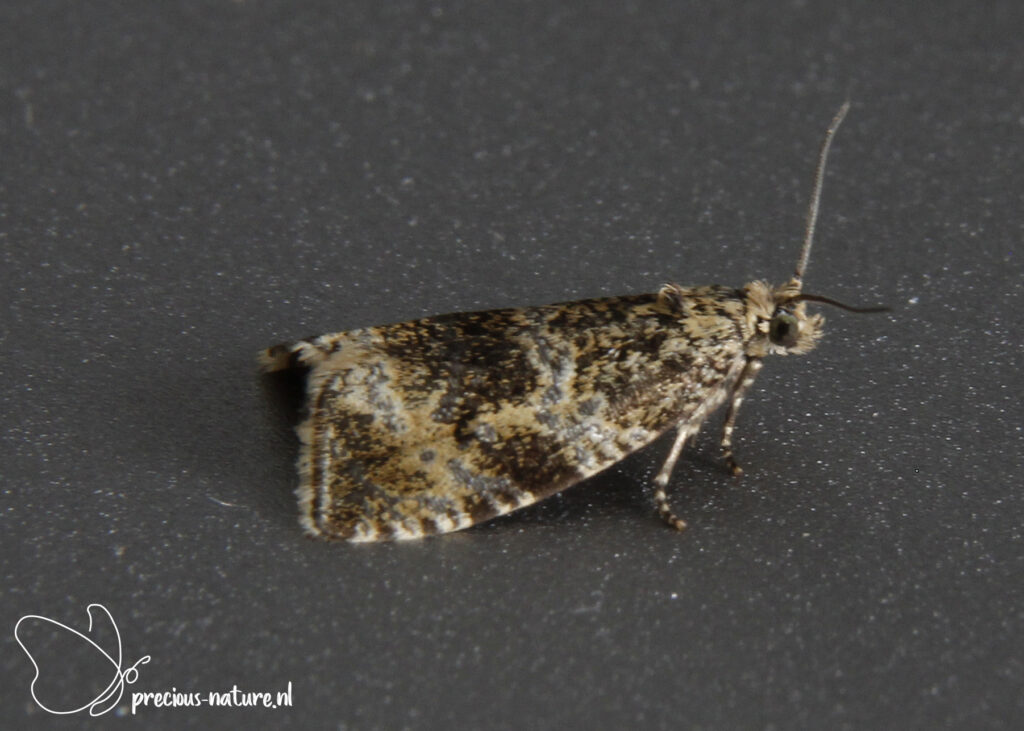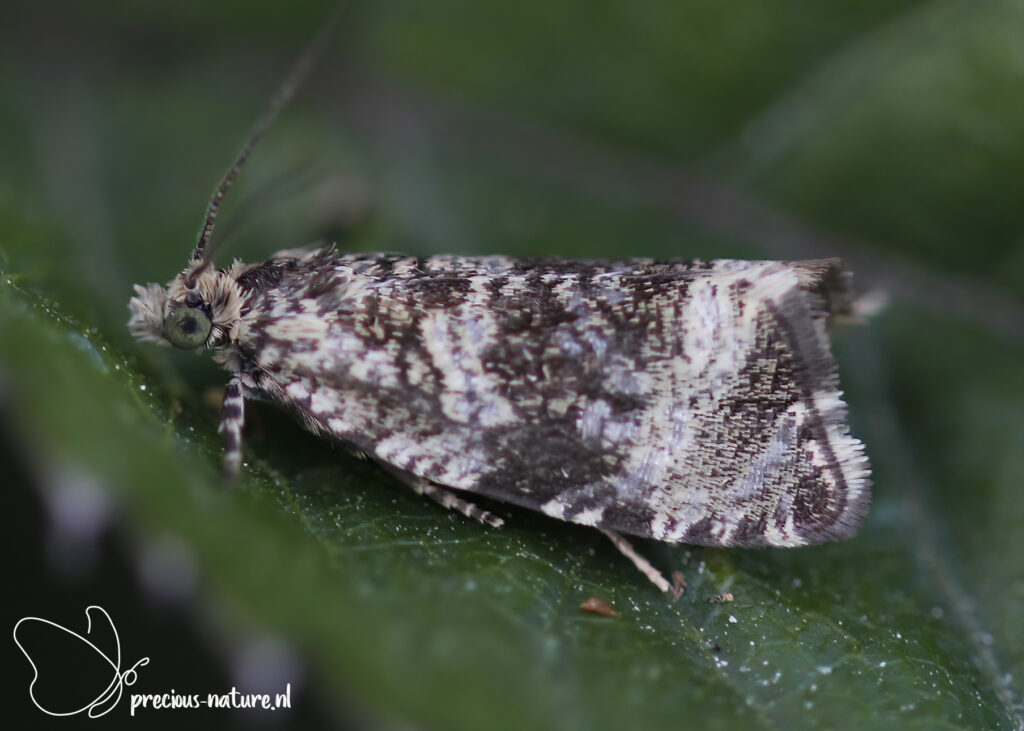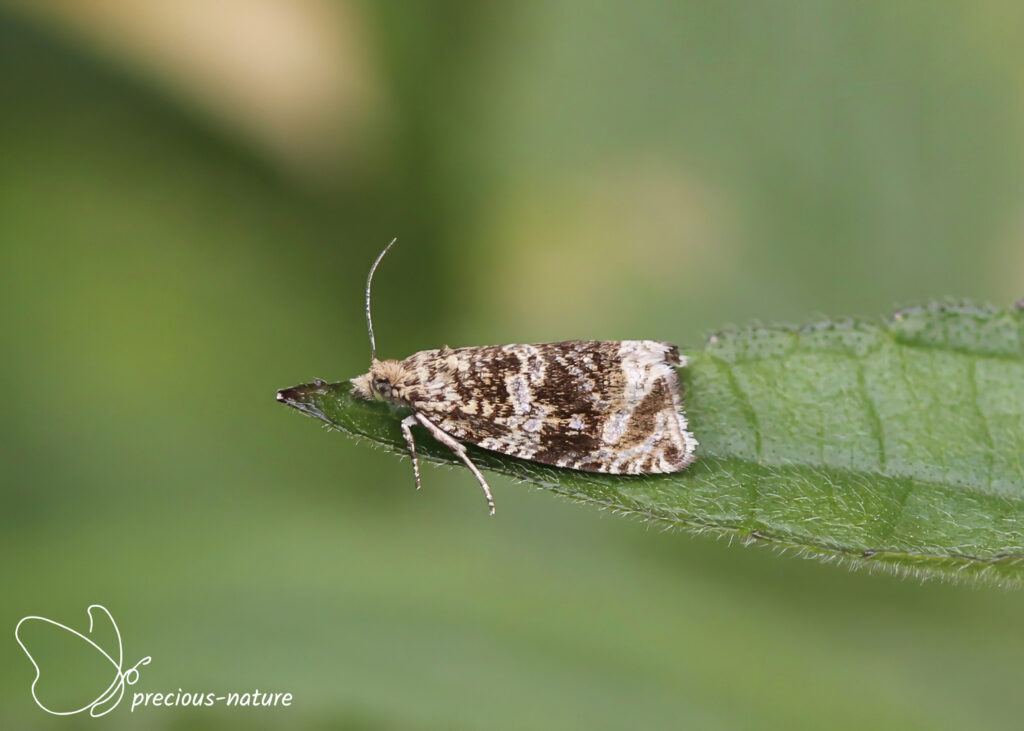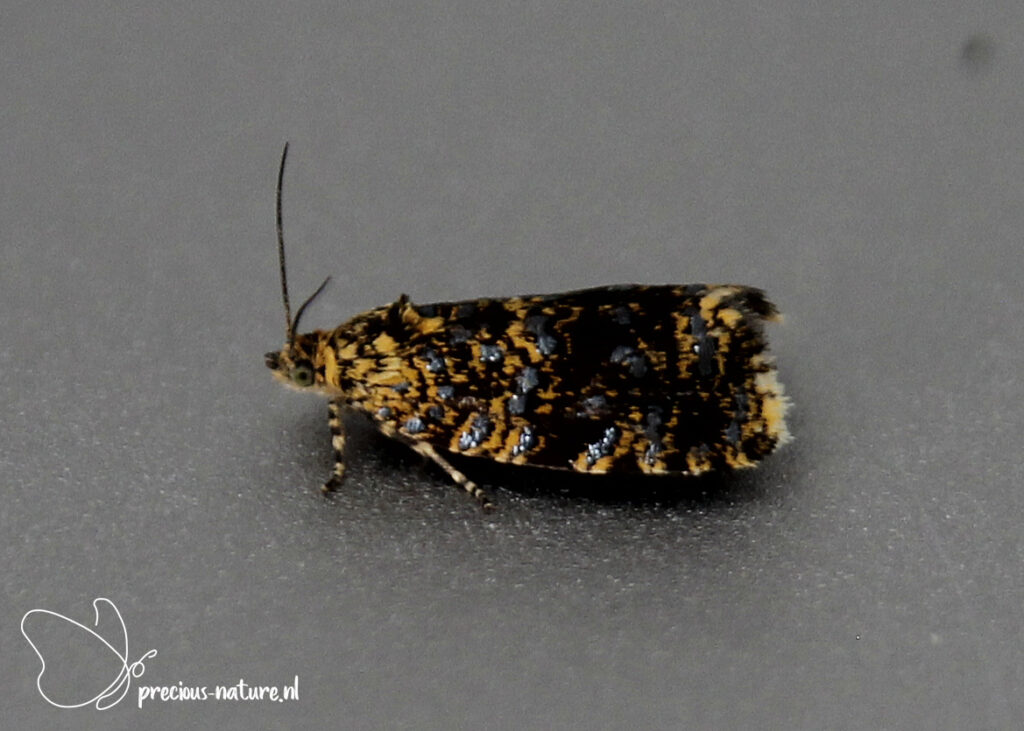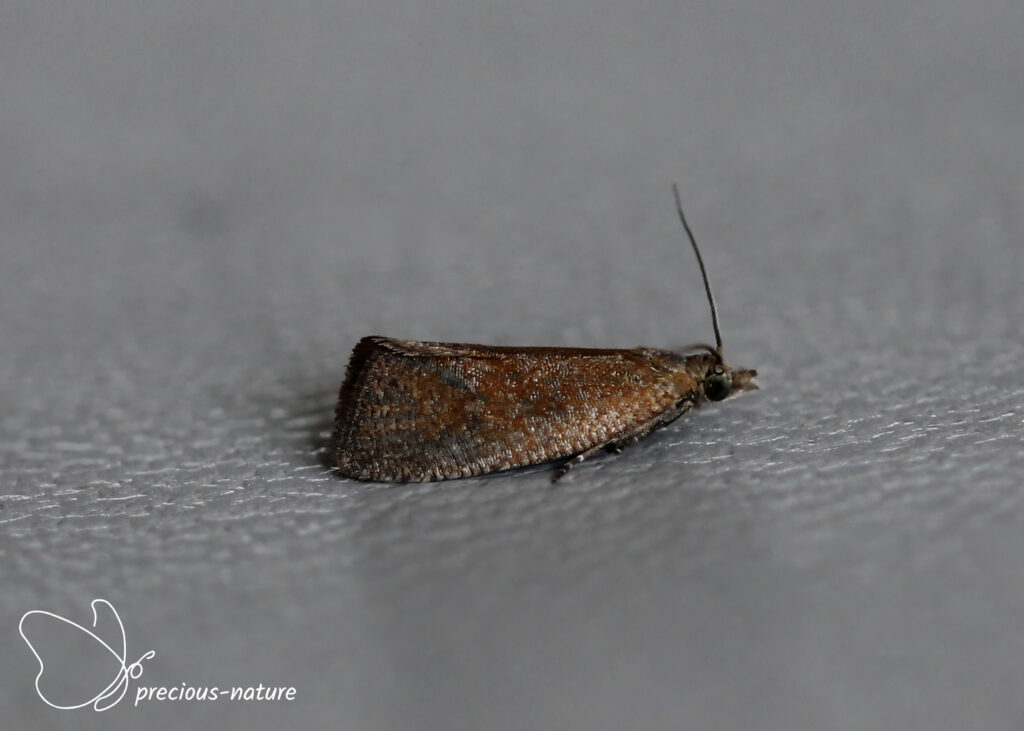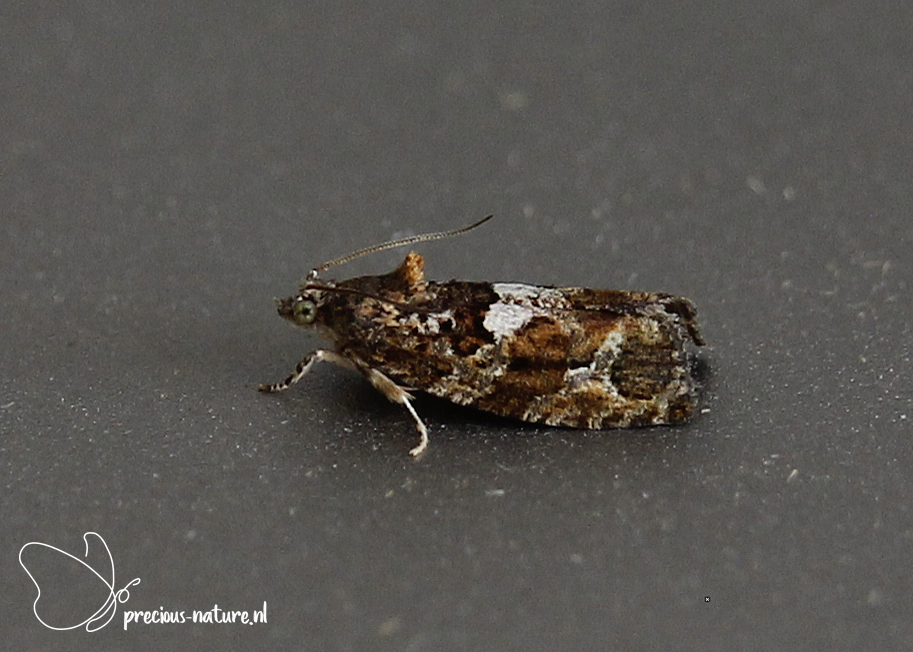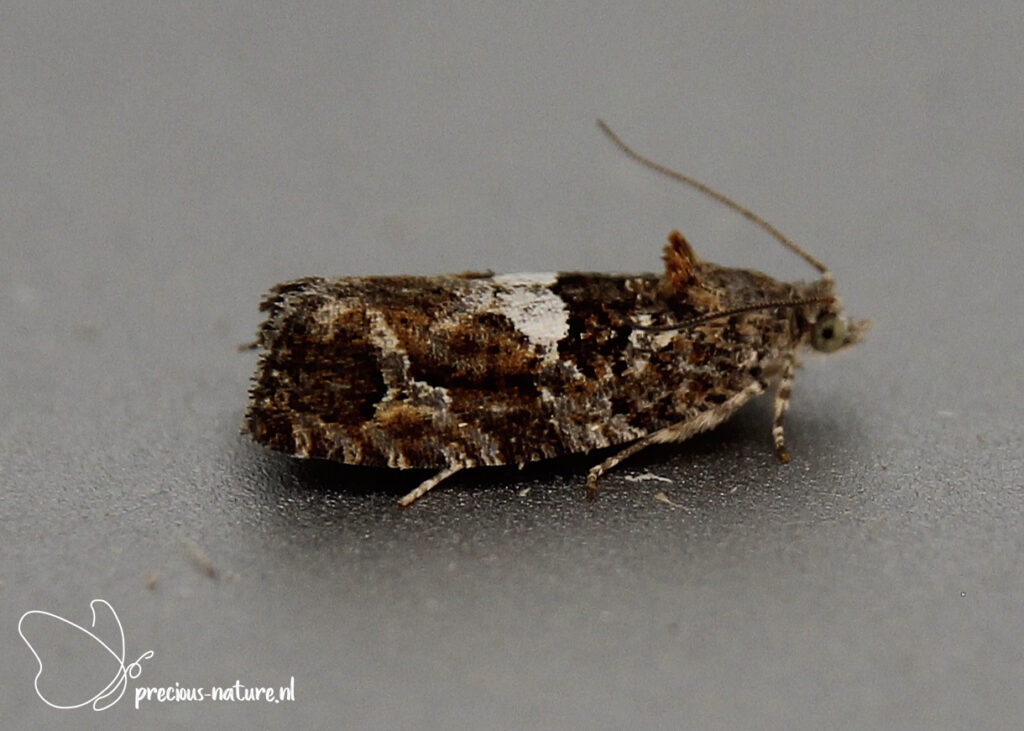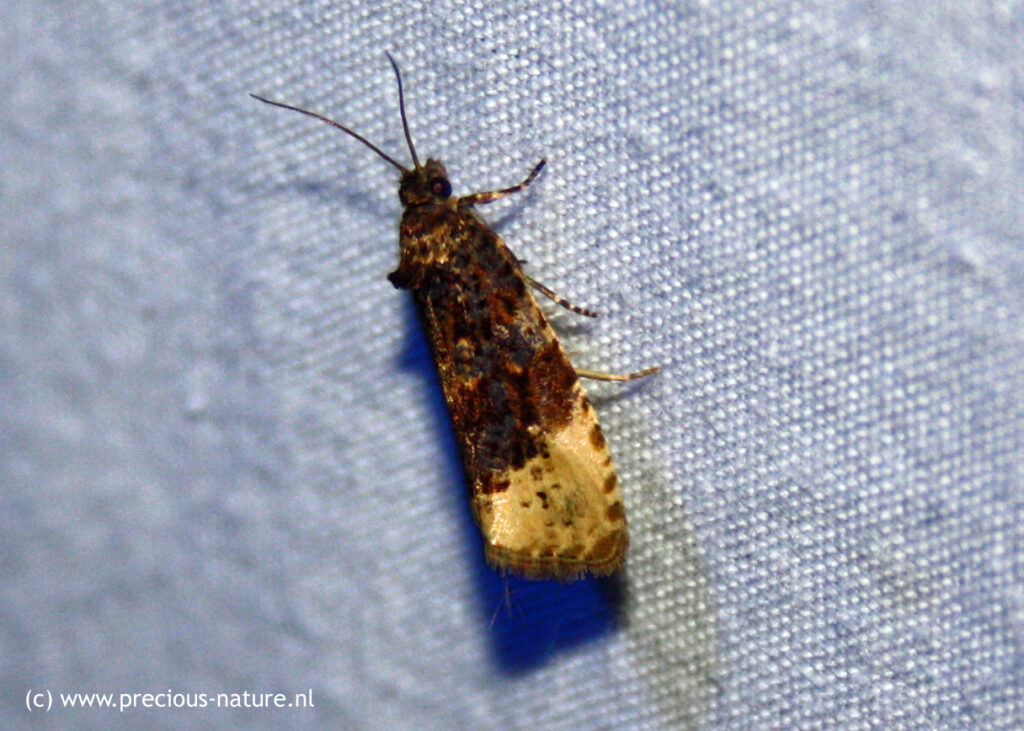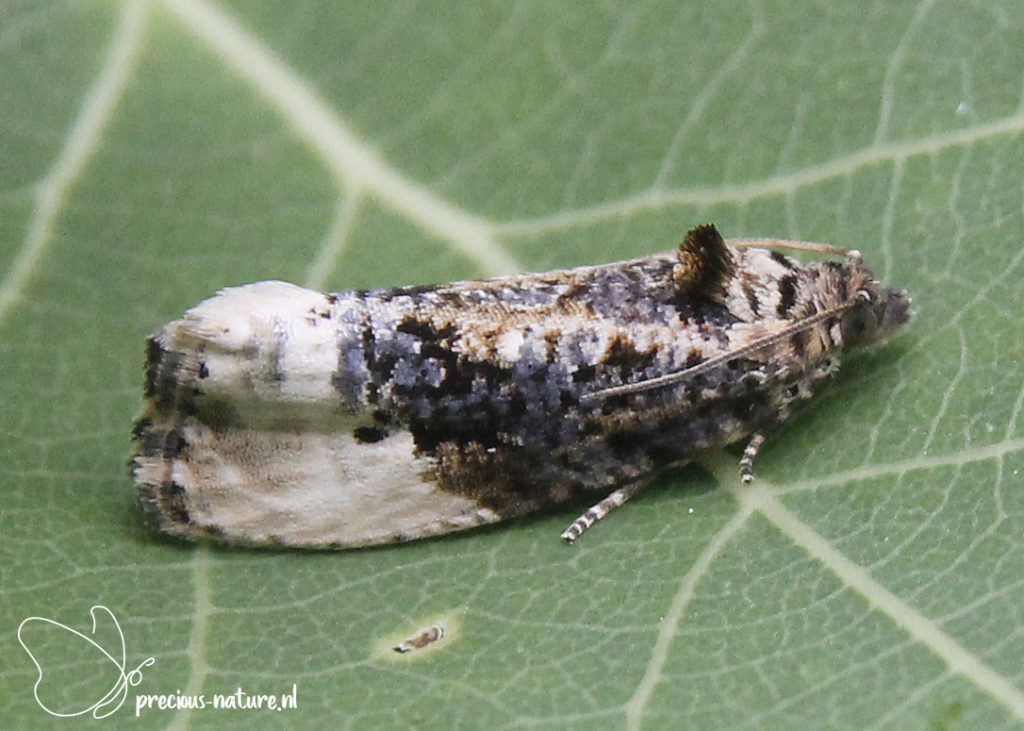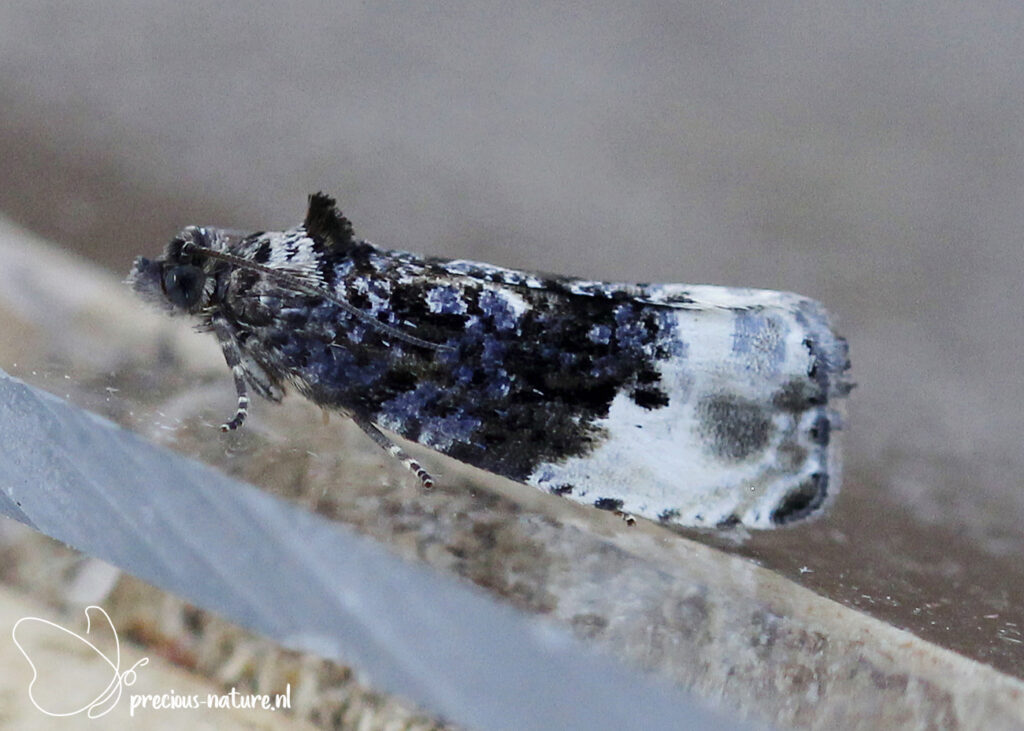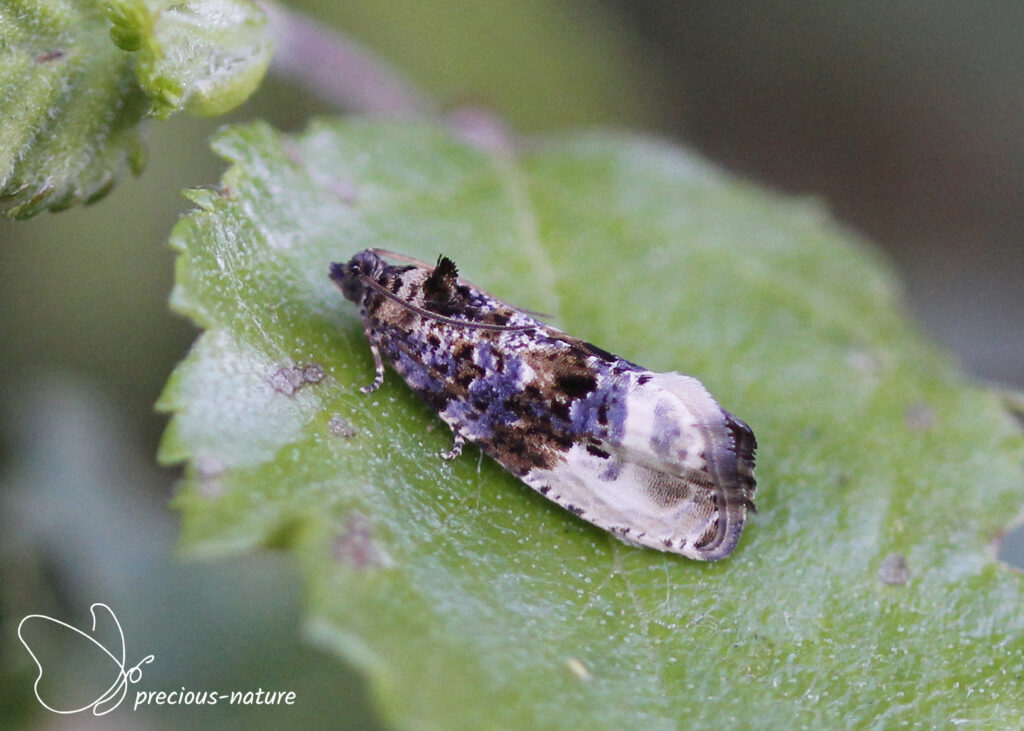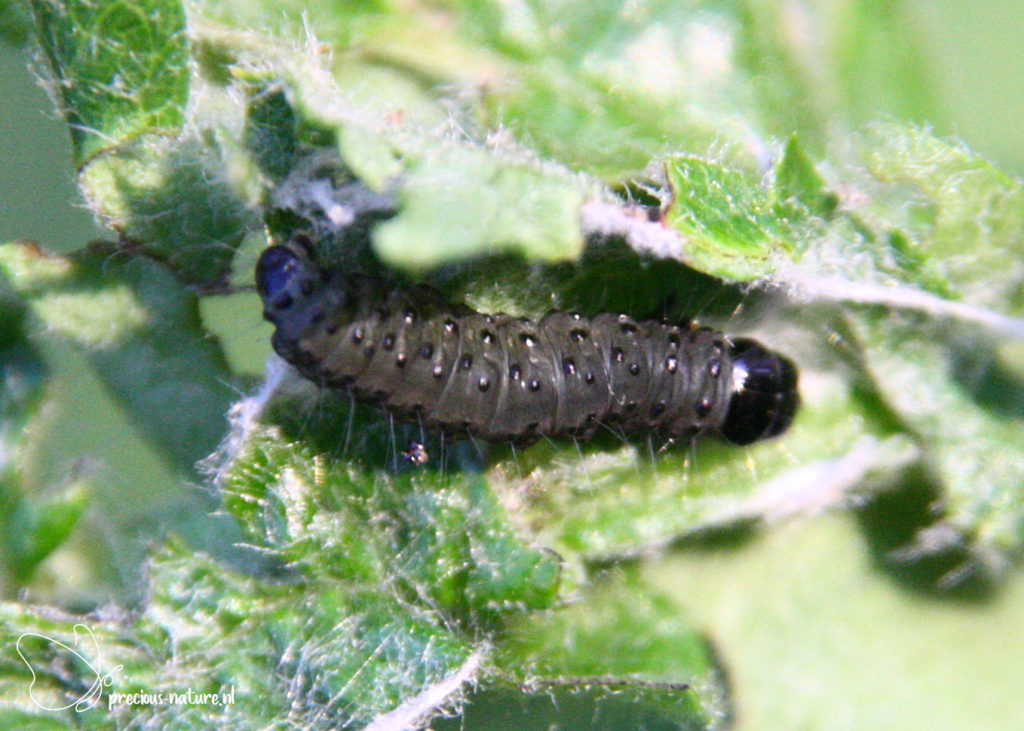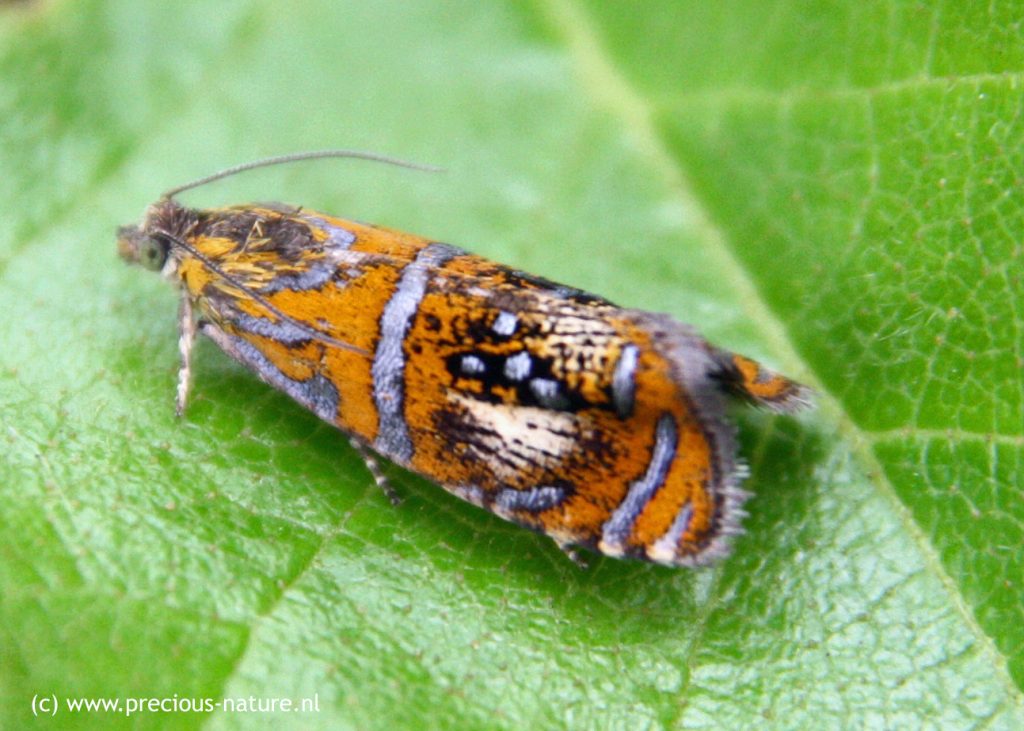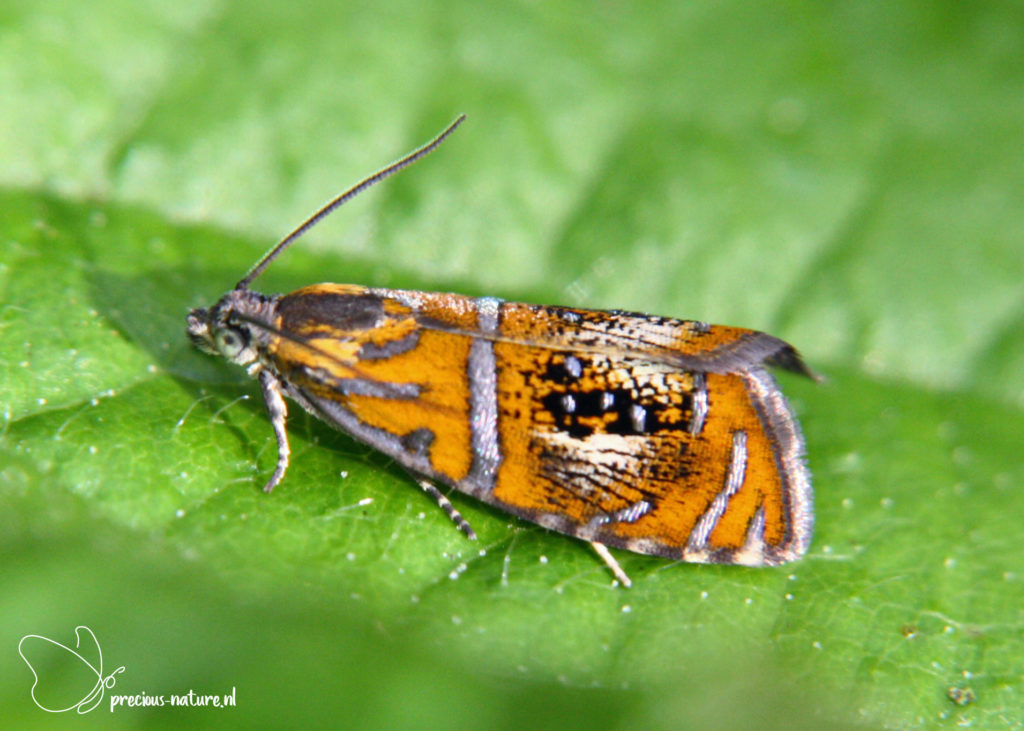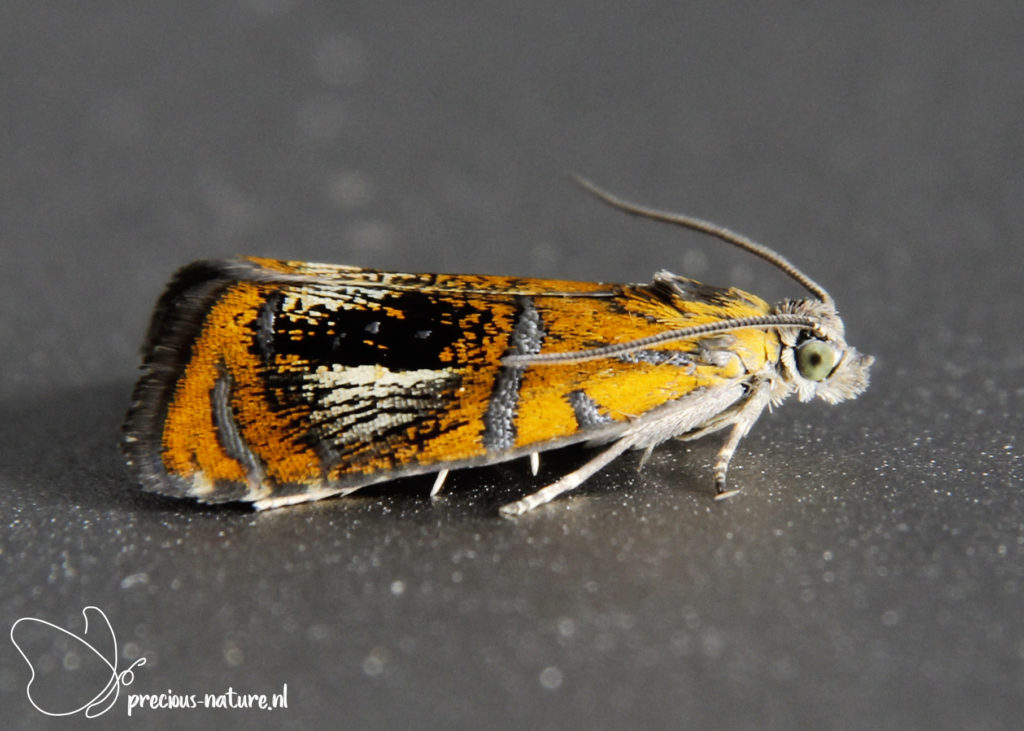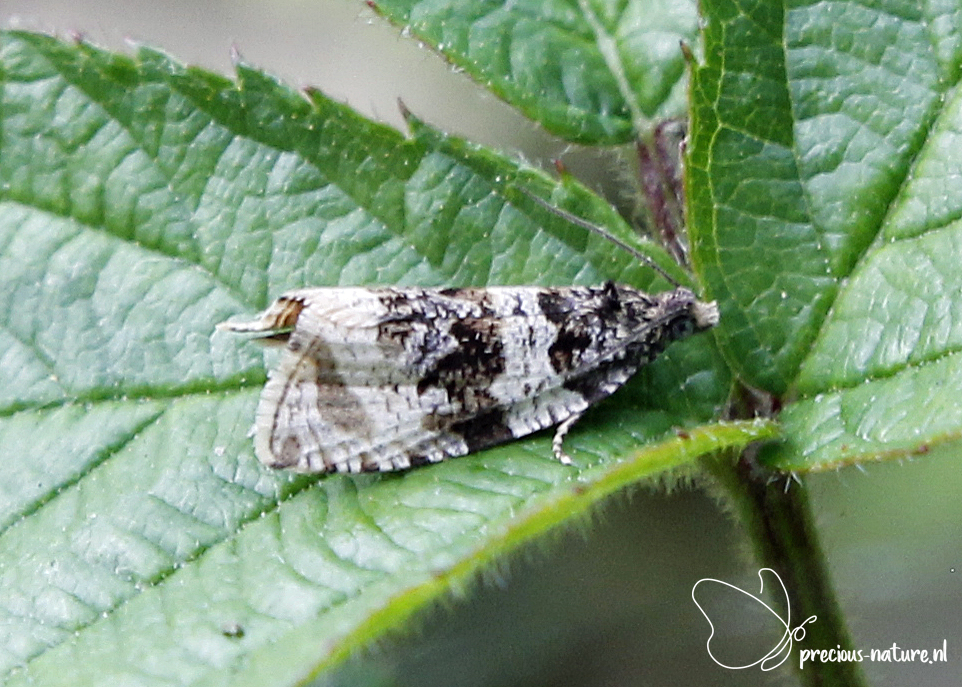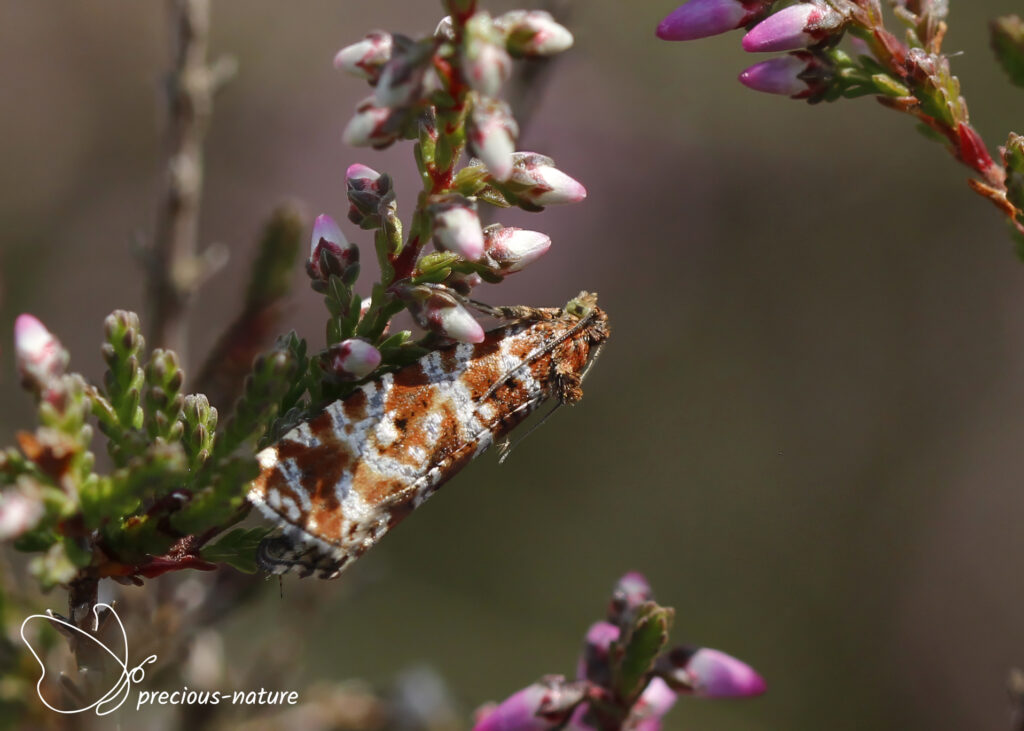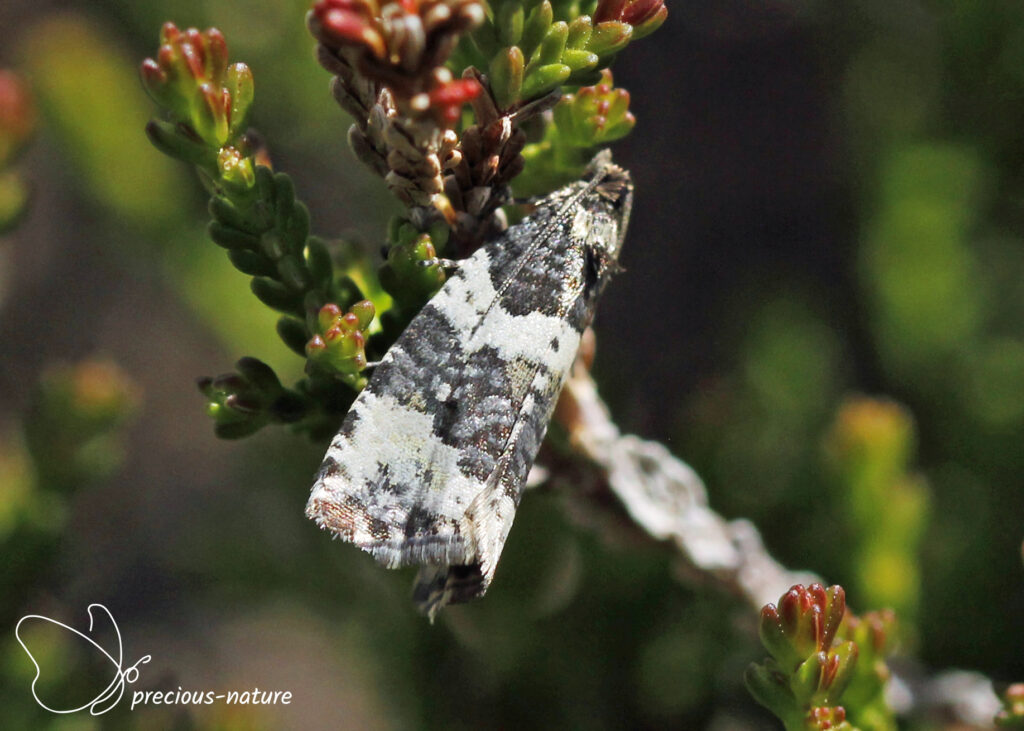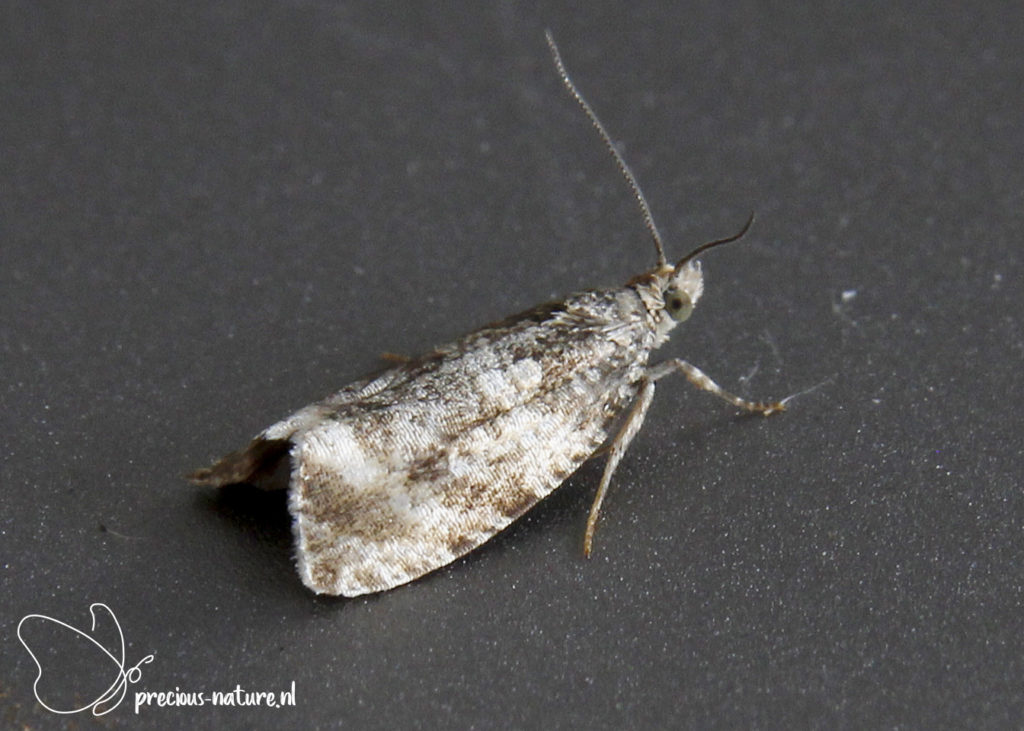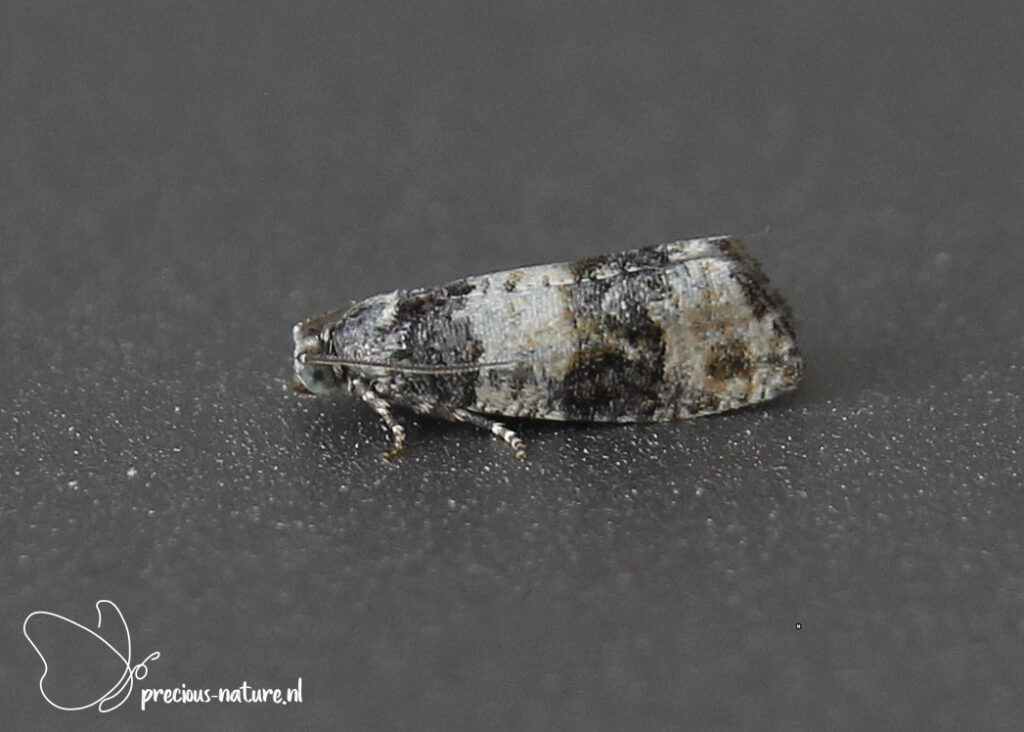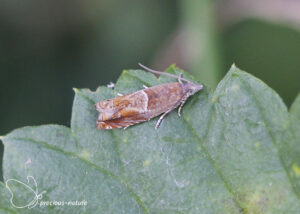The Olethreutinae is a subfamily of the Leafrollers (Tortricidae), of which about 4,400 species have been described worldwide. It is a monophyletic group, a group of organisms that are believed to have shared a common ancestor, which is itself included in the taxon, and all of whose descendants are placed in the same group. The Olethreutinae is a sister group of the Tortricinae. The primary food source is from 1 plant family, with which they are oligophagous. The eggs are laid individually or in small groups. The hatched larvae mainly bore into fruit, roots, stems, and shoots of plants.
Tribe: Bactrini
Genus: Bactra
Rush Marble – 2020 (NL)
(NCBI-index: 753158)
The Rush Marble (Bactra lancealana) is often found in humid environments such as swamps, wet heather, and forests. The forewing is grey to light brown with a net-like structure ranging from very light to almost dark brown. The dark crescent-shaped mark can often be seen at 2/3 of the wing in the middle. Near the apex, a short brown streak can be seen that sometimes extends to the crescent-shaped mark. The flying period spans two generations, from May to October, and the wingspan ranges from 11 to 20 mm. The larvae feed on stems. Host plant: Rushes. Dutch name: Gewone biesbladroller. Frisian name: –
Flying period:

Tribe: Bactrini
Genus: Bactra
Mottled Marble – 2020 (NL)
(NCBI-index: 1.030477)
A species with elongated wings is the Mottled Marble (Bactra furfurana). The forewing is yellowish-brown or orange-brown, with small dark spots scattered across the wing. On 1/3 is a curved transverse band connected to a curved line running down the wing’s centre towards a dark spot at 2/3 near the costa. The flying period in one generation is from June to mid-August, and the wingspan is 13-19 mm. The larvae feed on stems. Host plant: Compact Rush. Dutch name: Getekende biesbladroller. Frisian name: –
Flying period:

Tribe: Enarmoniini
Genus: Ancylis
Triangle-marked Tortrix – 2018 (NL)
(NCBI-index: 1.869464)
A very common leafroller in Europe and a minor pest for apple trees, among others, is the Triangle-marked Tortrix (Ancylis achatana). The forewing is reddish-brown to dark brown with two greyish-white to silvery-grey transverse bands. A thin line connects these two bands. A large, dark brown, triangular spot can be seen on the dorsum of the forewing. The flying period spans from the end of May to September in one generation, and the wingspan ranges from 14 to 18 mm. The larvae spin or roll together leaves and feed within or nearby. Host plant: Hawthorn, Blackthorn, Apple, Blackberry. Dutch name: Dwarsstreephaakbladroller. Frisian name: –
Flying period:

Tribe: Enarmoniini
Genus: Ancylis
Buckthorn Roller – 2019 (NL)
(NCBI-index: 1.391524)
The forewing of the Buckthorn Roller (Ancylis unculana) ends in a small lobe near the apex. The apex appears to be curved. The wing is dark brown and slightly more orange near the apex. Furthermore, a broad off-white or greyish-white transverse band can be seen running from the base at the costa along the edge, bending halfway down the wing over the wing, and then further back along the dorsum. The flying period spans from May to August in one generation, and the wingspan ranges from 12 to 16 mm. The larvae spin a folded leaf together at the edges and feed within. Host plant: Buckthorn, Alder Buckthorn. Dutch name: Purperrode haakbladroller. Frisian name: –
Flying period:

Tribe: Enarmoniini
Genus: Ancylis
Hook-tipped Roller – 2019 (NL)
(NCBI-index: 1.100910)
The Hook-tipped Roller (Ancylis apicella) gets its name from the curvature at the apex. The forewing is pale yellow-brown along the costa and dark brown or mixed dark brown/pale yellow-brown or grey-brown along the dorsum. There is a cream-coloured with a pale brown longitudinal stripe from the base to 3/4 of the wing and then at a narrow angle towards the costa. At least one dark spot is visible in the light part. The flying period spans two generations, from May to September, and the wingspan ranges from 12 to 17mm. The larvae are folding and spinning leaves together. Host plant: Buckthorn, Alder Buckthorn. Dutch name: Fijngestreepte haakbladroller. Frisian name: –
Flying period:

Tribe: Enarmoniini
Genus: Ancylis
Red Roller – 2023 (NL)
(NCBI-index: 909812)
Like its congeners, the Red Roller (Ancylis mitterbacheriana) has a curve near the wing tip that creates a hooked appearance. The forewing is up to one-third dark reddish brown from the base along the inner edge. Then, a thin white line and a lighter zone can be seen as a transition to a light brown zone. Along the leading edge, the white stripes in the dark brown zone are particularly striking at the wing tip. The flight period spans one generation, from late April to mid-July. Adults can sometimes rest on the upper side of a leaf during the day. The wingspan is about 14 mm. Host plant: Oak, Beech. Dutch name: Oranje haakbladroller. Frisian name: –
Flying period:

Tribe: Enaroniini
Genus: Ancylis
Meadow Hook-wing – 2024 (CH)
(NCBI-index: 1.594232)
You must pay close attention to the forewing pattern to identify the Meadow Hook-wing (Ancylis badiana). It looks very similar to the Fen Roller (Ancylis paludana). The Meadow Hook-wing is darker and has a narrower cream-coloured band along the leading edge. A striking difference is the number of black dots at the base of the fringe line near the wing tip. This is never more than 1 in the Meadow Hook-wing, while in the Fen Roller, this is 3 or 4. The forewing ends in a broad lobe, which makes it look like a hook. From above, you can see the dark brown triangle with the point close to the head and the base halfway along the wing. The flight period is two generations from April to October, and the wingspan is 12-16 mm. Host plant: Vetch, Clover. Dutch name: Bonte haakbladroller. Frisian name: –
Flying period:

Tribe: Endotheniini
Genus: Endothenia
Teasel Marble – 2017 (NL)
(NCBI-index: 1.869845)
The Teasel Marble (Endothenia gentianaeana) is a leafroller that is very difficult to distinguish from the other Endothenia spp. and requires dissection of the genitalia for accurate identification. The wings are blue-grey with two dark transverse bands on top. The outer zone is white. The flight time is from June to August in one generation, and the wingspan is 15-19 mm. The larvae feed singly on the pith in the cavity of the teasel seedhead. Host plant: Teasel. Dutch name: Kaardebolbladroller. Frisian name: –
Flying period:

Tribe: Eucosmini
Genus: Epiblema
Thistle Bell – 2017 (NL)
(NCBI-index: 1.100980)
The Thistle Bell (Epiblema scutulana) is a moth that is very difficult to distinguish from the Southern Thistle Bell. It is a reasonably dark moth with a noticeable white spot in the centre of the wings. This is best seen when the moth is in a resting position. It looks like a saddle to which it owes its Dutch name. In some specimens, you can see that the white spot is more of a white band. Flight time is from May to June in one generation, and the wingspan is 18-23mm. The larvae live in the stems and roots. Host plant: Musk Thistle, Spear Thistle. Dutch name: Distelzadelmot. Frisian name: –
Flying period:

Tribe: Eucosmini
Genus: Epiblema
White-foot Bell – 2020 (NL)
(NCBI-index: 1.100979)
The most striking thing about the White-foot Belle (Epiblema foenella) is the white, sometimes grey, curved spot near the dorsum. Above, it looks like a white horseshoe or bell on the purple-brown forewing to red-brown forewing. Near the tornus is a pale round spot with often three or four black or brown dots. Sometimes, the white marking is also missing. The flying period is from the end of June to September in one generation, and the wingspan is 17-26 mm. Larvae feed on the roots and stems of the host plant. Host plant: Mugwort. Dutch name: Hoefijzermot. Frisian name: –
Flying period:

Tribe: Eucosmini
Genus: Epinotia
Crescent Bell – 2020 (NL)
(NCBI-index: 1.594293)
The Crescent Bell (Epinotia bilunana) is almost entirely cream-white or grey-white and otherwise sparsely speckled with black. At the dorsum at 1/3, a black spot could be seen that is dark and sharply drawn at the end. Just before the tornus is another striking black spot. The flying period spans from July to October in one generation, and the wingspan ranges from 13 to 17 mm. The larvae feed on the catkins of a birch tree. Host plant: Birch. Dutch name: Witte oogbladroller. Frisian name: –
Flying period:

Tribe: Eucosmini
Genus: Epinotia
Willow Tortrix – 2020 (NL)
(NCBI-index: 1.666554)
The orange-brown or red-brown colour on the forewings of the beautiful Willow Tortrix (Epinotia cruciana) makes this species easy to recognise. Halfway down the forewing is a light cross band that stands out compared to the light brown base. At the costa, close to the apex, is a white spot that can vary in size. The flying period is from May to early August in one generation, and the wingspan is 12-15 mm. The larvae feed on spun leaves. Host plant: Willow. Dutch name: Fraaie oogbladroller. Frisian name: –
Flying period:

Tribe: Eucosmini
Genus: Epinotia
Brown Elm Bell – 2023 (NL)
(NCBI-index: 1.594292)
Contrary to what one might initially think based on the Dutch name, it has nothing to do with the colour of the eyes. The “eye” refers to a dark spot on the forewing near the wing tip. This is often brown, black, or dark orange, such as for the Brown Elm Bell (Epinotia abbreviana). The Brown Elm Bell is variable in colour and markings. The forewing is orange-brown to dark red-brown with a creamy white or yellow-brown transverse band on a 1/3, making an acute angle inward halfway. Another narrow white band runs towards the leading edge from the inner edge corner, covered with silver-coloured scales. At the leading edge, you can also see several paired white bands that are particularly noticeable near the wing tip. The flight period spans one generation, from May to August, and the wingspan ranges from 12 to 16 mm. Host plant: Elm. Dutch name: Oranje oogbladroller. Frisian name: –
Flying period:

Tribe: Eucosmini
Genus: Epinotia
Nut Bud Moth – 2025 (NL)
(NCBI-index: 1.660628)
In areas where hazel and alder grow, you can also encounter the Nut Bud Moth (Epinotia tenerana). It is a pretty common species in the Netherlands. The forewing is orange-brown or dark brown, suffused with yellow-brown, with a whitish square spot with fine brownish lines on the back at about half the height. The inner edge of the white spot is sharply defined and almost perpendicular to the back. The spot is sometimes diagonally connected to a whitish spot at the front edge to form a transverse band, which is constricted in the middle. The ocellus is weak and contains three or four black stripes; these are often reduced or absent. One form is unclearly marked, with the whitish colour replaced by light orange-brown. The flight period is one generation from mid-June to late September, and the wingspan is 12-16 mm. Host plant: Hazel, Alder. Dutch name: V-oogbladroller. Frisian name: –
Flying period:

Tribe: Eucosmini
Genus: Eucosma
Hoary Bell – 2020 (NL)
(NCBI-index: 1.100988)
The Hoary Bell (Eucosma cana) has a grey-brown to dark brown forewing with white-brown or yellow-brown spots. Along the costa, a brown streak can be seen from the base to the middle of the wing. Three small brown spots can be seen towards the apex. From the costa, a brown median band runs halfway across the wing towards the dorsum. The flying period spans from May to August in one generation, and the wingspan ranges from 16 to 23 mm. The larvae feed on the flower buds and seeds of the host plant. Host plant: Thistle, Common Knapweed. Dutch name: Distelknoopvlekje. Frisian name: –
Flying period:

Tribe: Eucosmini
Genus: Gypsonoma
Common Cloaked Shoot – 2019 (NL)
(NCBI-index: 1.594308)
A leafroller variable in colour is the Common Cloaked Shoot (Gypsonoma dealbana) that just perched on the leaves of the butterfly bush on a summer evening. The head of this leafroller is brown, sometimes mixed with some grey-white. The forewing is white with a dark grey base and black spots. At 2/3, a clear black line is in the middle of the wing. There are orange-brown spots at the apex. The flying period spans from May to August in one generation, and the wingspan ranges from 11 to 14 mm. The larvae feed on a range of deciduous trees, feeding on leaves in autumn and eating the buds, catkins, young shoots, and then spinning leaves in the spring. Host plant: Hawthorn, Oak, Poplar, Sallow, Hazel. Dutch name: Loofboombladroller. Frisian name: –
Flying period:

Tribe: Eucosmini
Genus: Notocelia
Yellow-faced Bell – 2018 (NL)
(NCBI-index: 1.101023)
The most striking thing about the Yellow-faced Bell (Notocelia cynosbatella) is the palps, which have a yellow-to-orange colour. One-third of the forewing is black to brownish, and the rest is creamy white with occasional light grey or brown blotches. At the end of the wings is a narrow strip that is grey-brown. The flying period in one generation is from May to July, and the wingspan is 16-22 mm. Larvae feed on flower buds, young shoots, or between leaves. Host plant: Roses, Bramble. Dutch name: Hermelijnbladroller. Frisian name: –
Flying period:

Tribe: Eucosmini
Genus: Notocelia
Bramble Shoot Moth – 2020 (NL)
(NCBI-index: 1.594315)
The Bramble Shoot Moth (Notocelia uddmanniana) is easily recognised by the dark brown arc-shaped spot on the dorsum of the otherwise grey forewing. This dark brown spot is outlined in white. At 1/3 is a dark grey band that extends towards the costa. A dark grey band can be seen along the costa, which slowly deflects to the brown spot. A light brown zone can be seen along the termen. The flying period is from mid-May to October, and the wingspan is 15-20 mm. The larvae feed on an untidy spinning. Host plant: Blackberry, Raspberry. Dutch name: Bramenbladroller. Frisian name: –
Flying period:

Tribe: Eucosmini
Genus: Notocelia
Common Rose Bell – 2021 (NL)
(NCBI-index: 1.594313)
The forewing of the Common Rose Bell (Notocelia roseacolana) is white and partly spotted with lead grey, especially the wing base. Along the leading edge from the wingtip to halfway, you see dark grey triangular spots with narrow grey, sometimes light brown, narrow lines in between. In the marginal area is a row of tiny black dots. A brown spot is faintly visible in the grey spot near the trailing edge, and a black spot is on the edge of this grey spot. The Common Rose Bell is similar to the Triple-blotched Bell (Notocelia trimaculana), but is usually larger and has a broader forewing. In addition, the forewing is often paler in colour, and the spots at the leading edge are finer and more oblique. The wingspan is 15-20 mm, and the flight period spans one generation, from late May to August. Host plant: Hawthorn. Dutch name: Rozenhermelijnbladroller. Frisian name: –
Flying period:

Tribe: Eucosmini
Genus: Notocelia
Summer Rose Bell – 2021 (NL)
(NCBI-index: 1.101024)
The Summer Rose Bell (Notocelia roborana) is very similar to the Common Rose Bell (Notocelia roseacolana), but is larger and has fewer grey spots and black markings in the forewing. The base of the forewing is grey, with the grey surface sloping slightly away and then bending with an arc to the leading edge. With the Common Rose Bell, it is more linear. Along the trailing edge near the tornus is a dark grey spot with a black spot. The wingspan is 18-21 mm, and the flight period runs in one generation from mid-June to August. Host plant: Roses. Dutch name: Scherpe hermelijnbladroller. Frisian name: –
Flying period:

Tribe: Eucosmini
Genus: Notocelia
Square-spot Bell – 2024 (CH)
(NCBI-index: 1.594314)
The forewing of the Square-spot Bell (Notocelia tetragonana) is relatively broad and is black-brown with blue-grey metallic reflections and a scattering of yellow-brown scales. This is mainly visible in the outer half of the wing. A striking, angular white spot can be seen halfway along the inner edge of the wing. The flight period is one generation from June to July, and the wingspan is 13-16 mm. Host plant: Wild Rose, Bramble. Dutch name: Vierkantvlekbladroller. Frisian name: –
Flying period:

Tribe: Eucosmini
Genus: Rhopobota
Holly Tortrix – 2017 (NL)
(NCBI-index: 572892)
The Holly Tortrix (Rhopobota nirvana) has a light grey or light brown ground colour with two wider cross bands on the top that are darker. Flight time is from July to September in one generation, and the wingspan is 12-16 mm. Host plant: Blackthorn, Hawthorn, Holly, Bilberry. Dutch name: Topspinnertje. Frisian name: –
Flying period:

Tribe: Eucosmini
Genus: Rhyacionia
Pine Shoot Moth – 2019 (NL)
(NCBI-index: 1.101046)
The Pine Shoot Moth (Rhyacionia buoliana) has an easily identifiable and striking appearance. This leafroller is very similar to the Orange-spotted Shoot (Rhyacionia pinicolana). Still, when you look closely at the irregular white line pattern, the Pine Shoot Moth shows an arc-shaped drawing at the end of the costa that does not continue to the centre. With the Orange-spotted Shoot, that white line continues to the apex. The forewing is otherwise bright orange, sometimes drenched with yellow-brown or reddish-brown. The flying period spans from June to August in one generation, and the wingspan ranges from 16 to 24 mm. Larvae bore into the shoots. Host plant: Scots Pine. Dutch name: Gewone dennenlotboorder. Frisian name: –
Flying period:

Tribe: Eucosmini
Genus: Spilonota
Bud Moth – 2018 (NL)
(NCBI-index: 572898)
The Bud Moth (Spilonota ocellana) is a leafroller that is difficult to distinguish from the Larch-bud Moth (Spilonota laricana). A genitalia examination is needed, but it can be recognised because the Bud Moth has narrower forewings, is greyer, and has more black spots. The forewing of the Bud Moth is white, sometimes a pale yellow-brown with a grey diffuse colour. From the base, the forewings are black-brown up to a third and white for the rest. Usually, there is a black triangular mark near the apex. Lead grey spots can be seen from the apex to the dorsum. When resting, you can see a dark mark from above after those grey markings. The flying period in one generation is from May to September, and the wingspan is 12-17 mm. The larvae feed on a wide range of shrubs and trees and, as the English name suggests, burrow into the buds during the spring, causing them to wither. Host plant: Oak, Apple, Hawthorn, Sallow. Dutch name: Rode knopbladroller. Frisian name: –
Flying period:

Tribe: Eucosmini
Genus: Zeiraphera
Cock’s-head Bell – 2021 (NL)
(NCBI-index: 1.101070)
The Cock’s-head Bell (Zeiraphera isertana) is very similar to the Larch Tortrix (Zeiraphera griseana). The difference is in the light blotch halfway down the wing on the dorsum that extends towards the costa. With the Cock’s-head Bell, that spot never extends past the centre, whereas the spot on the Larch Tortrix goes past it. In addition, the Cock’s-head Bell is somewhat smaller and has shorter wings. The forewing is otherwise black or black-brown with white or grey markings. The flight period is one generation from May to September, and the wingspan is about 17 mm. Host plant: Oak. Dutch name: Grootkopbladroller. Frisian name: –
Flying period:

Tribe: Grapholitini
Genus: Cydia
Codling Moth – 2017 (NL)
(NCBI-index: 82600)
The Codling Moth (Cydia pomonella), also called Apple Leafroller, has a grey forewing with thin brownish transverse lines. On the outside, this leafroller has a coppery or gold-coloured eye with a triangular black stripe in the centre. The Codling Moth is responsible for the worm-eaten apples and pears. That is why the apples on the fruit tree in my garden often have these weird spots. The flying time is sometimes two generations from May to October, and the wingspan is 14-22 mm. The caterpillars feed on the fruits of apple, quince, pear, and other wild and cultivated fruits. Host plant: Apple, Pear. Dutch name: Fruitmot. Frisian name: –
Flying period:

Tribe: Grapholitini
Genus: Cydia
Pea Moth – 2020 (NL)
(NCBI-index: 753170)
One species to be aware of to avoid confusing it with a species from another genus is the Pea Moth (Cydia nigricana). It is very similar to the Deep-brown Piercer (Grapholita tenebrosana). Both have a uniform forewing that is grey-brown to dark brown and sometimes yellow-grey. Near the costa, close to the apex, you see a few short white stripes alternating with black patches. The hindwing of the Pea Moth is dark brown with contrasting white fringes. The Deep-brown Piercer has a pale grey-brown hindwing, and the white stripes at the costa are less pronounced. The palps of the Pea Moth are mottled pale brown or dark grey on top and white on the underside. The Deep-brown Piercer they are entirely white. The flying period spans from May to August in one generation, and the wingspan ranges from 12 to 16 mm. The larvae feed in the pods. Host plant: Pea. Dutch name: Erwtenbladroller. Frisian name: –
Flying period:

Tribe: Grapholitini
Genus: Cydia
Rusty Oak Moth – 2020 (NL)
(NCBI-index: 1.869771)
The forewing of the Rusty Oak Moth (Cydia amplana) is orange-brown, dark brown at the apex on the dorsum, and a cream-coloured dorsal spot halfway. Alternating light and dark short stripes can be seen along the costa. The flying period spans from July to early October in one generation, and the wingspan ranges from 16 to 20 mm. The larvae feed on nuts. Host plant: Oak, Walnut, Beech, Hazel. Dutch name: Oranje eikenbladroller. Frisian name: –
Flying period:

Tribe: Grapholitini
Genus: Cydia
Marbled Piercer – 2024 (NL)
(NCBI-index: 1.100963)
The chestnut tree offers enormous economic, social, cultural, and ecological benefits in some countries, such as Portugal, and also contributes to the characteristic landscape. The Marbled Piercer (Cydia splendana) is considered a serious agricultural pest and affects the quality and quantity of chestnut fruits. The wing root of the forewing is speckled with greyish. Halfway along the wing runs a greyish-white transverse band that narrows slightly in the middle. The eye cell is large, flanked by a metallic lead spot, and contains four or five black stripes. From the inner edge corner, a black spot in the shape of a triangle runs along the inside of the eye cell. The flight period spans one generation, from July to early October, and the wingspan ranges from 12 to 16 mm. Host plant: Oak, Sweet Chestnut, Walnut. Dutch name: Gewone spiegelmot. Frisian name: –
Flying period:

Tribe: Grapholitini
Genus: Dichrorampha
Sharp-winged Drill – 2019 (NL)
(NCBI-index: 1.869808)
A leafroller that, at first glance, has a bit of a grey appearance but, on closer inspection, still has a variety of stripes and colours. The Sharp-winged Drill (Dichrorampha acuminatana) has a forewing that is dark brown, sometimes with a light purple or pink glow. Furthermore, the wing is dotted with a faint yellow-brown, broad brown-white, almost triangular spot. There are three to six black dots on the termen, and the fringes are glossy dark grey with a central white band. The caterpillar feeds on the root of its host plant and is, therefore, not a leafroller in its name. The flying period spans two generations, from April to September, and the wingspan ranges from 10 to 15 mm. The larvae burrow into the rootstock and feed within. Host plant: Daisy. Dutch name: Margrietwortelmot. Frisian name: –
Flying period:

Tribe: Grapholitini
Genus: Dichrorampha
White-spot Yarrow Moth – 2024 (CH)
(NCBI-index: 1.211811)
With much effort and patience, it was finally possible to get a good picture of the White-spot Yarrow Moth (Dichrorampha ligulana). The base colour of the forewing is olive green to clay yellow. From the root tip, the number of dark-coloured spots becomes closer. Lead-grey shiny spots can be seen in the zoom field. Striking features are the black dots along the rear edge, the white spots along the front edge and the irregular white spot halfway along the wing that runs from the inner edge to halfway along the wing. The hindwings are plain brown. The flight period is from April to September, and the wingspan is 13-16 mm. Host plant: Wormwood, Yarrow. Dutch name: Witvlekwortelmot. Frisian name: –
Flying period:

Tribe: Grapholitini
Genus: Pammene
Acorn Piercer – 2017 (NL)
(NCBI-index: 1.101027)
The Acorn Piercer (Pammene fasciana) has a white ground colour with a transverse band of small silver-grey stripes on the inside of the wing and a brown colour on the outside. The flight time is from June to August, and the wingspan is 13-17 mm. The larvae feed internally in the oak acorns and sweet chestnut nuts. Host plant: Oak, Sweet Chestnut. Dutch name: Gewone dwergbladroller. Frisian name: –
Flying period:

Tribe: Grapholitini
Genus: Pammene
Sycamore Piercer – 2020 (NL)
(NCBI-index: 1.870148)
In the summer, I regularly walk past the plants in my garden to spot micro-moths. Sometimes, you are lucky, and you suddenly see a new species. This was also the case with the Sycamore Piercer (Pammene aurita). This leafroller is predominantly brown to orange-brown with a large pale yellow spot at the dorsum halfway up the forewing. The tornus is darker in colour, and short white spots can be seen along the costa. The flying period spans one generation, from July to September, and the wingspan measures 14-15 mm. The larvae feed on silk in buds. Host plant: Sycamore. Dutch name: Morgenroodbladroller. Frisian name: –
Flying period:

Tribe: Grapholitini
Genus: Pammene
Pigmy Y Piercer – 2023 (NL)
(NCBI-index: 1.858052)
In the summer, I often walk in a nature reserve after dinner. If you pay close attention, you will usually come across micro butterflies that emerge from their hiding place at dusk. A striking appearance is the poplar dwarf leafroller (Pammene populana) because of its large white spot on the otherwise predominantly dark brown forewing. The white spot at the inner edge is edged with a dark band. A pair of short cream-coloured bands can be seen along the leading edge. The flight period spans one generation, from July to mid-September, and the wingspan ranges from 10 to 13 mm. Host plant: Willow. Dutch name: Populierendwergbladroller. Frisian name: –
Flying period:
![]()
Tribe: Olethreutini
Genus: Apotomis
Birch Marble – 2018 (NL)
(NCBI-index: 1.100915)
The Birch Marble (Apotomis betuletana) is similar to the Willow Marble (Apotomis capreana). From the wing base, the front wing is 2/3 black-brown mixed with lead-coloured and black spots. The other part of the forewing is white with a yellow-brown spot. The difference between the Birch Marble and the Willow Marble is best seen from the top view. The Birch Marble shows a light grey line shaped like a fishhook in the dark part. Furthermore, the two black spots on the border of the dark and white part of the Birch Marble are much darker than those on the Willow Marble. The flying period spans from June to September in one generation, and the wingspan ranges from 16 to 20 mm. The larvae are spinning and rolling leaves together. Host plant: Birch. Dutch name: Berkenmarmerbladroller. Frisian name: –
Flying period:

Tribe: Olethreutini
Genus: Celypha
Barred Marble – 2015 (NL)
(NCBI-index: 1.030481)
The Barred Marble (Celypha striana) has a light grey-brown ground colour, and its dark median band distinguishes it from the other Celypha spp. There is also a second angled dark band close to the apex. This leafroller flies from dusk from June to August, and its wingspan is 16-22 mm. In the first instance, the larvae are under a silken web on the surface of the taproot, later in the roots. Host plant: Dandelion. Dutch name: Paardenbloembladroller. Frisian name: –
Flying period:

Tribe: Olethreutini
Genus: Celypha
Common Marble – 2017 (NL)
(NCBI-index: 1.594247)
The Common Marble (Celypha lacunana) is very variable in colour shade but can often be recognised by the indentation or fading of the dark transverse band. This leafroller flies at night and is attracted to light. Flight time is in two generations, from May to August, and the wingspan is 16-18 mm. The larvae feed on various plants in spun leaves, shoots, and flowers. Host plant: Beech, Birch, Willow, Nettle. Dutch name: Brandnetelbladroller. Frisian name: –
Flying period:

Tribe: Olethreutini
Genus: Celypha
Sprout Marble – 2022 (NL)
(NCBI-index: 2.561072)
Even though the drawing of the Sprout Marble (Celypha siderana) is quite striking, I still had to search hard to identify this leaf roller. Silver-grey spots spread over the forewing can be mainly used as an essential characteristic. The forewing is also yellow-brown with many black narrow transverse lines and large black spots varying in size. The legs are ringed alternately yellow and brown. The flight period is one generation, from the beginning of June to the end of July, and the wingspan is 14-18 mm. Host plant: Meadowsweet. Dutch name: Kristalbladroller. Frisian name: –
Flying period:

Tribe: Olethreutini
Genus: Celypha
Lakes Marble – 2023 (NL)
(NCBI-index: 1.030480)
The Lakes Marble (Celypha rufana) can be recognised by a network of thin red-brown lines on the forewing, which can be yellow-brown to dark grey-brown. This pattern of lines is most noticeable in the outer half of the wing. There is a dark spot near the inner edge corner. The flight period spans one generation, from May to early August, and the wingspan ranges from 16 to 19 mm. Host plant: Tansy, Mugwort. Dutch name: Smallijnbladroller. Frisian name: –
Flying period:

Tribe: Olethreutini
Genus: Eudemis
Diamond-back Marble – 2022 (NL)
(NCBI-index: 1.100989)
The forewing of the Diamond-back Marble (Eudemis profundana) is white ground with various brown to black-brown spots. Halfway through the wing, a lighter brown broad transverse band can be seen that extends from the leading edge to the trailing edge, where a bright white spot can be seen. This geometer moth owes its English name to this. The similar Apple Marble (Eudemis porphyrana) has a greyer ground colour with uniform brown spots and lead-grey markings. The flight period spans one generation, from July to early September, and the wingspan ranges from 14 to 20 mm. Host plant: Oak. Dutch name: Bonte fruitbladroller. Frisian name: –
Flying period:

Tribe: Olethreutini
Genus: Hedya
Buff-tipped Marble – 2018 (NL)
(NCBI-index: 989781)
It can sometimes be challenging to distinguish certain types of leafrollers. At first, I was convinced that the spotted leafroller belonged to the Apotomis family. Still, after careful study and with the help of literature, I came to the Hedya species, Off-white Hedya (Hedya ochroleucana). This leafroller has a striking cream-coloured outer side of the forewing with a few light brown spots along the edge and a few small black dots in the pace itself. These light brown spots fade in colour over time, but this leafroller can still be recognised by the two dark stripes in the outer two spots. Two-thirds of the forewing is dark brown, mixed with blue-grey and black surfaces. The flying period spans from June to September in one generation, and the wingspan ranges from 16 to 21 mm. Larvae are spinning leaves together. Host plant: Rose, Apple. Dutch name: Grote witvlakbladroller. Frisian name: –
Flying period:

Tribe: Olethreutini
Genus: Hedya
Marbled Orchard Tortrix – 2018 (NL)
(NCBI-index: 572853)
A leafroller that belongs to the white surface leafrollers is the ordinary Marbled Orchard Tortrix (Hedya nubiferana). The forewing is about 2/3 dark brown or dark yellow-brown mixed with blue-grey and black spots from the base. The other 1/3 towards the apex is white with pale grey or grey-brown streaks. The flying period in one generation is from May to August, and the wingspan is 15-21 mm. Larvae feed on spun flowers, leaves, and shoots. Host plant: Oak, Hawthorn, Blackthorn. Dutch name: Gewone witvlakbladroller. Frisian name: –
Flying period:

Tribe: Olethreutini
Genus: Olethreutes
Arched Marble – 2018 (NL)
(NCBI-index: 1.109078)
A very striking appearance is evident when you later enlarge the photos on your laptop, particularly the Arched Marble (Olethreutes arcuella). The orange base colour of the wings with the silver-blue transverse lines is particularly striking when you encounter this leafroller in the field resting on a green leaf. Immediately after the front transverse band, a light yellow spot with black shading and some silver-blue spots appear. The orange colour can be seen as the colour of the dress of a Japanese geisha, and the silver-blue stripes are the spokes of the parasol that she spins. The Arched Marble flies in one generation from May to August, and the wingspan is 14-18 mm. Host plant: Fallen leaves and plant remains. Dutch name: Geisha. Frisian name: –
Flying period:

Tribe: Olethreutini
Genus: Orthotaenia
Woodland Marble – 2020 (NL)
(NCBI-index: 1.594318)
The Woodland Marble (Orthotaenia undulana) is similar to the Common Marble (Celypha lacunana). The big difference is in the dark median band halfway up the forewing. With the Woodland Marble, this is an entirely dark band, but with the Common Marble, the pre-median cream-white band runs through the dark cross band in the middle, like a kind of finger. Furthermore, the apical zone of the Woodland Marble is lighter in colour, and the dark markings are more prominent. The larvae feed on leaves that are spun together. The flying period spans one generation, from May to August, and the wingspan ranges from 15 to 20 mm. Host plant: Birch, Honeysuckle, Billberry. Dutch name: Woudbladroller. Frisian name: –
Flying period:

Tribe: Olethreutini
Genus: Phiaris
Large Marble – 2023 (NL)
(NCBI-index: 1.594330)
Because of the clouds, staying in the heathland of a beautiful nature reserve was still pleasant, but as soon as the clouds disappeared, the temperature rose quickly. The disadvantage is that insects are also more active and cannot be photographed easily. This also applies to the granite leaf roller (Phiaris schulziana), but with a lot of patience, I eventually succeeded. With its reddish-brown forewings with black speckles, thin white transverse bands, and small dots, this micromoth is almost unnoticeable. The flight period spans one generation, from June to August, and the wingspan ranges from 17 to 25 mm. Host plant: Heather, Crowberry. Dutch name: Granietbladroller. Frisian name: –
Flying period:

Tribe: Olethreutini
Genus: Phiaris
Blueberry Tortrix – 2024 (CH)
(NCBI-index: 1.101140)
In the Netherlands, the Blueberry Tortrix (Phiaris bipunctana) is almost non-existent. It could be found on sandy soils in Gelderland and Overijssel. I have found this species in the Swiss Alps. The white forewing with sometimes somewhat yellowish irregular spots is black with grey spots at the wing root. The black runs diagonally from the leading edge across the wing inwards, bending towards the trailing edge to the inner edge corner. Halfway along the wing is a broad black transverse band with grey lead spots. The hind wings are dark grey but dull in colour. The flight period is from May to July, and the wingspan is 14-21 mm. Host plant: Blueberry, Red Blueberry, Rhododendron, Wintergreen. Dutch name: Tweepuntige lijnbladroller. Frisian name: –
Flying period:

Tribe: Olethreutini
Genus: Piniphila
Pine Marble – 2019 (NL)
(NCBI-index: 1.101145)
The first spot of the Pine Marble (Piniphila bifasciana) was at night when it was attracted to light. This leafroller has a brown-grey forewing with two broad white cross bands. One band is 1/3 of the wing, and one is close to the apex. The bands are usually grey-white or yellow-brown and sometimes orange to pink, especially the band close to the wingtip. The flying period in one generation is from June to August, and the wingspan is 12-16 mm. The larvae feed in a silken gallery among the young shoots and male flowers. Host plant: Scotch Pine. Dutch name: Tweebandbladroller. Frisian name: –
Flying period:


